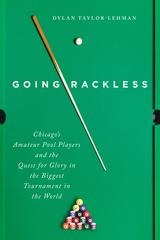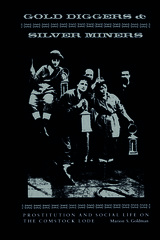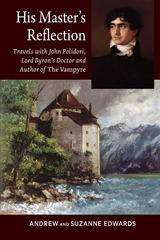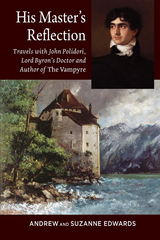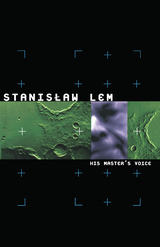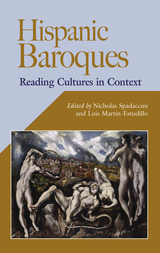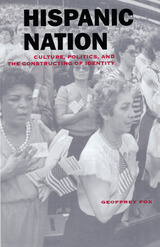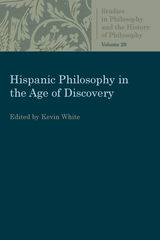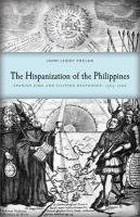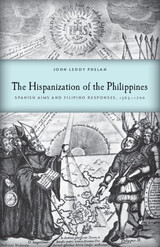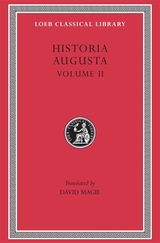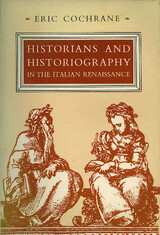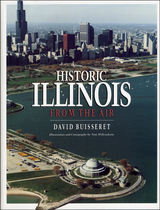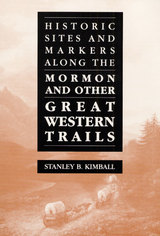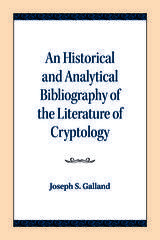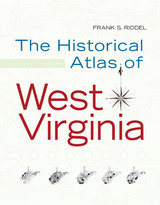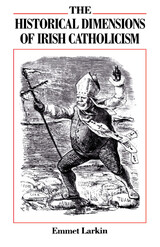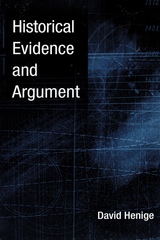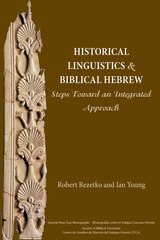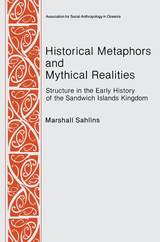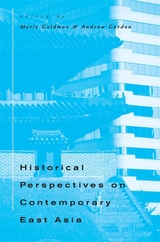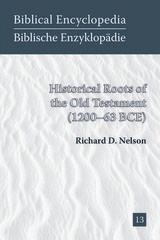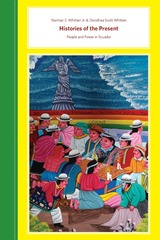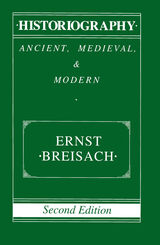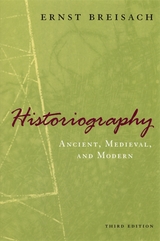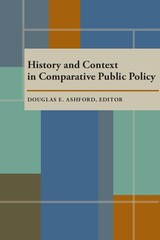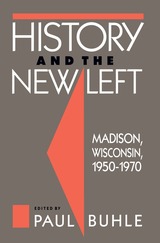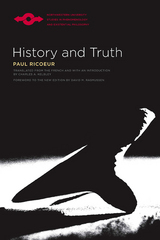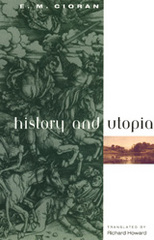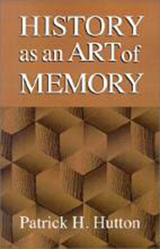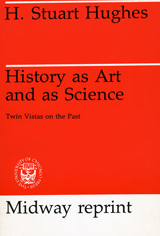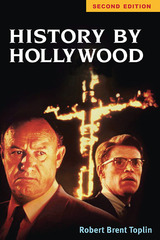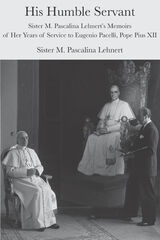 His Humble Servant: Sister M. Pascalina Lehnert's Memoirs of Her Years of Service to Eugenio Pacelli, Pope Pius XII
M. Pascalina Lehnert
St. Augustine's Press, 2012 This is a personal and insightful portrait of Pope Pius XII, the memories of Sister M. Pascalina Lehnert, who served as his housekeeper for forty years. Her book, most of it written just a few months after the Pope’s death, shares insights into the person, the life, and the thinking of Pius XII, from his time as Nuncio in Munich until his death. Much of Sister’s motivation in writing this work was to correct the many distortions of fact and interpretation regarding this great pope. This book was a best seller in the original German, as well as in the Italian and French translations. This is the first edition in English. These reminiscences were written down at the instructions of Sister’s Superior General, but were not made known to the public until 1982, when it was published in German at the express wishes of Pope John Paul II to publish the work without any changes. So the work remained a lively, flowing account of memories and anecdotes in a simple, spontaneous style. It is a powerful and insightful account of Pius’s daily life, his treatment of those around him, and his concern for the upholding of the traditional teaching of the Church in the face of his awesome burden to lead the Church during World War II.
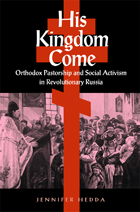 His Kingdom Come: Orthodox Pastorship and Social Activism in Revolutionary Russia
Jennifer Hedda
Northern Illinois University Press, 2011
Jennifer Hedda analyzes the ideas and activities of the parish clergy serving in St. Petersburg, the capital of imperial Russia, in order to discover how the Russian Orthodox Church responded theologically and pastorally to the profound social, economic, and cultural changes that transformed Russia during the 19th and early 20th centuries. The challenges of modernity forced the Orthodox clergy, like other members of educated society, to re-examine their interpretation of the Church’s earthly mission and their own role in fulfilling it. During the mid-19th century, Orthodox theologians began to argue that the church had a responsibility to society as well as to individuals, and to assert that its mission was to lead believers in building a society that manifested the gospel principles of love, mercy, charity, and justice.
The idea of creating “the kingdom of God” on earth inspired many clergymen, who dramatically increased their social outreach work in the last two decades of the 19th century: preaching during church services, teaching outside their churches, organizing charities, establishing temperance societies, and engaging in a host of other activities that involved them in the daily lives of their parishioners. The clergy’s work culminated in 1905, when a workers’ organization established by an Orthodox priest became a mass political movement whose activities sparked a revolution.
His Kingdom Come challenges many common assumptions about the Orthodox Church as a weak and passive institution that did not respond to the demands of the modern world—demonstrating that it played an active and creative role in late imperial society, albeit on its own terms rather than those of its secular critics. This book will be of particular interest to those who study the politics and society of Russia in the imperial period, the history of the Russian Orthodox Church in the modern era, the relationship of religious institutions to society and culture, and the history of religious-social thought in other post-Enlightenment societies.
 His Majesty’s Opponent: Subhas Chandra Bose and India’s Struggle against Empire
Sugata Bose
Harvard University Press, 2010 The man whom Indian nationalists perceived as the “George Washington of India” and who was President of the Indian National Congress in 1938–1939 is a legendary figure. Called Netaji (“leader”) by his countrymen, Subhas Chandra Bose struggled all his life to liberate his people from British rule and, in pursuit of that goal, raised and led the Indian National Army against Allied Forces during World War II. His patriotism, as Gandhi asserted, was second to none, but his actions aroused controversy in India and condemnation in the West.
Now, in a definitive biography of the revered Indian nationalist, Sugata Bose deftly explores a charismatic personality whose public and private life encapsulated the contradictions of world history in the first half of the twentieth century. He brilliantly evokes Netaji’s formation in the intellectual milieu of Calcutta and Cambridge, probes his thoughts and relations during years of exile, and analyzes his ascent to the peak of nationalist politics. Amidst riveting accounts of imprisonment and travels, we glimpse the profundity of his struggle: to unite Hindu and Muslim, men and women, and diverse linguistic groups within a single independent Indian nation. Finally, an authoritative account of his untimely death in a plane crash will put to rest rumors about the fate of this “deathless hero.”
This epic of a life larger than its legend is both intimate, based on family archives, and global in significance. His Majesty’s Opponent establishes Bose among the giants of Indian and world history.
His Master's Reflection: Travels with John Polidori, Lord Byron’s Doctor and Author of The Vampyre
Andrew Edwards
Sussex Academic Press, 2022 Qualifying as a doctorat the tender age of nineteen, John Polidori was employed less than a year later by the poet, Lord Byron, as his travelling physician. In His Master's Reflection;, the authors followPolidori's footsteps as he accompanies Byron through Europe to Switzerland.Fuelled byfriends, Byron finally releases Polidori from his contract, leaving the penniless medic to wander over the Alps on foot to Italy. Unable to establishhimself as a doctor to the expatriate community, he admits defeat and returns to England.Still harbouring literary ambitions, his one chance at fame is cruelly denied when The Vampyre;, the story he wrotein Geneva, is attributed to Byron. Gossip and retelling of events have cast Polidori in the role of a petulant plagiarist. The authors showthat the handsome Polidori was more than just his master's reflection.
His Master's Reflection: Travels with John Polidori, Lord Byron's Doctor and Author of The Vampyre
Andrew Edwards
Sussex Academic Press, 2022 Qualifying as a doctorat the tender age of nineteen, John Polidori was employed less than a year later by the poet, Lord Byron, as his travelling physician. In His Master's Reflection;, the authors followPolidori's footsteps as he accompanies Byron through Europe to Switzerland.Fuelled byfriends, Byron finally releases Polidori from his contract, leaving the penniless medic to wander over the Alps on foot to Italy. Unable to establishhimself as a doctor to the expatriate community, he admits defeat and returns to England.Still harbouring literary ambitions, his one chance at fame is cruelly denied when The Vampyre;, the story he wrotein Geneva, is attributed to Byron. Gossip and retelling of events have cast Polidori in the role of a petulant plagiarist. The authors showthat the handsome Polidori was more than just his master's reflection.
His Master's Voice
Stanislaw Lem
Northwestern University Press, 1999 Twenty-five hundred scientists have been herded into an isolated site in the Nevada desert. A neutrino message of extraterrestrial origin has been received and the scientists, under the surveillance of the Pentagon, labor on His Master's Voice, the secret program set up to decipher the transmission. Among them is Peter Hogarth, an eminent mathematician. When the project reaches a stalemate, Hogarth pursues clandestine research into the classified TX Effect--another secret breakthrough. But when he discovers, to his horror, that the TX Effect could lead to the construction of a fission bomb, Hogarth decides such knowledge must not be allowed to fall into the hands of the military.
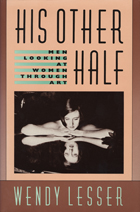 His Other Half: Men Looking at Women through Art
Wendy Lesser
Harvard University Press, 1991 Wendy Lesser counters the reigning belief that male artists inevitably misrepresent women. She builds this daring case compellingly through inquiry into many unexpected and delightfully germane subjects—Marilyn Monroe’s walk, for instance, or dwarf manicurist Miss Mowcher in David Copperfield, or the shoulder blades of Degas’s bathers. Placing such particulars within the framework of Plato’s myth of the divided beings and psychoanalytic concepts of narcissism, Lesser sets out before us an art that responds to and even attempts to overcome division.
By following a developmental, rather than historical, sequence, the book uncovers startling correspondences and fresh insights. It begins by considering Dickens, Lawrence, Harold Brodkey, Peter Handke, and John Berger on the subject of mothers; turns to Degas and the Victorian novelist George Gissing to examine the figure of woman alone, and then to Henry James and Alfred Hitchcock for their perspectives on the battle between the sexes; and then looks at the poetry of Randall Jarrell, the fashion photographs of Cecil Beaton, and the range of artworks inspired by Marilyn Monroe to investigate the central idea of woman as the artist's mirror and secret self.
A chapter on Barbara Stanwyck returns us to an essential premise—that art transcends gender boundaries, that the masculine and the feminine coexist within each individual psyche. The refreshingly open-minded approach of His Other Half finds its corollary in Lesser's lucid and accessible style. With great affection for her subject and her audience, Lesser writes in language that is opinionated yet free of cant. Her book avoids—as the best art avoids—prefabricated schemes and ideological presumptions. At once exploratory and definitive, original and erudite, His Other Half is critical inquiry at its finest.
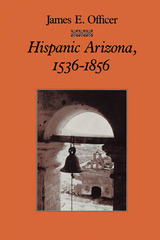 Hispanic Arizona, 1536–1856
James E. Officer
University of Arizona Press, 1987 The history of the American West has usually been seen from the perspective of American expansion. Drawing on previously unexplored primary sources, James E. Officer has now produced a major work that traces the Hispanic roots of southern Arizona and northern Sonora—one which presents the Spanish and Mexican rather than Anglo point of view. Officer records the Hispanic presence from the earliest efforts at colonization on Spain’s northwestern frontier through the Spanish and Mexican years of rule, thus providing a unique reference on Southwestern history.
The heart of the work centers on the early nineteenth century. It explores subjects such as the constant threat posed by hostile Apaches, government intrigue and revolution in Sonora and the provincias internas, and patterns of land ownership in villages such as Tucson and Tubac. Also covered are the origins of land grants in present-day southern Arizona and the invasion of southern Arizona by American “49ers” as seen from the Mexican point of view. Officer traces kinship ties of several elite families who ruled the frontier province over many generations—men and women whose descendants remain influential in Sonora and Arizona today.
Hispanic Baroques: Reading Cultures in Context
Nicholas Spadaccini
Vanderbilt University Press, 2005 Essays focus on Baroque as a concept and category of analysis which has been central to an understanding of Hispanic cultures during the last several hundred years
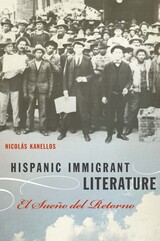 Hispanic Immigrant Literature: El Sueño del Retorno
By Nicolás Kanellos
University of Texas Press, 2011 Immigration has been one of the basic realities of life for Latino communities in the United States since the nineteenth century. It is one of the most important themes in Hispanic literature, and it has given rise to a specific type of literature while also defining what it means to be Hispanic in the United States. Immigrant literature uses predominantly the language of the homeland; it serves a population united by that language, irrespective of national origin; and it solidifies and furthers national identity. The literature of immigration reflects the reasons for emigrating, records—both orally and in writing—the trials and tribulations of immigration, and facilitates adjustment to the new society while maintaining links with the old society. Based on an archive assembled over the past two decades by author Nicolás Kanellos's Recovering the U. S. Hispanic Literary Heritage project, this comprehensive study is one of the first to define this body of work. Written and recorded by people from Mexico, Cuba, Puerto Rico, the Caribbean, and Central and South America, the texts presented here reflect the dualities that have characterized the Hispanic immigrant experience in the United States since the mid-nineteenth century, set always against a longing for homeland.
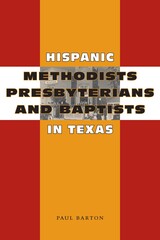 Hispanic Methodists, Presbyterians, and Baptists in Texas
By Paul Barton
University of Texas Press, 2006 The question of how one can be both Hispanic and Protestant has perplexed Mexican Americans in Texas ever since Anglo-American Protestants began converting their Mexican Catholic neighbors early in the nineteenth century. Mexican-American Protestants have faced the double challenge of being a religious minority within the larger Mexican-American community and a cultural minority within their Protestant denominations. As they have negotiated and sought to reconcile these two worlds over nearly two centuries, los Protestantes have melded Anglo-American Protestantism with Mexican-American culture to create a truly indigenous, authentic, and empowering faith tradition in the Mexican-American community. This book presents the first comparative history of Hispanic Methodists, Presbyterians, and Baptists in Texas. Covering a broad sweep from the 1830s to the 1990s, Paul Barton examines how Mexican-American Protestant identities have formed and evolved as los Protestantes interacted with their two very different communities in the barrio and in the Protestant church. He looks at historical trends and events that affected Mexican-American Protestant identity at different periods and discusses why and how shifts in los Protestantes' sense of identity occurred. His research highlights the fact that while Protestantism has traditionally served to assimilate Mexican Americans into the dominant U.S. society, it has also been transformed into a vehicle for expressing and transmitting Hispanic culture and heritage by its Mexican-American adherents.
Hispanic Nation: Culture, Politics, and the Constructing of Identity
Geoffrey Fox
University of Arizona Press, 1997 A new ethnic identity is being constructed in the United States: the Hispanic nation. Overcoming age-old racial, regional, and political differences, Americans of Mexican, Puerto Rican, Cuban, and other Spanish-language origins are beginning to imagine themselves as a single ethnic community-which by the turn of the century may become the United States' largest and most influential minority.
Hispanic Philosophy in the Age of Discovery
Kevin White
Catholic University of America Press, 2018 This volume presents 15 studies occasioned by the 500th anniversary of the European discovery of America. It covers both the initial encounters between the Europeans and native Americans and the golden age of Hispanic philosophy that followed the discover
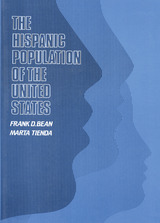 Hispanic Population of the United States
Frank D. Bean
Russell Sage Foundation, 1987 The Hispanic population in the United States is a richly diverse and changing segment of our national community. Frank Bean and Marta Tienda emphasize a shifting cluster of populations—Mexican, Puerto Rican, Cuban, Central and South American, Spanish, and Caribbean—as they examine fertility and immigration, family and marriage patterns, education, earnings, and employment. They discuss, for instance, the effectiveness of bilingual education, recommending instead culturally supportive programs that will benefit both Hispanic and non-Hispanic students. A study of the geographic distribution of Hispanics shows that their tendency to live in metropolitan areas may, in fact, result in an isolation which denies them equal access to schooling, jobs, and health care. Bean and Tienda offer a critical, much-needed assessment of how Hispanics are faring and what the issues for the future will be. Their findings reveal and reflect differences in the Hispanic population that will influence policy decisions and affect the Hispanic community on regional and national levels. "...represents the state of the art for quantitative analysis of ethnic groups in the United States." —American Journal of Sociology A Volume in the Russell Sage Foundation Census Series
Hispanic Representation in the Department of Defense Civilian Workforce: Trend and Barrier Analysis
Miriam Matthews
RAND Corporation, 2017 Hispanics are less represented in the U.S. Department of Defense (DoD) civilian workforce than in the federal civilian workforce and the civilian labor force. This report assesses what factors might account for Hispanic underrepresentation in DoD. It includes assessments of trends in Hispanic employment and analyses of job applicant data. It also presents findings from interviews with representatives of DoD and of Hispanic-serving institutions.
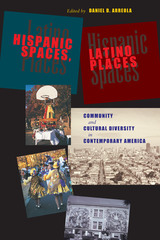 Hispanic Spaces, Latino Places: Community and Cultural Diversity in Contemporary America
Edited by Daniel D. Arreola
University of Texas Press, 2004 Hispanics/Latinos are the largest ethnic minority in the United States—but they are far from being a homogenous group. Mexican Americans in the Southwest have roots that extend back four centuries, while Dominicans and Salvadorans are very recent immigrants. Cuban Americans in South Florida have very different occupational achievements, employment levels, and income from immigrant Guatemalans who work in the poultry industry in Virginia. In fact, the only characteristic shared by all Hispanics/Latinos in the United States is birth or ancestry in a Spanish-speaking country. In this book, sixteen geographers and two sociologists map the regional and cultural diversity of the Hispanic/Latino population of the United States. They report on Hispanic communities in all sections of the country, showing how factors such as people's country/culture of origin, length of time in the United States, and relations with non-Hispanic society have interacted to create a wide variety of Hispanic communities. Identifying larger trends, they also discuss the common characteristics of three types of Hispanic communities—those that have always been predominantly Hispanic, those that have become Anglo-dominated, and those in which Hispanics are just becoming a significant portion of the population.
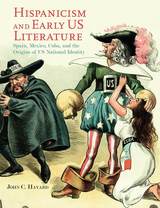 Hispanicism and Early US Literature: Spain, Mexico, Cuba, and the Origins of US National Identity
John C. Havard
University of Alabama Press, 2018 Well-researched analysis of the impact that Spain and Spanish America had on antebellum literature in the United States.
In Hispanicism and Early US Literature, author John C. Havard posits that representations of Spain, Spanish America, Spanishness, and Spanish Americanness are integral elements in the evolution of early national and antebellum US literature. He argues that Spanish-speaking countries have long held a broad fascination for Americans and that stock narratives regarding these peoples were central to the period’s US literature.
Beginning with the work of eighteenth-century literary nationalists such as Joel Barlow, US literature has been drawn to reflect on Spain and Spanish America. Such reflection was often inspired by geopolitical conflicts such as US expansion into Spanish Louisiana and the US-Mexican War. Havard terms the discourse emerging from these reflections “Hispanicism.” This discourse was used to portray the dominant viewpoint of classical liberalism that propounded an American exceptionalism premised on the idea that Hispanophone peoples were comparatively lacking the capacity for self-determination, hence rationalizing imperialism. On the conservative side were warnings against progress through conquest.
Havard delves into selected works of early national and antebellum literature on Spain and Spanish America to illuminate US national identity. Poetry and novels by Joel Barlow, James Fenimore Cooper, and Herman Melville are mined to further his arguments regarding identity, liberalism, and conservatism. Understudied authors Mary Peabody Mann and José Antonio Saco are held up to contrast American and Cuban views on Hispanicism and Cuban annexation as well as to develop the focus on nationality and ideology via differences in views on liberalism.
More than just a work of literary criticism, there is a substantial amount of cultural and political history discussed. Havard’s use of archival sources such as political articles and personal correspondence elucidates not just literary genres and movements such as early national epic poetry, abolitionist fiction, and the American Renaissance, but also US culture writ large.
 Hispaniola: A Photographic Journey through Island Biodiversity, Biodiversidad a Través de un Recorrido Fotográfico
Eladio FernándezForeword by Edward O. WilsonIntroduction by Philippe Bayard, Société Audubon Haïti
Harvard University Press, 2007 First, there is a soft rustle in the underbrush, then a low-slung, utterly bizarre-looking insectivore dashes in front of Eladio Fernández. With a reflexive click of digital shutter, he's captured the reclusive (Solenodon paradoxus--a living fossil. A Dominican-based conservationist and photographer, Fernandez is documenting the efforts of a distinguished team of international scientists as they unravel the workings of evolution being played out on the island of Hispaniola.
A short flight from the Florida coast, Hispaniola offers unique opportunities, not just to photographers like Fernández, but to evolutionary biologists as well. At 40 million years, Hispaniola is far older than the Galápagos. Its considerable age, along with a diversity of habitats--from mountains and cloud forests to savannahs and tropical lowlands--makes this island one of the most spectacular, if poorly understood, troves of biota on the planet. The extraordinary richness of species, much of it endangered and yet to be described, is showcased here in nearly 400 spectacular photographs. The photos are accompanied by essays--in both English and Spanish--that make known the Hispaniolan fungi, plants, and animals by the experts who know them best.
Insights gained from Hispaniola's unique flora and fauna, from its rare orchids to its stunningly beautiful bird life, may enrich our understanding of other, more complex, living systems worldwide. What Fernández captures here so vividly is not just the amazing variety of living creatures that have erupted in evolutionary isolation, but the urgency of scientists racing to give that variety a name before it vanishes.
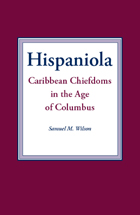 Hispaniola: Caribbean Chiefdoms in the Age of Columbus
Samuel M. Wilson
University of Alabama Press, 1990 In 1492 the island of Hispaniola was inhabited by the Taino, an Indian group whose ancestors had moved into the Caribbean archipelago from lowland South America more than 1,500 years before. They were organized politically into large cacicazgos, or chiefdoms, comprising 70 or more villages under the authority of a paramount cacique, or chief. From the first voyage on, Columbus made Hispaniola his primary base for operations in the New World. Over the subsequent decades, disease, warfare, famine, and enslavement brought about the destruction of the Taino chiefdoms and almost completely annihilated the aboriginal population of the island.
This book examines the early years of the contact period in the Caribbean and in narrative form reconstructs the social and political organization of the Taino. Wilson describes in detail the interactions between the Taino and the Spaniards, with special attention paid to the structure and functioning of the Taino chiefdoms. By providing additional information from archaeology and recent ethnography, he builds a rich context within which to understand the Taino and their responses to the Europeans.
The Taino are especially important in a New World context because they represent a society undergoing rapid sociopolitical change and becoming more complex through time. The early contact period on Hispaniola gives us a rich ethnohistorical glimpse of the political processes of a complex New World society before and during its destruction brought about by the arrival of the Europeans.
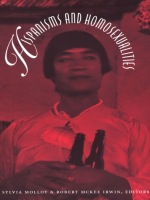 Hispanisms and Homosexualities
Sylvia Molloy and Robert Irwin, eds.
Duke University Press, 1998 A man masquerading as a lesbian in Spain’s Golden Age fiction. A hermaphrodite’s encounters with the Spanish Inquisition. Debates about virility in the national literature of postrevolutionary Mexico. The work of contemporary artists Reinaldo Arenas, Severo Sarduy, and María Luisa Bemberg. The public persona of Pedro Zamora, former star of MTV’s The Real World. Despite an enduring queer presence in Hispanic literatures and cultures, most scholars have avoided the specter of sexual dissidence in the Spanish-speaking world. In Hispanisms and Homosexualities, editors Sylvia Molloy and Robert Irwin bring together a group of essays that advance Hispanic studies and gay and lesbian studies by calling into question what is meant by the words Hispanic and homosexual. The fourteen contributors to this volume not only offer queer readings of Spanish and Latin American texts and performances, they also undermine a univocal sense of homosexual identities and practices. Taking on formations of national identity and sexuality; the politics of visibility and outing; the intersections of race, sexuality, and imperial discourse; the status of transvestism and posing; and a postmodern aesthetic of camp and kitsch, these essays from both established and emerging scholars provide a more complex and nuanced view of related issues involving nationality, ethnicity, and sexuality in the Hispanic world. Hispanisms and Homosexualities offers the most sophisticated critical and theoretical work to date in Hispanic and queer studies. It will be an essential text for all those engaged with the complexities of ethnic, cultural, and sexual subjectivities. Contributors. Daniel Balderston, Emilie Bergmann, Israel Burshatin, Brad Epps, Mary S. Gossy, Robert Irwin, Agnes I. Lugo-Ortiz, Sylvia Molloy, Oscar Montero, José Esteban Muñoz, José Quiroga, Rubén Ríos Avila, B. Sifuentes Jáuregui, Paul Julian Smith
The Hispanization of the Philippines: Spanish Aims and Filipino Responses, 1565–1700
John Leddy Phelan
University of Wisconsin Press, 1959 After conquest of the Philippine archipelago in the late sixteenth century, Spanish colonizers launched a sweeping social program designed to bring about dramatic religious, political, and economic changes. But the limitations of Spanish colonial resources, together with the reactions of Filipinos themselves, combined to shape the outcome of that effort in unique and unexpected ways, argues John Leddy Phelan. With no wealth in the islands to attract conquistadores, conquest was accomplished largely by missionaries scattered among isolated native villages. Native chieftains served as intermediaries, thus enabling the Filipinos to react selectively to Spanish innovations. The result was a form of hispanization in which the resilient and adaptable Filipinos played a creative part.
 Hispano-Jewish Culture in Transition: The Career and Controversies of Ramah
Bernard Septimus
Harvard University Press, 1982 This study of the sometimes stormy career of a brilliant and colorful talmudist offers a broad picture of medieval Hispano-Jewish culture.
Meir Abulafia (ca. 1165-1244), commonly called Ramah, was born into the old Jewish aristocracy of Muslim Spain and educated in the best Judeo-Arabic tradition, but lived his whole life under the new political and cultural realities of Christian Spain. Mr. Septimus portrays Ramah's career as a lawyer, exegete, poet, and theologian in an age of rapid cultural change. His book describes the intellectual cross-fertilization and conflict that resulted from new connections with European Jewish communities to the north. It focuses, in particular, on the great controversy over the philosophical rationalism of Maimonides, which Ramah initiated and in which he played a major role. This clash dominated Jewish intellectual history for three centuries and parallels important developments in Latin Christendom.
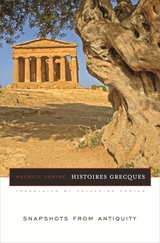 Histoires Grecques: Snapshots from Antiquity
Maurice Sartre
Harvard University Press, 2009 In a series of brilliant snapshots, each a distinct bit of a larger story, Maurice Sartre’s Histoires Grecques spans the grand narrative of Greek culture over a thousand years and a vast expanse of land and sea. From Homer to Damascius, from recent discoveries in Kandahar to an account of the murder of Hypatia in 415 CE, each snapshot captures a moment in the history of Greek civilization. Together they offer a fresh perspective on an ancient culture whose wealth and depth of thought, variety and multiplicity of accomplishments, and astonishing continuity through time and space have made it the Western world’s culture of reference.
A textual fragment, a coin, an epigraph: each artifact and image launches Sartre—and his readers—on a journey into the practical mysteries of Greek civilization. Ranging from Afghanistan to the Mediterranean world, these excursions—step by step, moment by moment—finally amount to a panoramic vision of one of the most important civilizations of all time. Histoires Grecques shows the newcomer and the seasoned scholar alike how history itself is written—and imparts the experience, and the pleasure, of discovering history as discrete stories seen through the eyes of one of the most eminent historians of ancient Greece.
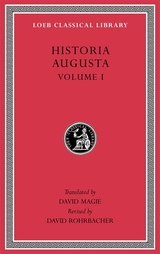 Historia Augusta, Volume I
David Magie
Harvard University Press, 2022 March of the emperors.
The Historia Augusta is a biographical work roughly following the model of the imperial biographer Suetonius (LCL 31, 38) and covering the lives of the Roman emperors from Hadrian (r. 117–138) to Carinus (r. 283–285), with a lacuna between the lives of the Gordians and the Valerians. Although the work comes down to us as a collection of thirty books written by six different authors, it is now generally considered to be the creation of a single individual writing under several pseudonyms no earlier than the late fourth century. It is a thoroughly enigmatic work whose origins, nature, and purpose remain obscure; the very beginning of the life of Hadrian is lost, and with it any general introduction that may have existed.
While the Historia Augusta is our most detailed surviving source for the second and third centuries, often providing details beyond the Greek accounts, it is not a trustworthy source for historical information: too many of the details are anachronistic, unsupported, or preposterous, or contradicted internally or by better sources, and many documents, speeches, acclamations, and inscriptions that it quotes or cites are entirely fictional.
The Historia Augusta nevertheless has its attractions: for the connoisseur of biography the author provides plenty of wordplay, puns, allusions, literary games, and mock-scholarly digressions, and for the casual reader he offers vivid characterizations of emperors both good and bad.
This revision of the original Loeb edition by David Magie offers text, translation, and annotation that are fully current with modern scholarship.
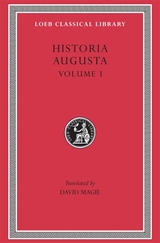 Historia Augusta, Volume I: Hadrian. Aelius. Antoninus Pius. Marcus Aurelius. L. Verus. Avidius Cassius. Commodus. Pertinax. Didius Julianus. Septimius Severus. Pescennius Niger. Clodius Albinus
David Magie
Harvard University Press The Scriptores Historiae Augustae, or Historia Augusta, is a collection of biographies of Roman emperors, heirs, and claimants from Hadrian to Numerianus (117–284 CE). The work, which is modeled on Suetonius, purports to be written by six different authors and quotes documents and public records extensively. Since we possess no continuous account of the emperors of the second and third centuries, the Historia Augusta has naturally attracted keen attention. In the last century it has also generated the gravest suspicions. Present opinion holds that the whole is the work of a single author (who lived in the time of Theodosius) and contains much that is plagiarism and even downright forgery.
The Loeb Classical Library edition of the Historia Augusta is in three volumes.
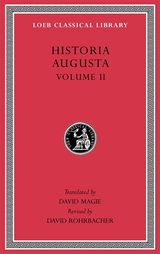 Historia Augusta, Volume II
David Magie
Harvard University Press, 2022 March of the emperors.
The Historia Augusta is a biographical work roughly following the model of the imperial biographer Suetonius (LCL 31, 38) and covering the lives of the Roman emperors from Hadrian (r. 117–138) to Carinus (r. 283–285), with a lacuna between the lives of the Gordians and the Valerians. Although the work comes down to us as a collection of thirty books written by six different authors, it is now generally considered to be the creation of a single individual writing under several pseudonyms no earlier than the late fourth century. It is a thoroughly enigmatic work whose origins, nature, and purpose remain obscure; the very beginning of the life of Hadrian is lost, and with it any general introduction that may have existed.
While the Historia Augusta is our most detailed surviving source for the second and third centuries, often providing details beyond the Greek accounts, it is not a trustworthy source for historical information: too many of the details are anachronistic, unsupported, or preposterous, or contradicted internally or by better sources, and many documents, speeches, acclamations, and inscriptions that it quotes or cites are entirely fictional.
The Historia Augusta nevertheless has its attractions: for the connoisseur of biography the author provides plenty of wordplay, puns, allusions, literary games, and mock-scholarly digressions, and for the casual reader he offers vivid characterizations of emperors both good and bad.
This revision of the original Loeb edition by David Magie offers text, translation, and annotation that are fully current with modern scholarship.
Historia Augusta, Volume II: Caracalla. Geta. Opellius Macrinus. Diadumenianus. Elagabalus. Severus Alexander. The Two Maximini. The Three Gordians. Maximus and Balbinus
David Magie
Harvard University Press The Scriptores Historiae Augustae, or Historia Augusta, is a collection of biographies of Roman emperors, heirs, and claimants from Hadrian to Numerianus (117–284 CE). The work, which is modeled on Suetonius, purports to be written by six different authors and quotes documents and public records extensively. Since we possess no continuous account of the emperors of the second and third centuries, the Historia Augusta has naturally attracted keen attention. In the last century it has also generated the gravest suspicions. Present opinion holds that the whole is the work of a single author (who lived in the time of Theodosius) and contains much that is plagiarism and even downright forgery.
The Loeb Classical Library edition of the Historia Augusta is in three volumes.
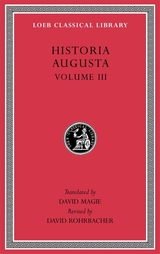 Historia Augusta, Volume III
David Magie
Harvard University Press, 2022 March of the emperors.
The Historia Augusta is a biographical work roughly following the model of the imperial biographer Suetonius (LCL 31, 38) and covering the lives of the Roman emperors from Hadrian (r. 117–138) to Carinus (r. 283–285), with a lacuna between the lives of the Gordians and the Valerians. Although the work comes down to us as a collection of thirty books written by six different authors, it is now generally considered to be the creation of a single individual writing under several pseudonyms no earlier than the late fourth century. It is a thoroughly enigmatic work whose origins, nature, and purpose remain obscure; the very beginning of the life of Hadrian is lost, and with it any general introduction that may have existed.
While the Historia Augusta is our most detailed surviving source for the second and third centuries, often providing details beyond the Greek accounts, it is not a trustworthy source for historical information: too many of the details are anachronistic, unsupported, or preposterous, or contradicted internally or by better sources, and many documents, speeches, acclamations, and inscriptions that it quotes or cites are entirely fictional.
The Historia Augusta nevertheless has its attractions: for the connoisseur of biography the author provides plenty of wordplay, puns, allusions, literary games, and mock-scholarly digressions, and for the casual reader he offers vivid characterizations of emperors both good and bad.
This revision of the original Loeb edition by David Magie offers text, translation, and annotation that are fully current with modern scholarship.
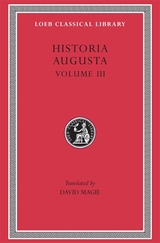 Historia Augusta, Volume III: The Two Valerians. The Two Gallieni. The Thirty Pretenders. The Deified Claudius. The Deified Aurelian. Tacitus. Probus. Firmus, Saturninus, Proculus and Bonosus. Carus, Carinus and Numerian
David Magie
Harvard University Press The Scriptores Historiae Augustae, or Historia Augusta, is a collection of biographies of Roman emperors, heirs, and claimants from Hadrian to Numerianus (117 284 CE). The work, which is modeled on Suetonius, purports to be written by six different authors and quotes documents and public records extensively. Since we possess no continuous account of the emperors of the second and third centuries, the Historia Augusta has naturally attracted keen attention. In the last century it has also generated the gravest suspicions. Present opinion holds that the whole is the work of a single author (who lived in the time of Theodosius) and contains much that is plagiarism and even downright forgery.
The Loeb Classical Library edition of the Historia Augusta is in three volumes.
 The Historian and Believer: The Morality of Historical Knowledge and Christian Belief
Van A. Harvey
University of Illinois Press, 1952 A milestone work in Christian
theology--available again!
"As a critic of the contemporary
theological scene, Van Harvey has few, if any, competitors. This is nowhere
clearer than in The Historian and the Believer . . . the classic
discussion of its topic. Rich in insight and penetrating in argument,
it is one book that belongs in the library of every theologian and seminarian."
-- Schubert M. Ogden, author of Doing Theology Today
Is it possible to be both
a historian and a Christian? Van Harvey's classic The Historian and
the Believer posed that question when it was first published.
In this printing, the author
has provided a new introduction in which he reflects on how he would reframe
his original argument in order to bring out more fully the basic theological
intention underlying his view that Christian faith cannot rest on dubious
historical claims.
From reviews of the first
edition:
"Probably the most interesting
piece of American theological writing to appear this year." -- John
Reumann, Union Seminary Quarterly Review
 A Historian and His World: A Life of Christopher Dawson, 1889-1970
Christina Scott
Catholic University of America Press, 2023 The English historian of culture Christopher Dawson (1889-1970) was an independent scholar and the author of more than twenty books. He served as assistant lecturer in the History of Culture, University College, Exeter (1925), Forwood Lecturer in the Philosophy of Religion, University of Liverpool (1934), Gifford Lecturer at the University of Edinburgh (1947-1949), and as Professor of Catholic Studies at Harvard University (1958-1962). He was elected Fellow of the British Academy in 1943 and edited the Dublin Review during the Second World War. This biography by Christina Scott, Dawson’s daughter, is a sensitive portrait of a complex and fascinating scholar.
Unlike other English Christian converts of the twentieth century who excelled in literature, like G. K. Chesterton or C. S. Lewis, Dawson turned to the social sciences. He drew from the new idea of culture as a common way of life emerging from anthropology at the time of the Great War to shape a new approach to history. His study of the intimate relationship between religion and culture throughout world history shaped his trenchant criticisms of his own times. He wrote in 1955 that, “the first step in the transformation of culture is a change in the pattern of culture within the mind, for this is the seed out of which there spring new forms of life which ultimately change the social way of life and thus create a new culture.” Dawson’s engagement with anthropology and the idea of culture marked an important moment of development in the Catholic intellectual tradition.
Christina Scott shows that Dawson is best understood as he himself interpreted his historical subjects—in the context of “the spiritual world in which he lived, the ideas that moved him, and the faith that inspired his action.” Dawson was not a historian of ideas for their own sake; he had a passionate belief in their liberating power. A Historian and His World will be of interest to intellectual historians, historians of religion and culture, and students of modern Catholic thought. The Introduction is written by Dawson scholar Joseph T. Stuart and the book is graced by a postscript by Christopher Dawson reflecting upon the meaning of his work.
Historian and Scientist: An Essay on the Nature of History and the Social Sciences
Gaetano Salvemini
Harvard University Press The almost religious zeal for historical and social studies which characterizes our age, is born of a two-fold hope: that history may reveal to us our origin, and that the social sciences may reveal to us the laws of social life. This same hope explains why we feel the need of discussing our methods of research, the soundness of the material on which we work, and the reliability of our conclusions. It also explains why many historians and social scientists ask themselves whether history and the social sciences are really sciences. To this fundamental question underlying all historical scholarship, Dr. Salvemini devotes these charmingly lucid pages.
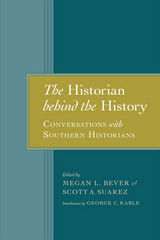 The Historian behind the History: Conversations with Southern Historians
Megan L. Bever
University of Alabama Press, 2014 The Historian behind the History brings together a collection of valuable interviews with prominent southern historians conducted over the course of a decade by graduate students in the University of Alabama’s history program for the journal Southern History. In the interviews, ten notable southern historians and mentors illuminate the state of historiography, their experiences in the profession, and their thoughts about graduate education and southern history.
The historians and their main topics include:
Richard J. M. Blackett on antebellum and African American history
Dan T. Carter on Reconstruction, Civil Rights, and George Wallace
Pete Daniel on the New Deal and the Cold War South
Laura F. Edwards on the Early Republic, the Civil War, Reconstruction, and women’s history
William W. Freehling on the antebellum South
Gary W. Gallagher on the Civil War
Glenda Elizabeth Gilmore on Jim Crow
James M. McPherson on the Civil War
Theodore Rosengarten on the Depression
J. Mills Thornton III on the antebellum South
In his introduction, award-winning author and historian George C. Rable draws together the multifaceted themes of these interviews, offering a compelling overview of the nature of the field. Edited by Megan L. Bever and Scott A. Suarez, The Historian behind the History offers critical insights about the craft and professional life of the historian.
 Historians Against History: The Frontier Thesis and the National Covenant in American Historical Writing Since 1830
David W. Noble
University of Minnesota Press, 1967 Historians Against History was first published in 1967. Minnesota Archive Editions uses digital technology to make long-unavailable books once again accessible, and are published unaltered from the original University of Minnesota Press editions. Professor Noble examines the basic philosophy and writing of six American historians, George Bancroft, Frederick Jackson, Charles A. Beard, Carl Becker, Vernon Louis Parrington, and Daniel J. Boorstin, and finds in them a common tradition which he calls anti-historical. He argues that this viewpoint is founded in the frontier interpretation of American history, that American historians have served as the chief political theorists and theologians of this country since 1830, and that their writings can be interpreted as Jeremiads designed to preserve a national covenant with nature.
Historians and Historiography in the Italian Renaissance
Eric Cochrane
University of Chicago Press, 1981 Second edition. A comprehensive survey of historical literature produced in Italy during the Renaissance; a major contribution which discusses hundreds of authors who wrote in Latin or Italian in all parts of Italy during the fifteenth and sixteenth centuries.
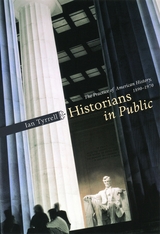 Historians in Public: The Practice of American History, 1890-1970
Ian Tyrrell
University of Chicago Press, 2005 From lagging book sales and shrinking job prospects to concerns over the discipline's "narrowness," myriad factors have been cited by historians as evidence that their profession is in decline in America. Ian Tyrrell's Historians in Public shows that this perceived threat to history is recurrent, exaggerated, and often misunderstood. In fact, history has adapted to and influenced the American public more than people—and often historians—realize.
Tyrrell's elegant history of the practice of American history traces debates, beginning shortly after the profession's emergence in American academia, about history's role in school curricula. He also examines the use of historians in and by the government and whether historians should utilize mass media such as film and radio to influence the general public. As Historians in Public shows, the utility of history is a distinctive theme throughout the history of the discipline, as is the attempt to be responsive to public issues among pressure groups.
A superb examination of the practice of American history since the turn of the century, Historians in Public uncovers the often tangled ways history-makers make history-both as artisans and as actors.
 The Historian's Lincoln: Pseudohistory, Psychohistory, and History
Edited by Gabor S. Boritt
University of Illinois Press, 1988 Winner of the Barondess/Lincoln Award of the Civil War Round Table of New York, 1989 "For Lincoln specialists, The Historian's Lincoln deepens and sharpens familiar arguments. For nonspecialists, it is the most efficient and enjoyable way to 'get right' with Lincoln." -- Robert E. McGlone, Pennsylvania Magazine of History and Biography "Provides an excursion to the frontiers of Lincoln scholarship, and insight into the passions of those who labor there. . . . Rarely do the products of a scholarly symposium so richly deserve placement on public and academic library shelves." -- John Y. Simon, Choice "Authoritative, well written, and spiced by informed debate. In short, Lincoln's depth and height as a figure in history are well measured by this distinguished volume, not only in its several parts and authors, but also as a whole." -- Robert V. Bruce, author of Lincoln and the Tools of War
 Historians on Hamilton: How a Blockbuster Musical Is Restaging America's Past
Romano, Renee C
Rutgers University Press, 2018 America has gone Hamilton crazy. Lin-Manuel Miranda’s Tony-winning musical has spawned sold-out performances, a triple platinum cast album, and a score so catchy that it is being used to teach U.S. history in classrooms across the country. But just how historically accurate is Hamilton? And how is the show itself making history?
Historians on Hamilton brings together a collection of top scholars to explain the Hamilton phenomenon and explore what it might mean for our understanding of America’s history. The contributors examine what the musical got right, what it got wrong, and why it matters. Does Hamilton’s hip-hop take on the Founding Fathers misrepresent our nation’s past, or does it offer a bold positive vision for our nation’s future? Can a musical so unabashedly contemporary and deliberately anachronistic still communicate historical truths about American culture and politics? And is Hamilton as revolutionary as its creators and many commentators claim?
Perfect for students, teachers, theatre fans, hip-hop heads, and history buffs alike, these short and lively essays examine why Hamilton became an Obama-era sensation and consider its continued relevance in the age of Trump. Whether you are a fan or a skeptic, you will come away from this collection with a new appreciation for the meaning and importance of the Hamilton phenomenon.
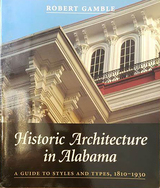 Historic Architecture in Alabama: A Guide to Styles and Types, 1810-1930
Robert S. Gamble
University of Alabama Press, 2001 Richly illustrated and concisely organized, this architectural guide provides an invaluable resource for those interested in the study, appreciation, and preservation of the state's architecture. Robert Gamble outlines in detail the primary architectural currents and styles that have surfaced in Alabama over the years and defined thestate's built landscape. The structures and styles, all well-illustrated,range from folk houses and early settlement buildings to railway terminals,churches, libraries, municipal and university buildings, palatial private mansions, and modest homes. Structures from every period and every major stylistic era--Federal, Greek Revival, Gothic Revival, Italianate, Romanesque and Mission Revival, and the Richardsonian—are documented meticulously, along with examples of early--Modern buildings, including Alabama's only Frank Lloyd Wright structure and skyscrapers from the Chicago school. More than 200 photographs, supplemented by sketches, plans, and etchings, provide the general reader and the design professional with images of Alabama architecture in all its variety and range. Many illustrations offer rare views of buildings long since demolished. A substantial glossary of architectural terms and a thorough bibliography enhance this standard sure to be welcomed anew by any lover of old buildings, whether weekend rambler or serious student.
 Historic Capital: Preservation, Race, and Real Estate in Washington, D.C.
Cameron Logan
University of Minnesota Press, 2017 Washington, D.C. has long been known as a frustrating and sometimes confusing city for its residents to call home. The monumental core of federal office buildings, museums, and the National Mall dominates the city’s surrounding neighborhoods and urban fabric. For much of the postwar era, Washingtonians battled to make the city their own, fighting the federal government over the basic question of home rule, the right of the city’s residents to govern their local affairs. In Historic Capital, urban historian Cameron Logan examines how the historic preservation movement played an integral role in Washingtonians’ claiming the city as their own. Going back to the earliest days of the local historic preservation movement in the 1920s, Logan shows how Washington, D.C.’s historic buildings and neighborhoods have been a site of contestation between local interests and the expansion of the federal government’s footprint. He carefully analyzes the long history of fights over the right to name and define historic districts in Georgetown, Dupont Circle, and Capitol Hill and documents a series of high-profile conflicts surrounding the fate of Lafayette Square, Rhodes Tavern, and Capitol Park, SW before discussing D.C. today. Diving deep into the racial fault lines of D.C., Historic Capital also explores how the historic preservation movement affected poor and African American residents in Anacostia and the U Street and Shaw neighborhoods and changed the social and cultural fabric of the nation’s capital. Broadening his inquiry to the United States as a whole, Logan ultimately makes the provocative and compelling case that historic preservation has had as great an impact on the physical fabric of U.S. cities as any other private or public sector initiative in the twentieth century.
Historic Illinois from the Air
David Buisseret
University of Chicago Press, 1990 "A distinctive and skillful effort to bring facets of Illinois history to a popular as well as an academic audience."—John Hoffman, Illinois Historical Survey, University of Illinois Library
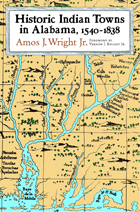 Historic Indian Towns in Alabama, 1540-1838
Amos J. Wright
University of Alabama Press, 2003 Identifies town site locations and clarifies entries from the earliest documents and maps of explorers in Alabama
This encyclopedic work is a listing of 398 ancient towns recorded within the present boundaries of the state of Alabama, containing basic information on each village's ethnic affiliation, time period, geographic location, descriptions, and (if any) movements. While publications dating back to 1901 have attempted to compile such a listing, none until now has so exhaustively harvested the 214 historic maps drawn between 1544, when Hernando de Soto's entourage first came through the southeastern territory, and 1846, when Indian removal to the Oklahoma Territory was complete. Wright combines the map data with a keen awareness of both previously published information and archival sources, such as colonial town lists, census information, and travel narratives.
The towns are listed alphabetically, and the text of each entry develops chronologically. While only a few of these towns have been accurately located by archaeologists, this volume provides a wealth of information for the future study of cultural geography, southeastern archaeology, and ethnohistory. It will be an enduring reference source for many years to come.
SAMPLE ENTRY,
ALIBAMA TOWN (Alibama)
The Alibama consisted of several towns—Mucclassa, Tawasa, Tomopa, Koarsati (Knight 1981, 27:48). Pickett ([1851] 1962:81) adds Ecanchati, Pawokti, and Autauga. The Alibama Town can also be added. Many maps show the Alibama as a group, but one map, 1796 Thomas and Andrews, locates the "Alabama Town"on the east bank of the Coosa just below Wetumpka.
Swanton ([1922] 1970a:209) wrote that the Tuskegee at the Alabama forks may have been known as the "Alabama Town"; however, this is unlikely, as Major W. Blue, a removal agent, wrote in July 1835 that Coosada, Alabama Town, and Tuskegee were ready to emigrate and they all lived adjoining each other in Macon County (ASP, Military Affairs 1861,6:731). On 6 July 1838, some twenty-seven towns, including "Alibama" (NA M234 R225), attended the Creek council held in Indian Territory. Thomas Bibb, brother to Alabama territorial govenor William Wyatt Bibb, and others, including Nashville investors, founded the town of Alabama in 1817 at Ten Mile Bluff in Montgomery County (Moser 1980-94, 4:131). The town soon disappeared into history.
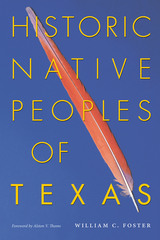 Historic Native Peoples of Texas
By William C. Foster
University of Texas Press, 2008 Several hundred tribes of Native Americans were living within or hunting and trading across the present-day borders of Texas when Cabeza de Vaca and his shipwrecked companions washed up on a Gulf Coast beach in 1528. Over the next two centuries, as Spanish and French expeditions explored the state, they recorded detailed information about the locations and lifeways of Texas's Native peoples. Using recent translations of these expedition diaries and journals, along with discoveries from ongoing archaeological investigations, William C. Foster here assembles the most complete account ever published of Texas's Native peoples during the early historic period (AD 1528 to 1722). Foster describes the historic Native peoples of Texas by geographic regions. His chronological narrative records the interactions of Native groups with European explorers and with Native trading partners across a wide network that extended into Louisiana, the Great Plains, New Mexico, and northern Mexico. Foster provides extensive ethnohistorical information about Texas's Native peoples, as well as data on the various regions' animals, plants, and climate. Accompanying each regional account is an annotated list of named Indian tribes in that region and maps that show tribal territories and European expedition routes. This authoritative overview of Texas's historic Native peoples reveals that these groups were far more cosmopolitan than previously known. Functioning as the central link in the continent-wide circulation of trade goods and cultural elements such as religion, architecture, and lithic technology, Texas's historic Native peoples played a crucial role in connecting the Native peoples of North America from the Pacific Coast to the Southeast woodlands.
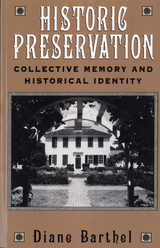 Historic Preservation: Collective Memory and Historic Identity
Barthel, Diane
Rutgers University Press, 1996 Historic preservation is a cultural movement gaining momentum and adherents throughout Europe and the United States. How do we decide what to preserve and how to preserve? Who benefits from the efforts of preservationists, curators, developers, and other "symbolic bankers" to safeguard an increasing variety of structures for future generations? Diane Barthel raises these and other questions in this important new book. Taking a comparative approach, Barthel finds that preservation in Britain has largely been an elite enterprise aimed at preserving traditional values. In the United States, by contrast, the pattern is much more dynamic and democratic, though also more permeated by commercialism. Is preservation becoming another means of consuming history, like media representations or "historic" shopping outlets? Or does it have a special significance as a very tangible means of getting in touch with our collective and individual pasts? These and other issues--including war and remembrance, agrarian and industrial preservation, and religious preservation in a secular society--demonstrate the significance of what Barthel calls "the Preservation Project" and why we all have a stake in how our history is reconstructed and interpreted.
Historic Sites and Markers along the Mormon and Other Great Western Trails
Stanley B. Kimball
University of Illinois Press, 1988 Historic Sites and Markers
is an indispensable guide for travelers who wish to retrace the various frontier
routes taken by the Mormons and other pioneers in their treks westward. Traversing
fifteen states from New York to California, Stanley Kimball presents some of
America's most famous trails--the Mormon, the Oregon-California, the Santa Fe,
the Overland, and many others--and describes important points of interest, including
forts, trail centers, and museums.
"An important contribution
to the history of the West and perhaps the most comprehensive mile-by-mile guide
to trail markers and historical sites ever prepared."
-- Brigham D. Madsen, author of The Shoshoni Frontier and the Bear
River Massacre
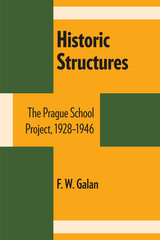 Historic Structures: The Prague School Project, 1928–1946
By F. W. Galan
University of Texas Press, 1985 In this first book-length study of Czech structuralism and semiotics in English, F. W. Galan explores one of the most important intellectual currents of the twentieth century, filling the gap between what has been written of the Russian formalism of the twenties and the French structuralism of the sixties and seventies. He records the evolution within the Prague Linguistic Circle of those theories which concern literature's change in time and the place of literature in society. In doing so, he reveals how the work of the Prague Linguistic Circle in the years 1928 to 1946 vindicate structuralism against its critics' charges that the structuralist approach—in linguistics, literary theory, film studies, and related fields—is inherently unhistorical. Overcoming this apparent methodological impasse was the main challenge confronted by the scholars of the Prague School–Roman Jakobson and Jan Mukarovsky, in particular.
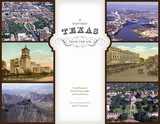 Historic Texas from the Air
By David Buisseret, Richard Francaviglia, Gerald Saxon, and Jack Graves
University of Texas Press, 2009 The extremely varied geography of Texas, ranging from lush piney woods to arid, mountainous deserts, has played a major role in the settlement and development of the state. To gain full perspective on the influence of the land on the people of Texas, you really have to take to the air—and the authors of Historic Texas from the Air have done just that. In this beautiful book, dramatic aerial photography provides a complete panorama of seventy-three historic sites from around the state, showing them in extensive geographic context and revealing details unavailable to a ground-based observer. Each site in Historic Texas from the Air appears in a full-page color photograph, accompanied by a concise description of the site's history and importance. Contemporary and historical photographs, vintage postcard images, and maps offer further visual information about the sites. The book opens with images of significant natural landforms, such as the Chisos Mountains and the Big Thicket, then shows the development of Texas history through Indian spiritual sites (including Caddo Mounds and Enchanted Rock), relics from the French and Spanish occupation (such as the wreck of the Belle and the Alamo), Anglo forts and methods of communication (including Fort Davis and Salado's Stagecoach Inn), nineteenth-century settlements and industries (such as Granbury's courthouse square and Kreische Brewery in La Grange), and significant twentieth-century locales, (including Spindletop, the LBJ Ranch, and the Dallas–Fort Worth International Airport). For anyone seeking a visual, vital overview of Texas history, Historic Texas from the Air is the perfect place to begin.
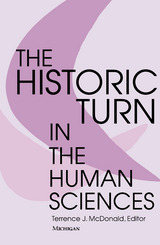 Historic Turn in the Human Sciences
Terrence J. McDonald, Editor
University of Michigan Press, 1996 In The Historic Turn in the Human Sciences eleven scholars widely known for their interdisciplinary work investigate one of the most striking developments in the intellectual world today: the return to history by a wide range of academic disciplines. From "new historicism" in literary theory, to "ethnohistory," to "historical sociology," these new approaches have resulted both in more works of historical analysis and in a more self-conscious attempt to locate the human sciences in their own histories. The essays in The Historic Turn in the Human Sciences--eight of them published here for the first time--take stock of these changes from the perspectives of some of the disciplines most deeply involved: anthropology, sociology, political science, law, literary studies, and history itself. Many of the authors have played a crucial role in producing the historic turn in their own disciplines. The volume as a whole, therefore, goes significantly beyond a mere inventory of these changes to ask how and how much history can make a difference; how the practice of history is affected by post-structural and other theories; and what is left of both unproblematized history and social science after the historic turn. Taken together the essays give a sense both of what these various turns to history have in common and what sets them apart. This comparative dimension distinguishes the volume from those that have analyzed the impact of history on a single field or have assayed its effects without including historians themselves. In the wake of the historic turn neither the historical actor nor the historical analyst will ever again be seen as a colossus striding over the pages of history. This volume explains in an extraordinary thought-provoking and challenging way why this must be so. Terrence J. McDonald is Professor of History, University of Michigan.
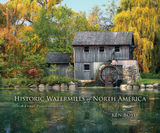 Historic Watermills of North America: A Visual Preservation
Ken Boyd
University of Alabama Press, 2021 112 full-color artistic photographs of watermills still standing on the North American landscape
The scenic beauty of the watermill is undeniable. The iconic waterwheel has inspired romantics for generations with their warmth and charm. Watermills were once ubiquitous landmarks along brooks, creeks, and rivers across North America. Today, only a scattering of the old watermills grace the countryside, but through these mills, and the turning of their wheels and the whirling of their stones, a small but spectacular part of history lives on.
Through stunningly beautiful images, Historic Watermills of North America: A Visual Preservation presents 112 watermills still standing on the North American landscape. With idealized full-color photographs, Ken Boyd nostalgically hearkens back to a time after European settlement when these structures were the very heart of the communities whose livelihoods they made possible. These mills turned the power of flowing water into mechanical energy to grind corn and wheat into meal and flour, saw timber, loom wool and cotton cloth, and more for the benefit of their operators and communities.
At one time vital to their surrounding regions, most of these surviving mills are in rural areas that have been passed over by modern development. Their designs are as individual as their makers, and their settings are as varied as the landscape. Some have been converted into homes or museums or are part of local tourist attractions. Others have been abandoned but give witness to the significance of their heydays, and others are still in use, doing the same work they have done for generations.
Boyd’s beautifully rendered photographs preserve these extant structures and represent a variety of watermills across the United States and Canada. Each mill photograph is accompanied by a description providing the name of the mill, its location, date of construction, and brief comments highlighting its most noteworthy features. Additional photographs and commentary in the afterword explore the inner workings of watermills.
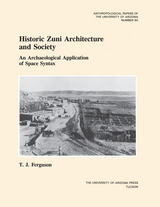 Historic Zuni Architecture and Society: An Archaeological Application of Space Syntax
T. J. Ferguson
University of Arizona Press, 1996 The historic architecture and settlements of the Zuni Indian Tribe in western New Mexico provide an unusual opportunity to investigate social change. In this monograph, the development of historic Zuni society is analyzed by delineating systematic links between the structure of Zuni society and the structure of architectural forms that the Zuni people built to facilitate their activities. Ferguson shows how the structure of open space within Zuni settlements was linked to defense. As long as the Zunis were subject to attack by Spaniards or Navajos, they built settlements that were difficult for outsiders to get into or move around in. As the need for defense waned, settlements became more open and accessible. He also shows how the internal spaces of traditional Zuni houses are oriented around the activities of the women--matriarchs of their families and clans. Federal housing projects tended to spatially isolate the activities of women from interaction with the rest of the household, thus instituting unexpected social change.
Historic Zuni Architecture and Society utilizes an interdisciplinary approach, analyzing archaeological data using method, theory, and techniques from the fields of architecture, planning, and ethnology. Archaeologists will find in the book an innovative application of space syntax to archaeological problems, and cultural anthropologists and others interested in the history of the Zuni Indians will value its observations about changes that are currently taking place in Zuni social organization.
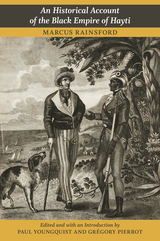 An Historical Account of the Black Empire of Hayti
Marcus Rainsford
Duke University Press, 2013 As the first complete narrative in English of the Haitian Revolution, Marcus Rainsford's An Historical Account of the Black Empire of Hayti was highly influential in establishing nineteenth-century world opinion of this momentous event. This new edition is the first to appear since the original publication in 1805. Rainsford, a career officer in the British army, went to Haiti to recruit black soldiers for the British. By publishing his observations of the prowess of black troops, and recounting his meetings with Toussaint Louverture, Rainsford offered eyewitness testimonial that acknowledged the intelligence and effectiveness of the Haitian rebels. Although not an abolitionist, Rainsford nonetheless was supportive of the independent state of Haiti, which he argued posed no threat to British colonial interests in the West Indies, an extremely unusual stance at the time. Rainsford's account made an immediate impact upon publication; it was widely reviewed, and translated twice in its first year. Paul Youngquist's and Grégory Pierrot's critical introduction to this new edition provides contextual and historical details, as well as new biographical information about Rainsford. Of particular interest is a newly discovered miniature painting of Louverture attributed to Rainsford, which is reproduced along with the twelve engravings that accompanied his original account.
An Historical and Analytical Bibliography of the Literature of Cryptology
Joseph S. Galland
Northwestern University Press, 1945 Originally published in 1945, An Historical and Analytical Bibliography of the Literature of Cryptology provides a comprehensive listing of the most important works written up to that time on cryptography, as well as works in related fields in which cryptography appears. It includes a vast range of materials: scientific and technical works dealing with military, diplomatic, and commercial uses of cryptography; popular treatments; cuneiform, runic, and other hieroglyphic writings; literary anagrams and acrostics; the symbolism of colors, gems, emblems, and insignia, and many other manifestations. Entries include descriptive and analytical annotations by the author.
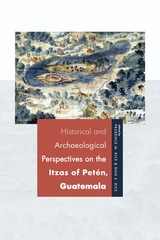 Historical and Archaeological Perspectives on the Itzas of Petén, Guatemala
Prudence M. Rice
University Press of Colorado, 2018 Historical and Archaeological Perspectives on the Itzas of Petén, Guatemala is the first exhaustively detailed and thorough account of the Itzas—a Maya group that dominated much of the western lowland area of tropical forest, swamps, and grasslands in Petén, Guatemala. Examining archaeological and historical evidence, Prudence Rice and Don Rice present a theoretical perspective on the Itzas’ origins and an overview of the social, political, linguistic, and environmental history of the area; explain the Spanish view of the Itzas during the Conquest; and explore the material culture of the Itzas as it has been revealed in recent surveys and excavations. The long but fragmented history of the Petén Itzas requires investigation across multiple periods and regions. Chapters in this six-part overview interweave varying data pertaining to this group—archaeological, artifactual, indigenous textual, Spanish historical—from multiple languages and academic fields, such as anthropology, archaeology, linguistics, ecology, and history. Part I introduces the lowland Itzas, northern and southern, with an emphasis on those of the central Petén lakes area. Part II discusses general Itza origins and identities in the Epiclassic period, while part III reviews Spanish perceptions and misconceptions of the Petén Itzas in their Contact-period writings. With these temporal anchors, parts IV and V present the archaeology and artifacts of the Petén Itzas, including pottery, architecture, and arrow points, from varied sites and excavations but primarily focusing on the island capital of Tayza/Nojpetén. Part VI summarizes key data and themes of the preceding chapters for a new understanding of the Petén Itzas. A companion volume to The Kowoj—a similar treatment of the Petén Itzas’ regional neighbors—Historical and Archaeological Perspectives on the Itzas of Petén, Guatemala demonstrates the unique physical, cultural, and social framework that was home to the Petén Itza, along with their backstory in northern Yucatán. Archaeologists, historians, art historians, and geographers who specialize in the Maya and the Postclassic, Contact, and Colonial periods will find this book of particular interest. Contributors: Mark Brenner, Leslie G. Cecil, Charles Andrew Hofling, Nathan J. Meissner, Timothy W. Pugh, Yuko Shiratori
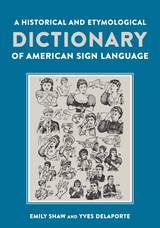 A Historical and Etymological Dictionary of American Sign Language: The Origin and Evolution of More Than 500 Signs
Emily Shaw
Gallaudet University Press, 2014 The story of how American Sign Language (ASL) came to be is almost mythic. In the early 19th century, a hearing American reverend, Thomas Hopkins Gallaudet, met a Deaf French educator, Laurent Clerc, who agreed to come to the United States and help establish the first school in America to use sign language to teach deaf children. The trail of ASL’s development meanders at this point. No documentation of early ASL was published until the late 19th century, almost seven decades after the school’s founding. While there are many missing pieces in the history of America’s sign language, plenty of data exist regarding ASL etymology. This book is the first to collect all known texts featuring illustrations of early ASL and historical images of French Sign Language—langue des signes française (LSF)—and link them with contemporary signs.
Through rigorous study of historical texts, field research in communities throughout France and the U.S., and an in-depth analysis of the cultural groups responsible for the lexicon, authors Emily Shaw and Yves Delaporte present a compelling and detailed account of the origins of over 500 ASL signs, including regional variations. Organized alphabetically by equivalent English glosses, each sign is accompanied by a succinct description of its origin and an LSF sign where appropriate. Featuring an introductory chapter on the history of the development of ASL and the etymological methodology used by the authors, this reference resource breaks new ground in the study of America’s sign language.
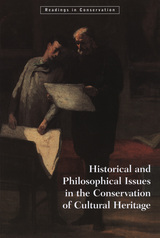 Historical and Philosophical Issues in the Conservation of Cultural Heritage
Nicholas Price
J. Paul Getty Trust, The, 1996 This volume is the first comprehensive collection of texts on the conservation of art and architecture to be published in the English language. Designed for students of art history as well as conservation, the book consists of forty-six texts, some never before translated into English and many originally published only in obscure or foreign journals.
The thirty major art historians and scholars represented raise questions such as when to restore, what to preserve, and how to maintain aesthetic character. Excerpts have been selected from the following books and essays: John Ruskin, The Seven Lamps of Architecture; Bernard Berenson, Aesthetics and History in the Visual Arts; Clive Bell, The Aesthetic Hypothesis; Cesare Brandi, Theory of Restoration; Kenneth Clark, Looking at Pictures; Erwin Panofsky, The History of Art as a Humanistic Discipline; E. H. Gombrich, Art and Illusion; Marie Cl. Berducou, The Conservation of Archaeology; and Paul Philippot, Restoration from the Perspective of the Social Sciences. The fully illustrated book also contains an annotated bibliography and an index.
 Historical and Philosophical Perspectives of Science
Roger H. Stuewer, Editor
University of Minnesota Press, 1970 Historical and Philosophical Perspectives of Science was first published in 1970. Minnesota Archive Editions uses digital technology to make long-unavailable books once again accessible, and are published unaltered from the original University of Minnesota Press editions. The series of essays published in this book, which is Volume V of the Minnesota Studies in the Philosophy of Science, are (with the exception of two essays) based on papers presented or discussed at a conference devoted to exploring the relationships between the history and the philosophy of science, held at the University of Minnesota in the fall of 1969. In a forward Peter Caws notes that the conference grew out of the deliberations of subcommittee of the U.S. National Committee for the International Union of History and Philosophy of Science. The contributors are Herbert Feigl, Ernan McMullin, Wesley C. Salmon, Peter Archinstein, Arnold Thackray, Mary Hesse, Edward Rosen, Paul K. Feyerabend, Erwin N. Hiebert, Gerd Buchdahl, Roger H. Stuewer, Howard Stein, and Kenneth F. Schaffner. Some of the papers draw philosophical conclusions from examples in the history of science; others point out the significance of philosophical insights for a study of the history of science; still others explore special aspects of the history or philosophy of science.
Historical Anthology of Music
Archibald T. Davison
Harvard University Press The long-awaited sequel to the famous volume on Oriental, Medieval, and Renaissance Music includes representative examples of the best work of the various schools of music from 1600 to 1800, together with an illuminating commentary and translations of foreign texts.
Historical Anthology of Music
Archibald T. Davison
Harvard University Press This great anthology of music literature makes available to all music lovers a wonderful storehouse of hitherto inaccessible treasure. The volume includes the development of Oriental, Medieval, and Renaissance music from the beginning to 1600. Its more than 200 representative examples are individually complete compositions, each of sufficient length to illustrate clearly a form or style. The authors provide an explanatory commentary with bibliography, English translations of foreign texts, and an index. The Library Journal says of it, "in short, Volume 1 of the music historian's classic dreams…No competitors on the market. Highly recommended."
 Historical Anthropology of the Middle Ages
Aaron Gurevich
University of Chicago Press, 1992 Aaron Gurevich has long been considered one of the world's leading medievalists and a pioneer in the field of historical anthropology. This book brings together eleven of his most important essays—many difficult to find and some never before available in English.
Gurevich's writing, while informed by the history of mentalities as practiced by the French school of Le Goff and Duby, reflects a broader view of European culture outside France. He rejects reductionist concepts and operates with a total view of culture, using a wide range of sources—legal as well as ecclesiastical, popular as well as learned, oral and visual as well as literary.
This collection amply demonstrates this breadth of Gurevich's work and highlights his ability to synthesize historical, anthropological, and semiotic approaches to culture. Especially valuable are pieces such as Gurevich's essay Wealth and Gift-Bestowal Among the Ancient Scandinavians, about the importance of gift exchange in the medieval world. One of the first studies for this practice, this classic essay has for years been unavailable. Other pieces range from the deities and heroes of Germanic poetry to the image of the Beyond in the Middle Ages.
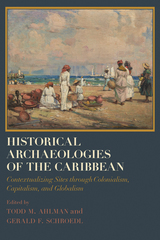 Historical Archaeologies of the Caribbean: Contextualizing Sites through Colonialism, Capitalism, and Globalism
edited by Todd M. Ahlman and Gerald F. Schroedl
University of Alabama Press, 2019 New perspectives on Caribbean historical archaeology that go beyond the colonial plantation
Historical Archaeologies of the Caribbean: Contextualizing Sites through Colonialism, Capitalism, and Globalism addresses issues in Caribbean history and historical archaeology such as freedom, frontiers, urbanism, postemancipation life, trade, plantation life, and new heritage. This collection moves beyond plantation archaeology by expanding the knowledge of the diverse Caribbean experiences from the late seventeenth through the mid-nineteenth centuries.
The essays in this volume are grounded in strong research programs and data analysis that incorporate humanistic narratives in their discussions of Amerindian, freedmen, plantation, institutional, military, and urban sites. Sites include a sample of the many different types found across the Caribbean from a variety of colonial contexts that are seldom reported in archaeological research, yet constitute components essential to understanding the full range and depth of Caribbean history.
Contributors examine urban contexts in Nevis and St. John and explore the economic connections between Europeans and enslaved Africans in urban and plantation settings in St. Eustatius. The volume contains a pioneering study of frontier exchange with Amerindians in Dominica and a synthesis of ceramic exchange networks among enslaved Africans in the Leeward Islands. Chapters on military forts in Nevis and St. Kitts call attention to this often-neglected aspect of the Caribbean colonial landscape. Contributors also directly address culture heritage issues relating to community participation and interpretation. On St. Kitts, the legacy of forced confinement of lepers ties into debates of current public health policy. Plantation site studies from Antigua and Martinique are especially relevant because they detail comparisons of French and British patterns of African enslavement and provide insights into how each addressed the social and economic changes that occurred with emancipation.
Contributors
Todd M. Ahlman / Douglas V. Armstrong / Samantha Rebovich Bardoe / Paul Farnsworth / Jeffrey R. Ferguson / R. Grant Gilmore III / Diana González-Tennant / Edward González-Tennant / Barbara J. Heath / Carter L. Hudgins Kenneth G. Kelly / Eric Klingelhofer / Roger H. Leech / Stephan Lenik / Gerald F. Schroedl / Diane Wallman / Christian Williamson
Historical Archaeology and the Latter-day Saint Past
Benjamin C. Pykles
Utah State University Press, 2025 Historical Archaeology and the Latter-day Saint Past reviews the history of archaeological investigations at sites connected to the Latter-day Saints and examines the ways archaeology has contributed to the understanding of that past. Examples from various sites, where over time archaeologists have utilized a wide range of methods, illustrate the potential of historical archaeology to confirm, complete, correct, and sometimes confuse understandings of the Latter-day Saints.
The Arrington Lecture series, established in honor of one of the twentieth-century American West’s most distinguished historians, Leonard Arrington, has become a leading forum for prominent scholars to address topics related to Latter-day Saint history. Utah State University hosts the Leonard J. Arrington Mormon History Lecture Series through the Merrill-Cazier Library’s Special Collections and Archives.
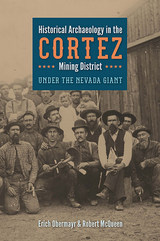 Historical Archaeology in the Cortez Mining District: Under the Nevada Giant
Erich Obermayr
University of Nevada Press, 2025 The Cortez Hills Expansion Project archaeological excavations uncovered a wealth of information about the Cortez Mining District, from its beginning in 1863 to the government-mandated end to the mining of precious metals in the district during World War II. Obermayr and McQueen use archaeological data as a foundation to tell the story of life in one of Nevada’s most intriguing, long-lived mining districts. Archaeologists excavate and analyze many thousands of artifacts, uncovering the homes and workplaces—and even trash dumps—of prospectors and miners, mill workers, charcoal burners, brickmakers, blacksmiths, teamsters, and families. They present an archaeological view of everyday life: how Cortez was populated by a variety of ethnic groups, how they lived, what products they bought or consumed, what their social status was, and how, even in this remote location, they created their own version of lives exemplifying the era’s Victorian ideals.
Readers interested in the archaeology of the West, mining history, and the history of Nevada will find this book fascinating.
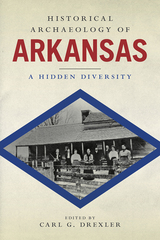 Historical Archaeology of Arkansas: A Hidden Diversity
Carl Drexler
University of Tennessee Press, 2016 Arkansas’s diverse geography, spanning the Ozark Mountains, densely forested Timberlands, and Mississippi River Delta, and its complex Native American and Euro American history belie the inattentive historical treatment the Natural State has thus far received by scholars. Often disparaged as a cultural and intellectual backwater—and indeed perhaps best known for President Bill Clinton and Wal-Mart—this overly simplified image of Arkansas shadows a state rich in historic significance and the archaeological record.
Carl G. Drexler aims to correct this bias in Historical Archaeology of Arkansas. In nine essays that range from Civil War sites to the Ozark Mountains to the nineteenth-century Jewish community, Drexler and his contributors present an Arkansas unknown to all but those dedicated individuals working to publicize the state’s hidden diversity. The research presented herein depicts a strong state and federal commitment to documenting Arkansas’s history, perhaps unmatched by any other state in America, and the success of public archaeology through the efforts of the Arkansas Archaeological Survey.
Historical Archaeology of Arkansas not only showcases the natural beauty and rich history of Arkansas, but it also serves as a primer for historical inquiry for other state and federal organizations looking to bolster their own programs.
Carl G. Drexler is the Archeological Survey's station archeologist for southwest Arkansas and a research assistant professor with the University of Arkansas. His articles have appeared in Archaeology and Historical Memory, Historical Archaeology, American Antiquity, and Field Notes.
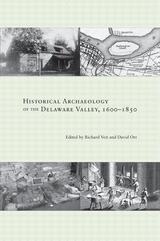 Historical Archaeology of the Delaware Valley, 1600-1850
Richard Veit
University of Tennessee Press, 2013 The Delaware Valley is a distinct region situated within the Middle Atlantic states, encompassing portions of Delaware, Pennsylvania, New Jersey, and Maryland. With its cultural epicenter of Philadelphia, its surrounding bays and ports within Maryland and Delaware, and its conglomerate population of European settlers, Native Americans, and enslaved Africans, the Delaware Valley was one of the great cultural hearths of early America. The region felt the full brunt of the American Revolution, briefly served as the national capital in the post-Revolutionary period, and sheltered burgeoning industries amidst the growing pains of a young nation. Yet, despite these distinctions, the Delaware Valley has received less scholarly treatment than its colonial equals in New England and the Chesapeake region.
In Historical Archaeology of the Delaware Valley, 1600–1850, Richard Veit and David Orr bring together fifteen essays that represent the wide range of cultures, experiences, and industries that make this region distinctly American in its diversity. From historic-period American Indians living in a rapidly changing world to an archaeological portrait of Benjamin Franklin, from an eighteenth-century shipwreck to the archaeology of Quakerism, this volume highlights the vast array of research being conducted throughout the region. Many of these sites discussed are the locations of ongoing excavations, and archaeologists and historians alike continue to debate the region’s multifaceted identity.
The archaeological stories found within Historical Archeology of the Delaware Valley, 1600–1850 reflect the amalgamated heritage that many American regions experienced, though the Delaware Valley certainly exemplifies a richer experience than most: it even boasts the palatial home of a king (Joseph Bonaparte, elder brother of Napoleon and former King of Naples and Spain). This work, thoroughly based on careful archaeological examination, tells the stories of earlier generations in the Delaware Valley and makes the case that New England and the Chesapeake are not the only cultural centers of colonial America.
 Historical Atlas of Islam
Malise Ruthven
Harvard University Press, 2004 Among the great civilizations of the world, Islam remains an enigma to Western readers. Now, in a beautifully illustrated historical atlas, noted scholar of religion Malise Ruthven recounts the fascinating and important history of the Islamic world.
From the birth of the prophet Muhammed to the independence of post-Soviet Muslim states in Central Asia, this accessible and informative atlas explains the historical evolution of Islamic societies. Short essays cover a wide variety of themes, including the central roles played by sharia (divine law) and fiqh (jurisprudence); philosophy; arts and architecture; the Muslim city; trade, commerce, and manufacturing; marriage and family life; tribal distributions; kinship and dynastic power; ritual and devotional practices; Sufism; modernist and reformist trends; the European domination of the Islamic world; the rise of the modern national state; oil exports and arms imports; and Muslim populations in non-Muslim countries, including the United States.
Lucid and inviting full-color maps chronicle the changing internal and external boundaries of the Islamic world, showing the principal trade routes through which goods, ideas, and customs spread. Ruthven traces the impact of various Islamic dynasties in art and architecture and shows the distribution of sects and religious minorities, the structure of Islamic cities, and the distribution of resources. Among the book's valuable contributions is the incorporation of the often neglected geographical and environmental factors, from the Fertile Crescent to the North African desert, that have helped shape Islamic history.
Rich in narrative and visual detail that illuminates the story of Islamic civilization, this timely atlas is an indispensable resource to anyone interested in world history and religion.
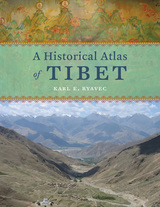 A Historical Atlas of Tibet
Karl E. Ryavec
University of Chicago Press, 2015 Cradled among the world’s highest mountains—and sheltering one of its most devout religious communities—Tibet is, for many of us, an ultimate destination, a place that touches the heavens, a place only barely in our world, at its very end. In recent decades Western fascination with Tibet has soared, from the rise of Tibetan studies in academia to the rock concerts aimed at supporting its independence to the simple fact that most of us—far from any base camp—know exactly what a sherpa is. And yet any sustained look into Tibet as a place, any attempt to find one’s way around its high plateaus and through its deep history, will yield this surprising fact: we have barely mapped it. With this atlas, Karl E. Ryavec rights that wrong, sweeping aside the image of Tibet as Shangri-La and putting in its place a comprehensive vision of the region as it really is, a civilization in its own right. And the results are absolutely stunning.
The product of twelve years of research and eight more of mapmaking, A Historical Atlas of Tibet documents cultural and religious sites across the Tibetan Plateau and its bordering regions from the Paleolithic and Neolithic times all the way up to today. It ranges through the five main periods in Tibetan history, offering introductory maps of each followed by details of western, central, and eastern regions. It beautifully visualizes the history of Tibetan Buddhism, tracing its spread throughout Asia, with thousands of temples mapped, both within Tibet and across North China and Mongolia, all the way to Beijing. There are maps of major polities and their territorial administrations, as well as of the kingdoms of Guge and Purang in western Tibet, and of Derge and Nangchen in Kham. There are town plans of Lhasa and maps that focus on history and language, on population, natural resources, and contemporary politics.
Extraordinarily comprehensive and absolutely gorgeous, this overdue volume will be a cornerstone in cartography, Asian studies, Buddhist studies, and in the libraries or on the coffee tables of anyone who has ever felt the draw of the landscapes, people, and cultures of the highest place on Earth.
HISTORICAL ATLAS OF WEST VIRGINIA
FRANK S. RIDDEL
West Virginia University Press, 2008 Few reference works are as valuable to both scholars and non-scholars as a historical atlas. Therefore, The Historical Atlas of West Virginia will be an important title for libraries, schools, and every West Virginian who wants to understand how historical forces are mapped onto the state’s terrain. This atlas also shows how the distribution of natural resources intersects with various means of distribution. Frank Riddel’s The Historical Atlas of West Virginia is copiously illustrated with maps, tables, and charts depicting everything from geological deposits and strata that have fed the state’s industries to the settlement patterns of the immigrants who settled in West Virginia. Using federal and state statistics, it also includes revelations from the national census figures since 1790.
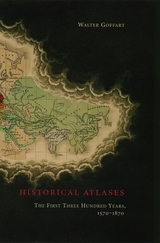 Historical Atlases: The First Three Hundred Years, 1570-1870
Walter Goffart
University of Chicago Press, 2003 Today we can walk into any well-stocked bookstore or library and find an array of historical atlases. The first thorough review of the source material, Historical Atlases traces how these collections of "maps for history"—maps whose sole purpose was to illustrate some historical moment or scene—came into being.
Beginning in the sixteenth century, and continuing down to the late nineteenth, Walter Goffart discusses milestones in the origins of historical atlases as well as individual maps illustrating historical events in alternating, paired chapters. He focuses on maps of the medieval period because the development of maps for history hinged particularly on portrayals of this segment of the postclassical, "modern" past. Goffart concludes the book with a detailed catalogue of more than 700 historical maps and atlases produced from 1570 to 1870.
Historical Atlases will immediately take its place as the single most important reference on its subject. Historians of cartography, medievalists, and anyone seriously interested in the role of maps in portraying history will find it invaluable.
 An Historical Basis for Unemployment Insurance
Industrial Industrial Relations Counselors, Inc.
University of Minnesota Press, 1934
An Historical Basis for Unemployment Insurance was first published in 1934. Minnesota Archive Editions uses digital technology to make long-unavailable books once again accessible, and are published unaltered from the original University of Minnesota Press editions.This is volume one of a two-volume study of unemployment insurance. The authors present a thorough and up-to-date analysis of systems of unemployment relief that have been tried in Great Britain, Germany, Belgium, and Switzerland, also the voluntary plans that have been worked out in the United States and the legislative plans that have been proposed. The European systems are compared with respect to basis of coverage, eligibility of the unemployed to receive benefits, source of insurance funds, amount and period of benefits, and administration. Definite trends in unemployment insurance are pointed out, and their application to proposed plans for the protection of American workers is considered. It is indispensable to all who are interested in unemployment insurance plans.
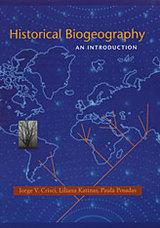 Historical Biogeography: An Introduction
Jorge V. Crisci, Liliana Katinas, and Paula Posadas
Harvard University Press, 2003 Though biogeography may be simply defined--the study of the geographic distributions of organisms--the subject itself is extraordinarily complex, involving a range of scientific disciplines and a bewildering diversity of approaches. For convenience, biogeographers have recognized two research traditions: ecological biogeography and historical biogeography.
This book makes sense of the profound revolution that historical biogeography has undergone in the last two decades, and of the resulting confusion over its foundations, basic concepts, methods, and relationships to other disciplines of comparative biology. Using case studies, the authors explain and illustrate the fundamentals and the most frequently used methods of this discipline. They show the reader how to tell when a historical biogeographic approach is called for, how to decide what kind of data to collect, how to choose the best method for the problem at hand, how to perform the necessary calculations, how to choose and apply a computer program, and how to interpret results.
Historical Comedy on Screen
Edited by Hannu Salmi
Intellect Books, 2011 In 1893 Friedrich Engels branded history “the cruelest goddess of all.” This sorrowful vision of the past is deeply rooted in the Western imagination, and history is thus presented as a joyless playground of inevitability rather than a droll world of possibilities. There are few places this is more evident than in historical cinema which tends to portray the past in a somber manner.
Historical Comedy on Screen examines this tendency paying particular attention to the themes most difficult to laugh at and exploring the place where comical and historical storytelling intersect. The book emphasizes the many oft-overlooked comical renderings of history and asks what they have to tell us if we begin to take them seriously.
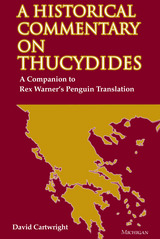 Historical Commentary on Thucydides: A Companion to Rex Warner's Penguin Translation
David Cartwright
University of Michigan Press, 1997 Much of the modern way of thinking about history and historiography in fact begins with the great Greek historian Thucydides, an Athenian general in the latter half of the fifth century b.c.e. It is also Thucydides who provides us with the historical framework for fifth-century Greece, a period of progress and creativity rarely equaled in human history. His work, The Peloponnesian War, recounts that destructive conflict and also includes the only surviving contemporary record of the rise of the Athenian empire. Thucydides teaches his readers that the most powerful states in the world can come to a humiliating end, that a careless tyranny, especially toward the weak, and, nearly two millennia before Machiavelli, that absolute power corrupts absolutely. In A Historical Commentary on Thucydides, David Cartwright aims to guide the Greekless reader through Thucydides' fascinating yet demanding narrative. Cartwright's is the only such full-length, one-volume commentary and companion: it is based on Rex Warner's Penguin translation of Thucydides--the most widely used translation--and requires no knowledge of Greek. The introduction to A Historical Commentary on Thucydides includes a brief biography of Thucydides: his approach, aims, and methods are discussed, as are the general character of his work and his contribution to historiography. The commentary gives brief accounts of the people and places mentioned by Thucydides and puts events in their immediate and wider contexts. Cartwright provides occasional summaries, explains Greek concepts and technical terms, and offers interpretations of difficult or controversial passages. The author also picks out important historiographical issues and discusses the themes' underlying events. For both first-time readers and seasoned students, this commentary gives broad access to one of antiquity's most profound and difficult writers. Historians, classicists, and anyone else interested in the cultural and intellectual achievements of ancient Greece will find A Historical Commentary on Thucydides a welcome addition to their library. David Cartwright is Head of Classics at Dulwich College, London, England.
 The Historical Construction of National Consciousness: Selected Writings
Jeno Szucs
Central European University Press, 2022 A long essay entitled Three Historical Regions of Europe, appearing first in a samizdat volume in Budapest in 1980, instantly put its author into the forefront of the transnational debate on Central Europe, alongside such intellectual luminaries as Milan Kundera and Czesław Miłosz. The present volume offers English-language readers a rich selection of the depth and breadth of the legacy of Jenő Szűcs (1928–1988). The selection documents Szűcs’s seminal contribution to many contemporary debates in historical anthropology, nationalism studies, and conceptual history. It contains his key texts on the history of national consciousness and patterns of collective identity, as well as medieval and early modern political thought. The works published here, most of them previously unavailable in English, provide a sophisticated analysis of a wide range of subjects from the myths of origins of Hungarians before Christianization to the political and religious ideology of the Dózsa peasant uprising in 1514, the medieval roots of civil society, or the revival of ethnic nationalism during the communist era. The volume, with an introduction by the editors locating Szűcs in a transnational context, offers a unique insight into the complex and sensitive debate on national identity in post-1945 East Central Europe.
The Historical Dimensions of Irish Catholicism
Emmet J. Larkin
Catholic University of America Press, 1984 In three short essays (first published as articles in The American Historical Review), Larkin analyzes the economic, social, and political context of nineteenth-century Ireland.
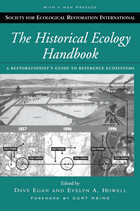 The Historical Ecology Handbook: A Restorationist's Guide to Reference Ecosystems
Edited by Dave Egan and Evelyn A. Howell; Foreword by Curt Meine
Island Press, 2005 The Historical Ecology Handbook makes essential connections between past and future ecosystems, bringing together leading experts to offer a much-needed introduction to the field of historical ecology and its practical application by on-the-ground restorationists. Chapters present individual techniques focusing on both culturally derived evidence and biological records, with each chapter offering essential background, tools, and resources needed for using the technique in a restoration effort. The book ends with four in-depth case studies that demonstrate how various combinations of techniques have been used in restoration projects. The Historical Ecology Handbook is a unique and groundbreaking guide to determining historic reference conditions of a landscape. It offers an invaluable compendium of tools and techniques, and will be essential reading for anyone working in the field of ecological restoration.
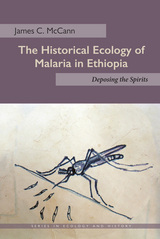 The Historical Ecology of Malaria in Ethiopia: Deposing the Spirits
James C. McCann
Ohio University Press, 2015 Malaria is an infectious disease like no other: it is a dynamic force of nature and Africa’s most deadly and debilitating malady. James C. McCann tells the story of malaria in human, narrative terms and explains the history and ecology of the disease through the science of landscape change. All malaria is local. Instead of examining the disease at global or continental scale, McCann investigates malaria’s adaptation and persistence in a single region, Ethiopia, over time and at several contrasting sites. Malaria has evolved along with humankind and has adapted to even modern-day technological efforts to eradicate it or to control its movement. Insecticides, such as DDT, drug prophylaxis, development of experimental vaccines, and even molecular-level genetic manipulation have proven to be only temporary fixes. The failure of each stand-alone solution suggests the necessity of a comprehensive ecological understanding of malaria, its transmission, and its persistence, one that accepts its complexity and its local dynamism as fundamental features. The story of this disease in Ethiopia includes heroes, heroines, witches, spirits—and a very clever insect—as well as the efforts of scientists in entomology, agroecology, parasitology, and epidemiology. Ethiopia is an ideal case for studying the historical human culture of illness, the dynamism of nature’s disease ecology, and its complexity within malaria.
Historical Evidence and Argument
David Henige
University of Wisconsin Press, 2005 Historians know about the past because they examine the evidence. But what exactly is “evidence,” how do historians know what it means—and how can we trust them to get it right? Historian David Henige tackles such questions of historical reliability head-on in his skeptical, unsparing, and acerbically witty Historical Evidence and Argument. “Systematic doubt” is his watchword, and he practices what he preaches through a variety of insightful assessments of historical controversies—for example, over the dating of artifacts and the textual analysis of translated documents. Skepticism, Henige contends, forces us to recognize the limits of our knowledge, but is also a positive force that stimulates new scholarship to counter it.
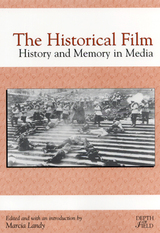 The Historical Film: History and Memory in Media
Landy, Marcia
Rutgers University Press, 2000 What is history? How do we represent it? How do our notions of history change over time? The essays in The Historical Film: History and Memory in Media probe the roles that cinema and television play in altering and complicating our understanding of historical events. The book brings together representative examples of how both media critics and historians write about history as it is created and disseminated through film and television. The essays explore what is at stake culturally and politically in media history and how this form of history-making is different from traditional historiography. The volume is divided into four parts--Regarding History; History as Trauma; History, Fiction, and Postcolonial Memory; and History and Television--that progressively deepen our understanding of just how complex the issues are. Essays by top scholars analyze many different kinds of film: historical film, documentary, costume drama, and heritage films. The section on television is equally broad, examining phenomena as diverse as news broadcasts and Ken Burns's documentary The Civil War. Contributors are Mbye Cham, George F. Custen, Mary Ann Doane, Richard Dienst, Taylor Downing, Gary Edgerton, Naomi Greene, Miriam Bratu Hansen, Sue Harper, Sumiko Higashi, Anton Kaes, Marcia Landy, Shawn Rosenheim, Robert A. Rosenstone, Pierre Sorlin, Maria Wyke, and Ismail Xavier.
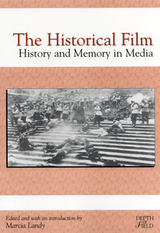 The Historical Film: History and Memory in Media
Landy, Marcia
Rutgers University Press, 2000 What is history? How do we represent it? How do our notions of history change over time? The essays in The Historical Film: History and Memory in Media probe the roles that cinema and television play in altering and complicating our understanding of historical events. The book brings together representative examples of how both media critics and historians write about history as it is created and disseminated through film and television. The essays explore what is at stake culturally and politically in media history and how this form of history-making is different from traditional historiography. The volume is divided into four parts--Regarding History; History as Trauma; History, Fiction, and Postcolonial Memory; and History and Television--that progressively deepen our understanding of just how complex the issues are. Essays by top scholars analyze many different kinds of film: historical film, documentary, costume drama, and heritage films. The section on television is equally broad, examining phenomena as diverse as news broadcasts and Ken Burns's documentary The Civil War. Contributors are Mbye Cham, George F. Custen, Mary Ann Doane, Richard Dienst, Taylor Downing, Gary Edgerton, Naomi Greene, Miriam Bratu Hansen, Sue Harper, Sumiko Higashi, Anton Kaes, Marcia Landy, Shawn Rosenheim, Robert A. Rosenstone, Pierre Sorlin, Maria Wyke, and Ismail Xavier.
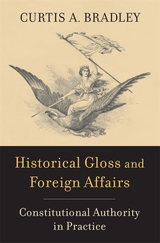 Historical Gloss and Foreign Affairs: Constitutional Authority in Practice
Curtis A. Bradley
Harvard University Press, 2024 A new interpretation of the constitutional law of foreign affairs, as it has been developed throughout its history by presidents and by Congress.
In the more than 230 years since the Constitution took effect, the constitutional law governing the conduct of foreign affairs has evolved significantly. But that evolution did not come through formal amendments or Supreme Court rulings. Rather, the law has been defined by the practices of Congress and the executive branch, also known as “historical gloss.”
Curtis A. Bradley documents this process in action. He shows that expansions in presidential power over foreign affairs have often been justified by reference to historical gloss, but that Congress has not merely stepped aside. Belying conventional accounts of the “imperial presidency” in foreign affairs, Congress has also benefited from gloss, claiming powers for itself in the international arena not clearly addressed in the constitutional text and disrupting claims of exclusive presidential authority.
Historical Gloss and Foreign Affairs proposes a constitutional theory that can make sense of these legal changes. In contrast, originalist theories of constitutional interpretation often ignore influential post-Founding developments, while nonoriginalist theories tend to focus on judicial decisions rather than the actions and reasoning of Congress and the executive branch. Moreover, the constitutional theories that do focus on practice have typically emphasized changes at particular moments in time. What we see in the constitutional law of foreign affairs, however, is the long-term accumulation of nonjudicial precedents that is characteristic of historical gloss. With gloss confirmed as a prime mover in the development of foreign affairs law, we can begin to recognize its broader status as an important and longstanding form of constitutional reasoning.
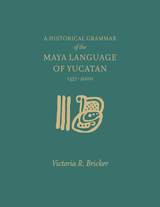 A Historical Grammar of the Maya Language of Yucatan: 1557-2000
Victoria R. Bricker
University of Utah Press, 2018 Victoria Bricker’s painstaking work is based on almost one thousand provenienced notarial documents and letters written by native speakers of Yucatec Maya from colonial times to the modern day. Because the documents are dated and also specify the town where they were written, Bricker was able to determine when and where grammatical changes first appeared in the language and the trajectory of their movement across the Yucatan peninsula. This exemplary grammar of Yucatec Maya includes examples and careful explanations of the phonological, morphological, and syntactic structures of the language. Bricker’s research is distinguished in its treatment of seemingly aberrant spellings of Maya words as clues to the way they were actually pronounced at different times in the past. Her chapters include topics seldom covered, such as deictic particles, affects, and reduplication. Of special interest is a poetic form of reduplication composed of couplets (or triplets) found in documents from each of the centuries, indicating the continuity of this genre from the Colonial to the Modern version of this language.
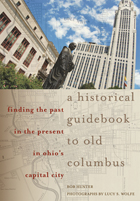 A Historical Guidebook to Old Columbus: Finding the Past in the Present in Ohio’s Capital City
Bob Hunter
Ohio University Press, 2012 Ever look at a modern skyscraper or a vacant lot and wonder what was there before? Or maybe you have passed an old house and been curious about who lived there long ago. This richly illustrated new book celebrates Columbus, Ohio’s, two-hundred-year history and supplies intriguing stories about the city’s buildings and celebrated citizens, stopping at individual addresses, street corners, parks, and riverbanks where history was made. As Columbus celebrates its bicentennial in 2012, a guide to local history is very relevant. Like Columbus itself, the city’s history is underrated. Some events are of national importance; no one would deny that Abraham Lincoln’s funeral procession down High Street was a historical highlight. But the authors have also included a wealth of social and entertainment history from Columbus’s colorful history as state capital and destination for musicians, artists, and sports teams. The book is divided into seventeen chapters, each representing a section of the city, including Statehouse Square, German Village, and Franklinton, the city’s original settlement in 1797. Each chapter opens with an entertaining story that precedes the site listings. Sites are clearly numbered on maps in each section to make it easy for readers to visit the places that pique their interest. Many rare and historic photos are reproduced along with stunning contemporary images that offer insight into the ways Columbus has changed over the years. A Historical Guidebook to Old Columbus invites Columbus’s families to rediscover their city with a treasure trove of stories from its past and suggests to visitors and new residents many interesting places that they might not otherwise find. This new book is certain to amuse and inform for years to come.
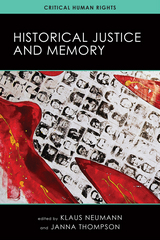 Historical Justice and Memory
Edited by Klaus Neumann and Janna Thompson
University of Wisconsin Press, 2015 Historical Justice and Memory highlights the global movement for historical justice—acknowledging and redressing historic wrongs—as one of the most significant moral and social developments of our times. Such historic wrongs include acts of genocide, slavery, systems of apartheid, the systematic persecution of presumed enemies of the state, colonialism, and the oppression of or discrimination against ethnic or religious minorities.
The historical justice movement has inspired the spread of truth and reconciliation processes around the world and has pushed governments to make reparations and apologies for past wrongs. It has changed the public understanding of justice and the role of memory. In this book, leading scholars in philosophy, history, political science, and semiotics offer new essays that discuss and assess these momentous global developments. They evaluate the strength and weaknesses of the movement, its accomplishments and failings, its philosophical assumptions and social preconditions, and its prospects for the future.
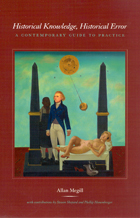 Historical Knowledge, Historical Error: A Contemporary Guide to Practice
Allan Megill
University of Chicago Press, 2006 In the past thirty years, historians have broadened the scope of their discipline to include many previously neglected topics and perspectives. They have chronicled language, madness, gender, and sexuality and have experimented with new forms of presentation. They have turned to the histories of non-Western peoples and to the troubled relations between “the West” and the rest. Allan Megill welcomes these developments, but he also suggests that there is now confusion among historians about what counts as a justified account of the past.
In Historical Knowledge, Historical Error, Megill dispels some of the confusion. Here, he discusses issues of narrative, objectivity, and memory. He attacks what he sees as irresponsible uses of evidence while accepting the art of speculation, which incomplete evidence forces upon historians. Along the way, he offers succinct accounts of the epistemological road historians have traveled from Herodotus and Thucydides through Leopold von Ranke and Alexis de Tocqueville, and on to Hayden White, Natalie Zemon Davis, and Lynn Hunt.
Historical Linguistics and Biblical Hebrew: Steps Toward an Integrated Approach
Robert Rezetko
SBL Press, 2014
A philologically robust approach to the history of ancient Hebrew
In this book the authors work toward constructing an approach to the history of ancient Hebrew that overcomes the chasm of academic specialization. The authors illustrate how cross-textual variable analysis and variation analysis advance research on Biblical Hebrew and correct theories based on extra-linguistic assumptions, intuitions, and ideologies by focusing on variation of forms/uses in the Masoretic text and variation between the Masoretic text and other textual traditions.
Features:
- A unique approach that examines the nature of the sources and the description of their language together
- Extensive bibliography for further research
- Tables of linguistic variables and parallels
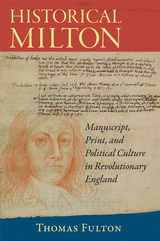 Historical Milton: Manuscript, Print, and Political Culture in Revolutionary England
Thomas Fulton
University of Massachusetts Press, 2010 John Milton's Commonplace Book is the only known political notebook of a radical polemicist writing during the English civil war, and the most extensive manuscript record of reading we have from any major English poet from this period. In this rethinking of a surprisingly neglected body of evidence, Thomas Fulton explores Milton's reading practices and the ways he used this reading in his writing. Fulton's close study of the Commonplace Book suggests that this reading record is far from the haphazard collection of notes that it first appears but is instead a program of research which had its own ideology that responded to the reading habits and practices of Milton's contemporaries. Created mostly in the late 1630s and during the overthrow of the Stuart government in the 1640s, Milton's reading notes yield a number of surprises, the most fundamental being a highly structured commitment to political history. Fulton explores the relationship between the manuscript author and his polemical persona, placing the Commonplace Book, the manuscript "Digression" to the History of Britain, and some wartime poems in revealing contrast to the printed political texts of this period.
 Historical Miscellany
Aelian
Harvard University Press, 1997 A literary cabinet of curiosities.
Aelian’s Historical Miscellany is a pleasurable example of light reading for Romans of the early third century. Offering engaging anecdotes about historical figures, retellings of legendary events, and enjoyable descriptive pieces—in sum: amusement, information, and variety—Aelian’s collection of nuggets and narratives could be enjoyed by a wide reading public. A rather similar book had been published in Latin in the previous century by Aulus Gellius; Aelian is a late, perhaps the last, representative of what had been a very popular genre.
Here then are anecdotes about the famous Greek philosophers, poets, historians, and playwrights; myths instructively retold; moralizing tales about heroes and rulers, athletes and wise men; reports about styles in dress, food and drink, lovers, gift-giving practices, entertainments, religious beliefs and death customs; and comments on Greek painting. Some of the information is not preserved in any other source. Underlying it all are Aelian’s Stoic ideals as well as this Roman’s great admiration for the culture of the Greeks (whose language he borrowed for his writings).
The Historical Miscellany is now added to the Loeb Classical Library, the Greek text facing a skillful and helpfully annotated new translation by Nigel Wilson. In his trenchant Introduction he discusses the literary genre of Aelian’s miscellany, its style and historical setting.
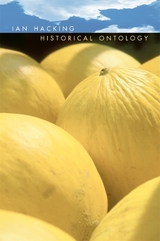 Historical Ontology
Ian Hacking
Harvard University Press, 2004 With the unusual clarity, distinctive and engaging style, and penetrating insight that have drawn such a wide range of readers to his work, Ian Hacking here offers his reflections on the philosophical uses of history. The focus of this volume, which collects both recent and now-classic essays, is the historical emergence of concepts and objects, through new uses of words and sentences in specific settings, and new patterns or styles of reasoning within those sentences. In its lucid and thoroughgoing look at the historical dimension of concepts, the book is at once a systematic formulation of Hacking’s approach and its relation to other types of intellectual history, and a valuable contribution to philosophical understanding.
Hacking opens the volume with an extended meditation on the philosophical significance of history. The importance of Michel Foucault—for the development of this theme, and for Hacking’s own work in intellectual history—emerges in the following chapters, which place Hacking’s classic essays on Foucault within the wider context of general reflections on historical methodology. Against this background, Hacking then develops ideas about how language, styles of reasoning, and “psychological” phenomena figure in the articulation of concepts—and in the very prospect of doing philosophy as historical ontology.
Historical Perspectives on Contemporary East Asia
Merle Goldman
Harvard University Press, 2000 Historical Perspectives on Contemporary East Asiaaddresses provocative themes concerning the experience of particular nations and of East Asia as a whole. It explores the turbulent process of integrating Asian societies and political systems into a global order dominated by the West over the past two centuries.
The authors show that important changes were already underway before the western advance, which had their own internal logic and staying power. They describe how people in China, Japan, and Korea redefined and defended indigenous "traditions" even as they disagreed over what these traditions were and how to transform them. They make it clear that nationalism was a powerful motivating force in the modern development of these countries, but they stress that a wide variety of nationalisms emerged and collided in the dramatic history of modern Asia.
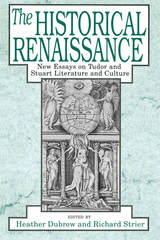 The Historical Renaissance: New Essays on Tudor and Stuart Literature and Culture
Edited by Heather Dubrow and Richard Strier
University of Chicago Press, 1988 The Historical Renaissance both exemplifies and examines the most influential current in contemporary studies of the English Renaissance: the effort to analyze the interplay between literature, history, and politics. The broad and varied manifestations of that effort are reflected in the scope of this collection. Rather than merely providing a sampler of any single critical movement, The Historical Renaissance represents the range of ways scholars and critics are fusing what many would once have distinguished as "literary" and "historical" concerns
The volume includes studies of mid-Tudor culture as well as of Elizabethan and Stuart periods. The scope of the collection is also manifest in its list of contributors. They include historians and literary critics, and their work spans he spectrum from more traditional methods to those characteristic of what has been termed "New Historicism."One aim of the book is to investigate the apparent division between these older and more current approaches. Heather Dubrow and Richard Strier evaluate the contemporary interest in historical studies of the Renaissance, relating it to previous developments in the field, surveying its achievements and limitations, and suggesting new directions for future work.
Historical Roots of the Old Testament (1200-63 BCE)
Richard D. Nelson
SBL Press, 2014 A thorough overview of the history of ancient Israel for research and classroom use
Richard D. Nelson charts the beginning of the Iron Age and the emergence of Israel and its literature, including the kingdoms of Israel and Judah, the downfall of Israel, Judah in the Assyrian and Babylonian periods, Yehud and Persia, and the Hellenistic period. Each chapter provides a summary of the period under consideration, a historical reconstruction of the period, based on biblical and extrabiblical evidence; a critical study of the biblical literature deriving from or associated with the period, and theological conclusions that readers may draw from the relevant biblical texts.
Features:
- Balanced coverage of controversial topics
- Extensive bibliographies at the beginning of each chapter
- Lists of rulers and key dates for reference and classroom use
 A Historical Taxonomy of Talking Birds in Chinese Literature
Wilt L. Idema
Harvard University Press, 2025 Parrots and mynahs have played a unique role in Chinese literature for two millennia. These birds that can talk and interact intelligently with their owners were treasured as pets both in the palace and in private homes. The caged birds were pitied for their homesickness but praised for their eagerness to serve. Over time they developed into exemplars of Confucian values such as filial piety and loyalty, and they also featured prominently in tales of love and war. Closely associated with Buddhism from early on, the parrot proved itself an effective preacher of the Dharma and became the favorite bird of the bodhisattva Guanyin.
In this wide-ranging thematic study Wilt L. Idema traces the development of the parrot and the mynah as characters in many forms of poetry and prose of Chinese elite literature, as well as in the long narrative ballads of traditional popular literature. The book provides complete renditions of Mi Heng’s (173–198) Rhapsody on the Parrot, the anonymous Tale of the Parrot’s Filial Piety of the fifteenth century, and the anonymous Precious Scroll of the Parrot of late-imperial times. An epilogue discusses the disappearance of the parrot in modern Chinese literature.
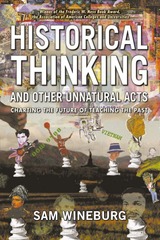 Historical Thinking
Sam Wineburg
Temple University Press, 2001 Since ancient times, the pundits have lamented young people's lack of historical knowledge and warned that ignorance of the past surely condemns humanity to repeating its mistakes. In the contemporary United States, this dire outlook drives a contentious debate about what key events, nations, and people are essential for history students. Sam Wineburg says that we are asking the wrong questions. This book demolishes the conventional notion that there is one true history and one best way to teach it.
Although most of us think of history -- and learn it -- as a conglomeration of facts, dates, and key figures, for professional historians it is a way of knowing, a method for developing and understanding about the relationships of peoples and events in the past. A cognitive psychologist, Wineburg has been engaged in studying what is intrinsic to historical thinking, how it might be taught, and why most students still adhere to the "one damned thing after another" concept of history.
Whether he is comparing how students and historians interpret documentary evidence or analyzing children's drawings, Wineburg's essays offer "rough maps of how ordinary people think about the past and use it to understand the present." Arguing that we all absorb lessons about history in many settings -- in kitchen table conversations, at the movies, or on the world-wide web, for instance -- these essays acknowledge the role of collective memory in filtering what we learn in school and shaping our historical thinking.
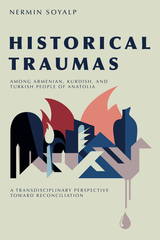 Historical Traumas among Armenian, Kurdish, and Turkish People of Anatolia: A Transdisciplinary Perspective toward Reconciliation
Nermin Soyalp
Sussex Academic Press, 2022 The deep wounds that exist from long-standing conflicts between Turks, Kurds, and Armenians have not yet been sufficiently addressed and healed. Nermin Soyalp explains the collective traumas and their significant psychosocial impacts in terms of the potential for reconciliation among these politically conflicted groups. Discussion centers on the transgenerational implications of the Balkan wars of 19121913, the Armenian genocide of 19151917, the Greco-Turco war of 19201922, the formation of the Republic of Turkey in 1923, the population exchange with the Balkans in 1924, the conflict between the Turkish government and Kurdish identity since the formation of the Republic, as well as the impacts of assimilation policies on minorities. Drawing on the complexities of history, psychology, and identity, this book elucidates how collectively and historically shared traumas become inherently more complex, and more difficult to address, generation by generation. Epistemologies of ignorance in Turkey have suppressed the transgenerational experiences of trauma and prevented healing modalities. The Turkish state and society have consciously and unconsciously denied historical realities such as the Armenian genocide and Kurds ethnopolitical rights. The result is a collective dehumanization that fuels further trauma and conflicts. The collective traumas of Anatolia have impacted its society at multiple levels - psychological, physical, economic, cultural, political, and institutional. The author, a dialogue facilitator for the nonprofit Healing the Wounds of History organization, proposes systemic healing modalities that address the dynamics at play. The research that underpins this work is highly relevant to the healing of other historical and cultural traumas.
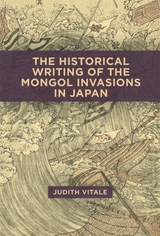 The Historical Writing of the Mongol Invasions in Japan
Judith Vitale
Harvard University Press, 2024 The myth that kamikaze, or divine winds, protected Japan against the Mongol invasions of 1274 and 1281 is linked to a belief in absolute victory in the Pacific War in the twentieth century. But what was the representation of a historical past in Japan, and what role did it play as a repertoire of cultural identity before the rise of hyper-nationalism?
The Historical Writing of the Mongol Invasions in Japan is about the names for Japan and the Mongols, the commemoration of battle sites and ancestors, and the antiquarian exchanges within confined circles in the seventeenth and eighteenth centuries. In the Tokugawa culture of appearances, historical writing and related genres affirmed status identity. In the first two-thirds of the nineteenth century, the exploits of thirteenth-century warriors served as a model for propagating revolutionary change in Japanese cities, whereas in the 1880s and 1890s, conservative associations appropriated the defense against the Mongol invasions as a symbol of patriotism. The Historical Writing of the Mongol Invasions in Japan thus points to the continuities and ruptures that marked the emergence of a national culture after the Meiji Restoration of 1868.
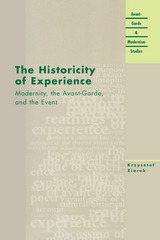 The Historicity of Experience: Modernity, the Avant-Garde, and the Event
Krysztof Ziarek
Northwestern University Press, 2001 In this groundbreaking volume, Krzysztof Ziarek rethinks modern experience by bringing together philosophical critiques of modernity and avant-garde poetry. Ziarek explores, through selective readings of avant-garde poetry, the key aspects of the radical critique of experience: technology, everydayness, event, and sexual difference. To that extent, The Historicity of Experience is less a book about the avant-garde than a critique of experience through the avant-garde. Ziarek reads the avant-garde in dialogue with the work of some of the major critics of modernity (Martin Heidegger, Walter Benjamin, Jean-François Lyotard, and Luce Irigaray) to show how avant-garde experiments bear critically on the issue of modern experience and its technological organization.
The four poets Ziarek considers—Gertrude Stein, Velimir Khlebnikov, Miron Biaoszewski, and Susan Howe—demonstrate the broad reach of and variety of forms taken by the avant-garde revision of experience and aesthetics. Moreover, this quartet illustrates how the main operative concepts and strategies of the avant-garde underpinned the practices of canonical writers. A profound philosophical meditation on language, modernity, and the everyday, The Historicity of Experience offers a fundamental reconceptualization of the avant-garde in relation to experience.
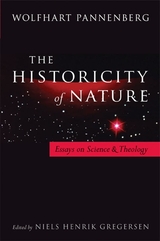 Historicity of Nature: Essays on Science and Theology
Wolfhart Pannenberg
Templeton Press, 2008
Known as one of the most outstanding theologians of the twentieth century, Wolfhart Pannenberg is also considered a great interdisciplinary thinker. Now, essays and articles on science and theology that are central to understanding Pannenberg's theories have been collected into one volume.
Niels Henrik Gregersen, a former student of Pannenberg and now professor of systematic theology at Copenhagen University, has compiled the writings in four sections: Methodology, Creation and Nature's Historicity, Religion and Anthropology, and Meaning and Metaphysics. Included in this volume are:
•Translations of Pannenberg's principled argument for the consonance between science and religion, including contingency and laws of nature, field theories and space-time, and divine action
•Translations of Pannenberg's theory of theology as a rational hypothetical science, including his discussions with leading British and American scholars such as A. N. Whitehead, John Cobb, and Langdon Gilkey
•Previously unpublished articles on the problems between science and theology in the course of modern history, explaining why chance may be more important for theology than design
•Translations of seminal articles that articulate Pannenberg's understanding of the role of religion in human nature
•One of the few theological articles on aggression as a psychological and social phenomenon
With this collection, the essays of this important contemporary theologian and his illuminating views are presented in one convenient volume.
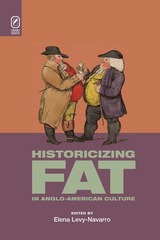 Historicizing Fat in Anglo-American Culture
Edited by Elena Levy-Navarro
Ohio State University Press, 2010 Historicizing Fat in Anglo-American Culture, edited by Elena Levy-Navarro, is the first collection of essays to offer a historical consideration of fat bodies in Anglophone culture. The interdisciplinary essays cover periods from the medieval to the contemporary, mapping out a new terrain for historical consideration. These essays question many of the commonplace assumptions that circulate around the category of fat: that fat exists as a natural and transhistorical category; that a premodern period existed which universally celebrated fat and knew no fatphobia; and that the thin, youthful body, as the presumptively beautiful and healthy one, should be the norm by which to judge other bodies.
The essays begin with a consideration of the interrelationship between the rise of weight-watching and the rise of the novel. The essays that follow consider such wide-ranging figures as the fat child’s body as a contested site in post-Blair U.K. and in Lord of the Flies; H. G. Wells; Wilkie Collins’s subversively performative Fosco; Ben Jonson; the voluptuous Lillian Russell; Shakespeare’s Venus and Adonis; the opera diva; and the fat feminist activists of recent San Francisco. In developing their histories in a self-conscious way that addresses the pervasive fatphobia of the present-day Anglophone culture, Historicizing Fat suggests ways in which scholarship and criticism in the humanities can address, resist, and counteract the assumptions of late modern culture.
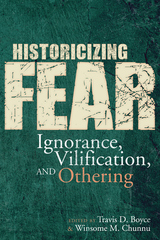 Historicizing Fear: Ignorance, Vilification, and Othering
Travis D. Boyce
University Press of Colorado, 2019 Historicizing Fear is a historical interrogation of the use of fear as a tool to vilify and persecute groups and individuals from a global perspective, offering an unflinching look at racism, fearful framing, oppression, and marginalization across human history.The book examines fear and Othering from a historical context, providing a better understanding of how power and oppression is used in the present day.
Contributors ground their work in the theory of Othering—the reductive action of labeling a person as someone who belongs to a subordinate social category defined as the Other—in relation to historical events, demonstrating that fear of the Other is universal, timeless, and interconnected. Chapters address the music of neo-Nazi white power groups, fear perpetuated through the social construct of black masculinity in a racially hegemonic society, the terror and racial cleansing in early twentieth-century Arkansas, the fear of drug-addicted Vietnam War veterans, the creation of fear by the Tang Dynasty, and more.
Timely, provocative, and rigorously researched, Historicizing Fear shows how the Othering of members of different ethnic groups has been used to propagate fear and social tension, justify state violence, and prevent groups or individuals from gaining equality. Broadening the context of how fear of the Other can be used as a propaganda tool, this book will be of interest to scholars and students of history, anthropology, political science, popular culture, critical race issues, social justice, and ethnic studies, as well as the general reader concerned with the fearful framing prevalent in politics.
Contributors:
Quaylan Allen, Melanie Armstrong, Brecht De Smet, Kirsten Dyck, Adam C. Fong, Jeff Johnson, Łukasz Kamieński, Guy Lancaster, Henry Santos Metcalf, Julie M. Powell, Jelle Versieren
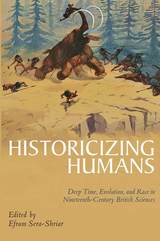 Historicizing Humans: Deep Time, Evolution, and Race in Nineteenth-Century British Sciences
Efram Sera-Shriar
University of Pittsburgh Press, 2018 With an Afterword by Theodore Koditschek
A number of important developments and discoveries across the British Empire's imperial landscape during the nineteenth century invited new questions about human ancestry. The rise of secularism and scientific naturalism; new evidence, such as skeletal and archaeological remains; and European encounters with different people all over the world challenged the existing harmony between science and religion and threatened traditional biblical ideas about special creation and the timeline of human history. Advances in print culture and voyages of exploration also provided researchers with a wealth of material that contributed to their investigations into humanity’s past.
Historicizing Humans takes a critical approach to nineteenth-century human history, as the contributors consider how these histories were shaped by the colonial world, and for various scientific, religious, and sociopolitical purposes. This volume highlights the underlying questions and shared assumptions that emerged as various human developmental theories competed for dominance throughout the British Empire.
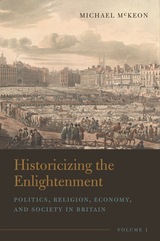 Historicizing the Enlightenment, Volume 1: Politics, Religion, Economy, and Society in Britain
Michael McKeon
Bucknell University Press, 2023 The Enlightenment has been blamed for some of the most deadly developments of modern life: racism and white supremacy, imperialist oppression, capitalist exploitation, neoliberal economics, scientific positivism, totalitarian rule. These developments are thought to have grown from principles that are rooted in the soil of the Enlightenment: abstraction, reduction, objectification, quantification, division, universalization. Michael McKeon’s new book corrects this defective view by historicizing the Enlightenment--by showing that the Enlightenment has been abstracted from its history. From its past: critics have ignored that Enlightenment thought is a reaction against deadly traditions that precede it. From its present: the Enlightenment extended its reactive analysis of the past to its own present through self-analysis and self-criticism. From its future: much of what’s been blamed amounts to the failure of its posterity to sustain Enlightenment principles. To historicize the Enlightenment requires that we conjure what it was like to live through the emergence of concepts and practices that are now commonplace—society, privacy, the public, the market, experiment, secularity, representative democracy, human rights, social class, sex and gender, fiction, the aesthetic attitude. McKeon’s book argues the continuity of Enlightenment thought, its consistency and integrity across this broad range of conceptual domains. It also shows how the Enlightenment has shaped our views of both tradition and modernity, and the revisionary work that needs to be done in order to understand our place in the future. In the process, Historicizing the Enlightenment exemplifies a distinctive historiography and historical method.
Published by Bucknell University Press. Distributed worldwide by Rutgers University Press.
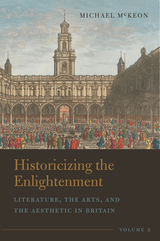 Historicizing the Enlightenment, Volume 2: Literature, the Arts, and the Aesthetic in Britain
Michael McKeon
Bucknell University Press, 2023 Enlightenment critics from Dryden through Johnson and Wordsworth conceived the modern view that art and especially literature entails a double reflection: a reflection of the world, and a reflection on the process by which that reflection is accomplished. Instead “neoclassicism” and “Augustanism” have been falsely construed as involving a one-dimensional imitation of classical texts and an unselfconscious representation of the world. In fact these Enlightenment movements adopted an oblique perspective that registers the distance between past tradition and its present reenactment, between representation and presence. Two modern movements, Romanticism and modernism, have appropriated as their own these innovations, which derive from Enlightenment thought. Both of these movements ground their error in a misreading of “imitation” as understood by Aristotle and his Enlightenment proponents. Rightly understood, neoclassical imitation, constitutively aware of the difference between what it knows and how it knows it, is an experimental inquiry that generates a range of prefixes—“counter-,” “mock-,” “anti-,” “neo-”—that mark formal degrees of its epistemological detachment. Romantic ideology has denied the role of the imagination in Enlightenment imitation, imposing on the eighteenth century a dichotomous periodization: duplication versus imagination, the mirror versus the lamp. Structuralist ideology has dichotomized narration and description, form and content, structure and history. Poststructuralist ideology has propounded for the novel a contradictory “novel tradition”—realism, modernism, postmodernism, postcolonialism—whose stages both constitute a sequence and collapse it, each stage claiming the innovation of the stage that precedes it.
Published by Bucknell University Press. Distributed worldwide by Rutgers University Press.
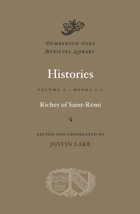 Histories
Richer of Saint-Rémi
Harvard University Press, 2011 The Historia of Richer of Saint-Rémi (ca. 950–ca. 1000), an invaluable source for understanding tenth-century West Francia (present-day France), provides a rare contemporary account of the waning Carolingian dynasty, accession of Hugh Capet, and failed rebellion of Charles of Lorraine. Beginning in 888, the Historia surveys a tumultuous century in which two competing dynasties struggled for supremacy, while great magnates seized upon the opportunity to carve out their own principalities. Richer’s descriptive talents are on display as he tells of synods and coronations, deception and espionage, battles and sieges, disease and death, and even the difficulties of travel.
The Historia also sheds light on a controversial figure of the Middle Ages, the legendary cleric and scholar Gerbert of Aurillac. Gerbert, the dedicatee of the Historia, rose from humble beginnings to become archbishop of Rheims, archbishop of Ravenna, and eventually pope (as Sylvester II). The Historia contains a fascinating description of his teaching at the cathedral school of Rheims, where his innovations involved instruments such as the monochord, armillary sphere, and abacus.
Translated into English here for the first time, the Historia holds particular attractions for historians and for anyone interested in the cultural and intellectual developments in the Latin West around the year 1000.
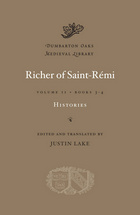 Histories
Richer of Saint-Rémi
Harvard University Press, 2011 The Historia of Richer of Saint-Rémi (ca. 950–ca. 1000), an invaluable source for understanding tenth-century West Francia (present-day France), provides a rare contemporary account of the waning Carolingian dynasty, accession of Hugh Capet, and failed rebellion of Charles of Lorraine. Beginning in 888, the Historia surveys a tumultuous century in which two competing dynasties struggled for supremacy, while great magnates seized upon the opportunity to carve out their own principalities. Richer’s descriptive talents are on display as he tells of synods and coronations, deception and espionage, battles and sieges, disease and death, and even the difficulties of travel.
The Historia also sheds light on a controversial figure of the Middle Ages, the legendary cleric and scholar Gerbert of Aurillac. Gerbert, the dedicatee of the Historia, rose from humble beginnings to become archbishop of Rheims, archbishop of Ravenna, and eventually pope (as Sylvester II). The Historia contains a fascinating description of his teaching at the cathedral school of Rheims, where his innovations involved instruments such as the monochord, armillary sphere, and abacus.
Translated into English here for the first time, the Historia holds particular attractions for historians and for anyone interested in the cultural and intellectual developments in the Latin West around the year 1000.
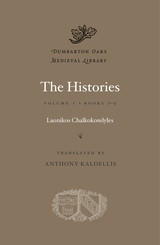 The Histories
Laonikos Chalkokondyles
Harvard University Press, 2014 Among Greek histories of the fall of Constantinople in 1453, the work of Laonikos (ca. 1430–ca. 1465) has by far the broadest scope. Born to a leading family of Athens under Florentine rule, he was educated in the classics at Mistra by the Neoplatonist philosopher Plethon.
In the 1450s, Laonikos set out to imitate Herodotos in writing the history of his times, a version in which the armies of Asia would prevail over the Greeks in Europe. The backbone of The Histories, a text written in difficult Thucydidean Greek, is the expansion of the Ottoman Empire from the early 1300s to 1464, but Laonikos’s digressions give sweeping accounts of world geography and ethnography from Britain to Mongolia, with an emphasis on Spain, Italy, and Arabia. Following the methodology of Herodotos and rejecting theological polemic, Laonikos is the first Greek writer to treat Islam as a legitimate cultural and religious system. He followed Plethon in viewing the Byzantines as Greeks rather than Romans, and so stands at the origins of Neo-Hellenic identity.
This translation makes the entire text of The Histories available in English for the first time.
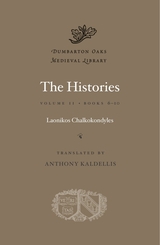 The Histories
Laonikos Chalkokondyles
Harvard University Press, 2014 Among Greek histories of the fall of Constantinople in 1453, the work of Laonikos (ca. 1430–ca. 1465) has by far the broadest scope. Born to a leading family of Athens under Florentine rule, he was educated in the classics at Mistra by the Neoplatonist philosopher Plethon.
In the 1450s, Laonikos set out to imitate Herodotos in writing the history of his times, a version in which the armies of Asia would prevail over the Greeks in Europe. The backbone of The Histories, a text written in difficult Thucydidean Greek, is the expansion of the Ottoman Empire from the early 1300s to 1464, but Laonikos’s digressions give sweeping accounts of world geography and ethnography from Britain to Mongolia, with an emphasis on Spain, Italy, and Arabia. Following the methodology of Herodotos and rejecting theological polemic, Laonikos is the first Greek writer to treat Islam as a legitimate cultural and religious system. He followed Plethon in viewing the Byzantines as Greeks rather than Romans, and so stands at the origins of Neo-Hellenic identity.
This translation makes the entire text of The Histories available in English for the first time.
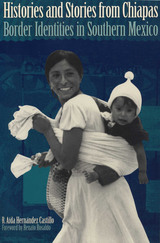 Histories and Stories from Chiapas: Border Identities in Southern Mexico
By R. Aída Hernández Castillo
University of Texas Press, 2001 The 1994 Zapatista uprising of Chiapas' Maya peoples against the Mexican government shattered the state myth that indigenous groups have been successfully assimilated into the nation. In this wide-ranging study of identity formation in Chiapas, Aída Hernández delves into the experience of a Maya group, the Mam, to analyze how Chiapas' indigenous peoples have in fact rejected, accepted, or negotiated the official discourse on "being Mexican" and participating in the construction of a Mexican national identity. Hernández traces the complex relations between the Mam and the national government from 1934 to the Zapatista rebellion. She investigates the many policies and modernization projects through which the state has attempted to impose a Mexican identity on the Mam and shows how this Maya group has resisted or accommodated these efforts. In particular, she explores how changing religious affiliation, women's and ecological movements, economic globalization, state policies, and the Zapatista movement have all given rise to various ways of "being Mam" and considers what these indigenous identities may mean for the future of the Mexican nation. The Spanish version of this book won the 1997 Fray Bernardino de Sahagún national prize for the best social anthropology research in Mexico.
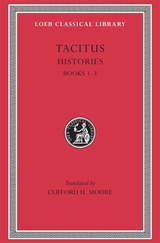 Histories: Books 1–3
Tacitus
Harvard University Press The paramount historian of the early Roman empire.
Tacitus (Cornelius), famous Roman historian, was born in AD 55, 56 or 57 and lived to about 120. He became an orator, married in 77 a daughter of Julius Agricola before Agricola went to Britain, was quaestor in 81 or 82, a senator under the Flavian emperors, and a praetor in 88. After four years’ absence he experienced the terrors of Emperor Domitian’s last years and turned to historical writing. He was a consul in 97. Close friend of the younger Pliny, with him he successfully prosecuted Marius Priscus.
Works: (i) Life and Character of Agricola, written in 97–98, specially interesting because of Agricola’s career in Britain. (ii) Germania (98–99), an equally important description of the geography, anthropology, products, institutions, and social life and the tribes of the Germans as known to the Romans. (iii) Dialogue on Oratory (Dialogus), of unknown date; a lively conversation about the decline of oratory and education. (iv) Histories (probably issued in parts from 105 onwards), a great work originally consisting of at least twelve books covering the period AD 69–96, but only Books 1–4 and part of Book 5 survive, dealing in detail with the dramatic years 69–70. (v) Annals, Tacitus’s other great work, originally covering the period AD 14–68 (Emperors Tiberius, Gaius, Claudius, Nero) and published between 115 and about 120. Of sixteen books at least, there survive Books 1–4 (covering the years 14–28); a bit of Book 5 and all Book 6 (31–37); part of Book 11 (from 47); Books 12–15 and part of Book 16 (to 66).
Tacitus is renowned for his development of a pregnant concise style, character study, and psychological analysis, and for the often terrible story which he brilliantly tells. As a historian of the early Roman empire he is paramount.
The Loeb Classical Library edition of Tacitus is in five volumes.
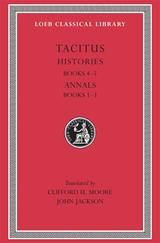 Histories: Books 4–5. Annals: Books 1–3
Tacitus
Harvard University Press The paramount historian of the early Roman empire.
Tacitus (Cornelius), famous Roman historian, was born in AD 55, 56 or 57 and lived to about 120. He became an orator, married in 77 a daughter of Julius Agricola before Agricola went to Britain, was quaestor in 81 or 82, a senator under the Flavian emperors, and a praetor in 88. After four years’ absence he experienced the terrors of Emperor Domitian’s last years and turned to historical writing. He was a consul in 97. Close friend of the younger Pliny, with him he successfully prosecuted Marius Priscus.
Works: (i) Life and Character of Agricola, written in 97–98, specially interesting because of Agricola’s career in Britain. (ii) Germania (98–99), an equally important description of the geography, anthropology, products, institutions, and social life and the tribes of the Germans as known to the Romans. (iii) Dialogue on Oratory (Dialogus), of unknown date; a lively conversation about the decline of oratory and education. (iv) Histories (probably issued in parts from 105 onwards), a great work originally consisting of at least twelve books covering the period AD 69–96, but only Books 1–4 and part of Book 5 survive, dealing in detail with the dramatic years 69–70. (v) Annals, Tacitus’s other great work, originally covering the period AD 14–68 (Emperors Tiberius, Gaius, Claudius, Nero) and published between 115 and about 120. Of sixteen books at least, there survive Books 1–4 (covering the years 14–28); a bit of Book 5 and all Book 6 (31–37); part of Book 11 (from 47); Books 12–15 and part of Book 16 (to 66).
Tacitus is renowned for his development of a pregnant concise style, character study, and psychological analysis, and for the often terrible story which he brilliantly tells. As a historian of the early Roman empire he is paramount.
The Loeb Classical Library edition of Tacitus is in five volumes.
 Histories of Computing
Michael Sean MahoneyEdited and with an introduction by Thomas Haigh
Harvard University Press, 2011 Computer technology is pervasive in the modern world, its role ever more important as it becomes embedded in a myriad of physical systems and disciplinary ways of thinking. The late Michael Sean Mahoney was a pioneer scholar of the history of computing, one of the first established historians of science to take seriously the challenges and opportunities posed by information technology to our understanding of the twentieth century.
Mahoney’s work ranged widely, from logic and the theory of computation to the development of software and applications as craft-work. But it was always informed by a unique perspective derived from his distinguished work on the history of medieval mathematics and experimental practice during the Scientific Revolution. His writings offered a new angle on very recent events and ideas and bridged the gaps between academic historians and computer scientists. Indeed, he came to believe that the field was irreducibly pluralistic and that there could be only histories of computing.
In this collection, Thomas Haigh presents thirteen of Mahoney’s essays and papers organized across three categories: historiography, software engineering, and theoretical computer science. His introduction surveys Mahoney’s work to trace the development of key themes, illuminate connections among different areas of his research, and put his contributions into context. The volume also includes an essay on Mahoney by his former students Jed Z. Buchwald and D. Graham Burnett. The result is a landmark work, of interest to computer professionals as well as historians of technology and science.
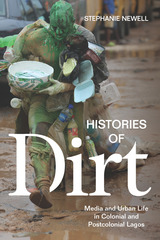 Histories of Dirt: Media and Urban Life in Colonial and Postcolonial Lagos
Stephanie Newell
Duke University Press, 2020 In Histories of Dirt Stephanie Newell traces the ways in which urban spaces and urban dwellers come to be regarded as dirty, as exemplified in colonial and postcolonial Lagos. Newell conceives dirt as an interpretive category that facilitates moral, sanitary, economic, and aesthetic evaluations of other cultures under the rubric of uncleanliness. She examines a number of texts ranging from newspaper articles by elite Lagosians to colonial travel writing, public health films, and urban planning to show how understandings of dirt came to structure colonial governance. Seeing Lagosians as sources of contagion and dirt, British colonizers used racist ideologies and discourses of dirt to justify racial segregation and public health policies. Newell also explores possibilities for non-Eurocentric methods for identifying African urbanites’ own values and opinions by foregrounding the voices of contemporary Lagosians through interviews and focus groups in which their responses to public health issues reflect local aesthetic tastes and values. In excavating the shifting role of dirt in structuring social and political life in Lagos, Newell provides new understandings of colonial and postcolonial urban history in West Africa.
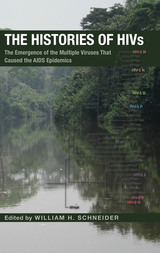 The Histories of HIVs: The Emergence of the Multiple Viruses That Caused the AIDS Epidemics
William H. Schneider
Ohio University Press, 2021 This new collection of essays on HIV viruses spans disciplines to topple popular narratives about the origins of the AIDS pandemic and the impact of the disease on public health policy. With a death toll in the tens of millions, the AIDS pandemic was one of the worst medical disasters of the past century. The disease was identified in 1981, at the height of miraculous postwar medical achievements, including effective antibiotics, breakthrough advances in heart surgery and transplantations, and cheap, safe vaccines—smallpox had been eradicated just a few years earlier. Arriving as they did during this era of confidence in modern medicine, the HIV epidemics shook the public’s faith in health science. Despite subsequent success in identifying, testing, and treating AIDS, the emergence of epidemics and outbreaks of Ebola, Zika, and the novel coronaviruses (SARS and COVID-19) are stark reminders that such confidence in modern medicine is not likely to be restored until the emergence of these viruses is better understood. This collection combines the work of major social science and humanities scholars with that of virologists and epidemiologists to provide a broader understanding of the historical, social, and cultural circumstances that produced the pandemic. The authors argue that the emergence of the HIV viruses and their epidemic spread were not the result of a random mutation but rather broader new influences whose impact depended upon a combination of specific circumstances at different places and times. The viruses emerged and were transmitted according to population movement and urbanization, changes in sexual relations, new medical procedures, and war. In this way, the AIDS pandemic was not a chance natural occurrence, but a human-made disaster. Essays by: Ernest M. Drucker, Tamara Giles-Vernick, Ch. Didier Gondola, Guillaume Lachenal, Amandine Lauro, Preston A. Marx, Stephanie Rupp, François Simon, Jorge Varanda
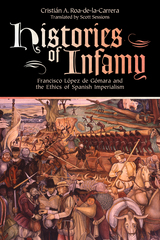 Histories of Infamy: Francisco López de Gómara and the Ethics of Spanish Imperialism
Cristián A. Roa-de-la-Carrera
University Press of Colorado, 2005 "Roa-de-la-Carrera convincingly shows that Gómara, as well as other historians in the period, cannot easily ignore nor erase the contradictions of the Spanish colonial project."
- Luis Fernando Restrepo, University of Arkansas
“In an eloquent and thorough exegesis, Roa-de-la-Carrera reveals how and why López de Gómara, having written the best of all possible books in exultation of Spanish imperialism, nevertheless failed to convince the readers of his time."
- Susan Schroeder, Tulane University
In Histories of Infamy, Cristián Roa-de-la-Carrera explores Francisco López de Gómara's (1511-ca.1559) attempt to ethically reconcile Spain's civilizing mission with the conquistadors' abuse and exploitation of Native peoples.
The most widely read account of the conquest in its time, Gómara's Historia general de las Indias y Conquista de México rationalized the conquistadors' crimes as unavoidable evils in the task of bringing "civilization" to the New World. Through an elaborate defense of Spanish imperialism, Gómara aimed to convince his readers of the merits of the conquest, regardless of the devastation it had wrought upon Spain's new subjects. Despite his efforts, Gómara's apologist text quickly fell into disrepute and became ammunition for Spain's critics. Evaluating the effectiveness of ideologies of colonization, Roa-de-la-Carrera's analysis will appeal to scholars in colonial studies and readers interested in the history of the Americas.
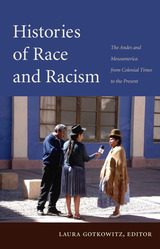 Histories of Race and Racism: The Andes and Mesoamerica from Colonial Times to the Present
Laura Gotkowitz, ed.
Duke University Press, 2012 Ninety percent of the indigenous population in the Americas lives in the Andean and Mesoamerican nations of Bolivia, Ecuador, Mexico, Peru, and Guatemala. Recently indigenous social movements in these countries have intensified debate about racism and drawn attention to the connections between present-day discrimination and centuries of colonialism and violence. In Histories of Race and Racism, anthropologists, historians, and sociologists consider the experiences and representations of Andean and Mesoamerican indigenous peoples from the early colonial era to the present. Many of the essays focus on Bolivia, where the election of the country’s first indigenous president, Evo Morales, sparked fierce disputes over political power, ethnic rights, and visions of the nation. The contributors compare the interplay of race and racism with class, gender, nationality, and regionalism in Bolivia, Ecuador, Guatemala, Mexico, and Peru. In the process, they engage issues including labor, education, census taking, cultural appropriation and performance, mestizaje, social mobilization, and antiracist legislation. Their essays shed new light on the present by describing how race and racism have mattered in particular Andean and Mesoamerican societies at specific moments in time. Contributors
Rossana Barragán
Kathryn Burns
Andrés Calla
Pamela Calla
Rudi Colloredo-Mansfeld
María Elena García
Laura Gotkowitz
Charles R. Hale
Brooke Larson
Claudio Lomnitz
José Antonio Lucero
Florencia E. Mallon
Khantuta Muruchi
Deborah Poole
Seemin Qayum
Arturo Taracena Arriola
Sinclair Thomson
Esteban Ticona Alejo
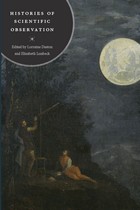 Histories of Scientific Observation
Edited by Lorraine Daston and Elizabeth Lunbeck
University of Chicago Press, 2010 Observation is the most pervasive and fundamental practice of all the modern sciences, both natural and human. Its instruments include not only the naked senses but also tools such as the telescope and microscope, the questionnaire, the photographic plate, the notebook, the glassed-in beehive, and myriad other ingenious inventions designed to make the invisible visible, the evanescent permanent, the abstract concrete. Yet observation has almost never been considered as an object of historical inquiry in itself. This wide-ranging collection offers the first examination of the history of scientific observation in its own right, as both epistemic category and scientific practice.
Histories of Scientific Observation features engaging episodes drawn from across the spectrum of the natural and human sciences, ranging from meteorology, medicine, and natural history to economics, astronomy, and psychology. The contributions spotlight how observers have scrutinized everything—from seaweed to X-ray radiation, household budgets to the emotions—with ingenuity, curiosity, and perseverance verging on obsession. This book makes a compelling case for the significance of the long, surprising, and epistemologically significant history of scientific observation, a history full of innovations that have enlarged the possibilities of perception, judgment, and reason.
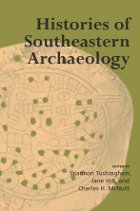 Histories of Southeastern Archaeology
Edited by Shannon Tushingham, Jane Hill, and Charles H. McNutt
University of Alabama Press, 2002 This volume provides a comprehensive, broad-based overview, including first-person accounts, of the development and conduct of archaeology in the Southeast over the past three decades.
Histories of Southeastern Archaeology originated as a symposium at the 1999 Southeastern Archaeological Conference (SEAC) organized in honor of the retirement of Charles H. McNutt following 30 years of teaching anthropology. Written for the most part by members of the first post-depression generation of southeastern archaeologists, this volume offers a window not only into the archaeological past of the United States but also into the hopes and despairs of archaeologists who worked to write that unrecorded history or to test scientific theories concerning culture.
The contributors take different approaches, each guided by experience, personality, and location, as well as by the legislation that shaped the practical conduct of archaeology in their area. Despite the state-by-state approach, there are certain common themes, such as the effect (or lack thereof) of changing theory in Americanist archaeology, the explosion of contract archaeology and its relationship to academic archaeology, goals achieved or not achieved, and the common ground of SEAC.
This book tells us how we learned what we now know about the Southeast's unwritten past. Of obvious interest to professionals and students of the field, this volume will also be sought after by historians, political scientists, amateurs, and anyone interested in the South.
Additional reviews: "A unique publication that presents numerous historical, topical, and personal perspectives on the archaeological heritage of the Southeast."— Southeastern Archaeology
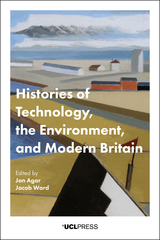 Histories of Technology, the Environment, and Modern Britain
Edited by Jon Agar and Jacob Ward
University College London, 2018 Histories of Technology, the Environment, and Modern Britain brings together historians with a wide range of interests to take a broad, multifaceted look at how technology and the environment have become intimately and irreversibly entangled in Britain over the last three hundred years. For the first time, the book brings together two perspectives with ample insights into the history of Britain since the Industrial Revolution: the history of technology and environmental history. Both technologies and our living and nonliving environment comprise material forms of organization—or self-organization—and both have changed over time, sometimes in intersecting ways. Among the technologies discussed in the collection are bulldozers, submarine cables, automobiles, flood barriers, medical devices, museum displays, and biotechnologies. Environments discussed include both places of natural beauty and pollution, bogs, cities, farms, land, and sea. The book explores this diversity and offers an integrated framework for understanding these intersections.
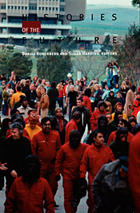 Histories of the Future
Daniel Rosenberg and Susan Harding, eds.
Duke University Press, 2005 We live in a world saturated by futures. Our lives are constructed around ideas and images about the future that are as full and as flawed as our understandings of the past. This book is a conceptual toolkit for thinking about the forms and functions that the future takes. Exploring links between panic and nostalgia, waiting and utopia, technology and messianism, prophecy and trauma, it brings together critical meditations on the social, cultural, and intellectual forces that create narratives and practices of the future. The prognosticators, speculators, prophets, and visionaries have their say here, but the emphasis is on small narratives and forgotten conjunctures, on the connections between expectation and experience in everyday life. In tightly linked studies, the contributors excavate forgotten and emergent futures of art, religion, technology, economics, and politics. They trace hidden histories of science fiction, futurism, and millennialism and break down barriers between far-flung cultural spheres. From the boardrooms of Silicon Valley to the forests of Java and from the literary salons of Tokyo to the roadside cafés of the Nevada desert, the authors stitch together the disparate images and stories of futures past and present. Histories of the Future is further punctuated by three interludes: a thought-provoking game that invites players to fashion future narratives of their own, a metafiction by renowned novelist Jonathan Lethem, and a remarkable graphic research tool: a timeline of timelines. Contributors. Sasha Archibald, Susan Harding, Jamer Hunt, Pamela Jackson, Susan Lepselter, Jonathan Lethem, Joseph Masco, Christopher Newfield, Elizabeth Pollman, Vicente Rafael, Daniel Rosenberg, Miryam Sas, Kathleen Stewart, Anna Tsing
Histories of the Present: People and Power in Ecuador
Norman E. Whitten Jr. and Dorothea Scott Whitten
University of Illinois Press, 2011 The wellspring of critical analysis in this book emerges from Ecuador's major Indigenous Uprising of 1990 and its ongoing aftermath in which indigenous and Afro-Ecuadorian action transformed the nation-state and established new dimensions of human relationships. The authors weave anthropological theory with longitudinal Ecuadorian ethnography to produce a unique contribution to Latin American studies.
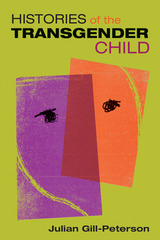 Histories of the Transgender Child
Jules Gill-Peterson
University of Minnesota Press, 2018 A groundbreaking twentieth-century history of transgender children
With transgender rights front and center in American politics, media, and culture, the pervasive myth still exists that today’s transgender children are a brand new generation—pioneers in a field of new obstacles and hurdles. Histories of the Transgender Child shatters this myth, uncovering a previously unknown twentieth-century history when transgender children not only existed but preexisted the term transgender and its predecessors, playing a central role in the medicalization of trans people, and all sex and gender.
Beginning with the early 1900s when children with “ambiguous” sex first sought medical attention, to the 1930s when transgender people began to seek out doctors involved in altering children’s sex, to the invention of the category gender, and finally the 1960s and ’70s when, as the field institutionalized, transgender children began to take hormones, change their names, and even access gender confirmation, Julian Gill-Peterson reconstructs the medicalization and racialization of children’s bodies. Throughout, they foreground the racial history of medicine that excludes black and trans of color children through the concept of gender’s plasticity, placing race at the center of their analysis and at the center of transgender studies. Until now, little has been known about early transgender history and life and its relevance to children. Using a wealth of archival research from hospitals and clinics, including incredible personal letters from children to doctors, as well as scientific and medical literature, this book reaches back to the first half of the twentieth century—a time when the category transgender was not available but surely existed, in the lives of children and parents.
 Histories on Econometrics, Volume 43
Marcel Boumans, Ariane Dupont-Kieffer, Dou Qin, editors
Duke University Press This volume considers the history of econometrics, a field of economics that combines statistics, mathematics, and economic theory. Contributors scrutinize accounts of the field’s shifting boundaries and the development of a cohesive scholarly community of econometricians. These essays consider applied research and methodologies in context and connect the history of econometrics to contemporary developments in related disciplines and technologies. Analyzing the practice of econometrics around the world since its introduction in the 1920s, contributors examine the relationship between sociology and welfare in Italian econometrics, the extraordinary investment in macroeconometric models and input-output models in Japan, practices of econometrics in relation to computation and philosophy, and the recognition of unusual methodological stances in both theoretical and applied work. Reinterpreting the accepted history of econometrics allows historians to focus on new alliances, methods, and entrepreneurial models that resolve past obscurities and open up new areas for future inquiry. Contributors: John Aldrich, Jeff E. Biddle, Olav Bjerkholt, Marcel Boumans, Chao-Hsi Huang, Robert W. Dimand, Duo Qin, Ariane Dupont-Kieffer, Hsiang-Ke Chao, Aiko Ikeo, Francisco Louçã, Mary S. Morgan, Daniela Parisi, Alain Pirotte, Charles G. Renfro, Thomas Stapleford, Sofia Terlica Marcel Boumans is Associate Professor of Economics at the University of Amsterdam. Ariane Dupont-Kieffer is a Researcher at the French National Institute of Research on Transport and Safety. Duo Qin is Reader of Economics at the University of London.
 The Histories, Volume I: Books 1–2
Translated by W. R. PatonRevised by F. W. Walbank and Christian Habicht
Harvard University Press, 2010 Hellenistic history.
The historian Polybius (ca. 200–118 BC) was born into a leading family of Megalopolis in the Peloponnese (Morea) and served the Achaean League in arms and diplomacy for many years, favoring alliance with Rome. From 168 to 151 he was held hostage in Rome, where he became a friend of Lucius Aemilius Paulus and his two sons, especially Scipio Aemilianus, whose campaigns, including the destruction of Carthage, he later attended. Late in his life he became a trusted mediator between Greece and the Romans; helped in the discussions that preceded the final war with Carthage; and after 146 was entrusted by the Romans with the details of administration in Greece.
Polybius’ overall theme is how and why the Romans spread their power as they did. The main part of his history covers the years 264–146 BC, describing the rise of Rome, her destruction of Carthage, and her eventual domination of the Greek world. It is a great work: accurate, thoughtful, largely impartial, based on research, and full of insight into customs, institutions, geography, the causes of events, and the character of peoples. It is a vital achievement of the first importance despite the incomplete state in which all but the first five of its original forty books have reached us.
For this edition, W. R. Paton’s excellent translation, first published in 1922, has been thoroughly revised, the Büttner-Wobst Greek text corrected, and explanatory notes and a new introduction added, all reflecting the latest scholarship.
The Loeb Classical Library edition of Polybius is in six volumes.
 The Histories, Volume I: Books 1-2
Polybius
Harvard University Press Polybius (born ca. 208 BCE) of Megalopolis in the Peloponnese (Morea), served the Achaean League in arms and diplomacy for many years, favouring alliance with Rome. From 168 to 151 he was hostage in Rome where he became a friend of Aemilius Paulus and his two sons, and especially adopted Scipio Aemilianus whose campaigns he attended later. In late life he was trusted mediator between Greece and the Romans whom he admired; helped in the discussions which preceded the final war with Carthage; and, after 146, was entrusted by the Romans with details of administration in Greece. He died at the age of 82 after a fall from his horse.
The main part of Polybius's history covers the years 264146 BCE. It describes the rise of Rome to the destruction of Carthage and the domination of Greece by Rome. It is a great work, accurate, thoughtful, largely impartial, based on research, full of insight into customs, institutions, geography, causes of events and character of people; it is a vital achievement of first rate importance, despite the incomplete state in which all but the first five of the forty books have reached us. Polybius's overall theme is how and why the Romans spread their power as they did.
The Loeb Classical Library edition of Polybius is in six volumes.
 The Histories, Volume II: Books 3–4
PolybiusTranslated by W. R. PatonRevised by F. W. Walbank and Christian Habicht
Harvard University Press, 2010 Hellenistic history.
The historian Polybius (ca. 200–118 BC) was born into a leading family of Megalopolis in the Peloponnese (Morea) and served the Achaean League in arms and diplomacy for many years, favoring alliance with Rome. From 168 to 151 he was held hostage in Rome, where he became a friend of Lucius Aemilius Paulus and his two sons, especially Scipio Aemilianus, whose campaigns, including the destruction of Carthage, he later attended. Late in his life he became a trusted mediator between Greece and the Romans; helped in the discussions that preceded the final war with Carthage; and after 146 was entrusted by the Romans with the details of administration in Greece.
Polybius’ overall theme is how and why the Romans spread their power as they did. The main part of his history covers the years 264–146 BC, describing the rise of Rome, her destruction of Carthage, and her eventual domination of the Greek world. It is a great work: accurate, thoughtful, largely impartial, based on research, and full of insight into customs, institutions, geography, the causes of events, and the character of peoples. It is a vital achievement of the first importance despite the incomplete state in which all but the first five of its original forty books have reached us.
For this edition, W. R. Paton’s excellent translation, first published in 1922, has been thoroughly revised, the Büttner-Wobst Greek text corrected, and explanatory notes and a new introduction added, all reflecting the latest scholarship.
The Loeb Classical Library edition of Polybius is in six volumes.
 The Histories, Volume II: Books 3-4
Polybius
Harvard University Press Polybius (born ca. 208 BCE) of Megalopolis in the Peloponnese (Morea), served the Achaean League in arms and diplomacy for many years, favouring alliance with Rome. From 168 to 151 he was hostage in Rome where he became a friend of Aemilius Paulus and his two sons, and especially adopted Scipio Aemilianus whose campaigns he attended later. In late life he was trusted mediator between Greece and the Romans whom he admired; helped in the discussions which preceded the final war with Carthage; and, after 146, was entrusted by the Romans with details of administration in Greece. He died at the age of 82 after a fall from his horse.
The main part of Polybius's history covers the years 264146 BCE. It describes the rise of Rome to the destruction of Carthage and the domination of Greece by Rome. It is a great work, accurate, thoughtful, largely impartial, based on research, full of insight into customs, institutions, geography, causes of events and character of people; it is a vital achievement of first rate importance, despite the incomplete state in which all but the first five of the forty books have reached us. Polybius's overall theme is how and why the Romans spread their power as they did.
The Loeb Classical Library edition of Polybius is in six volumes.
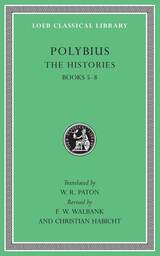 The Histories, Volume III: Books 5–8
Translated by W. R. PatonRevised by F. W. Walbank and Christian Habicht
Harvard University Press, 2010 Hellenistic history.
The historian Polybius (ca. 200–118 BC) was born into a leading family of Megalopolis in the Peloponnese (Morea) and served the Achaean League in arms and diplomacy for many years, favoring alliance with Rome. From 168 to 151 he was held hostage in Rome, where he became a friend of Lucius Aemilius Paulus and his two sons, especially Scipio Aemilianus, whose campaigns, including the destruction of Carthage, he later attended. Late in his life he became a trusted mediator between Greece and the Romans; helped in the discussions that preceded the final war with Carthage; and after 146 was entrusted by the Romans with the details of administration in Greece.
Polybius’ overall theme is how and why the Romans spread their power as they did. The main part of his history covers the years 264–146 BC, describing the rise of Rome, her destruction of Carthage, and her eventual domination of the Greek world. It is a great work: accurate, thoughtful, largely impartial, based on research, and full of insight into customs, institutions, geography, the causes of events, and the character of peoples. It is a vital achievement of the first importance despite the incomplete state in which all but the first five of its original forty books have reached us.
For this edition, W. R. Paton’s excellent translation, first published in 1922, has been thoroughly revised, the Büttner-Wobst Greek text corrected, and explanatory notes and a new introduction added, all reflecting the latest scholarship.
The Loeb Classical Library edition of Polybius is in six volumes.
 The Histories, Volume III: Books 5-8
Polybius
Harvard University Press Polybius (born ca. 208 BCE) of Megalopolis in the Peloponnese (Morea), served the Achaean League in arms and diplomacy for many years, favouring alliance with Rome. From 168 to 151 he was hostage in Rome where he became a friend of Aemilius Paulus and his two sons, and especially adopted Scipio Aemilianus whose campaigns he attended later. In late life he was trusted mediator between Greece and the Romans whom he admired; helped in the discussions which preceded the final war with Carthage; and, after 146, was entrusted by the Romans with details of administration in Greece. He died at the age of 82 after a fall from his horse.
The main part of Polybius's history covers the years 264146 BCE. It describes the rise of Rome to the destruction of Carthage and the domination of Greece by Rome. It is a great work, accurate, thoughtful, largely impartial, based on research, full of insight into customs, institutions, geography, causes of events and character of people; it is a vital achievement of first rate importance, despite the incomplete state in which all but the first five of the forty books have reached us. Polybius's overall theme is how and why the Romans spread their power as they did.
The Loeb Classical Library edition of Polybius is in six volumes.
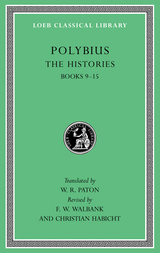 The Histories, Volume IV: Books 9–15
Translated by W. R. PatonRevised by F. W. Walbank and Christian Habicht
Harvard University Press, 2010 Hellenistic history.
The historian Polybius (ca. 200–118 BC) was born into a leading family of Megalopolis in the Peloponnese (Morea) and served the Achaean League in arms and diplomacy for many years, favoring alliance with Rome. From 168 to 151 he was held hostage in Rome, where he became a friend of Lucius Aemilius Paulus and his two sons, especially Scipio Aemilianus, whose campaigns, including the destruction of Carthage, he later attended. Late in his life he became a trusted mediator between Greece and the Romans; helped in the discussions that preceded the final war with Carthage; and after 146 was entrusted by the Romans with the details of administration in Greece.
Polybius’ overall theme is how and why the Romans spread their power as they did. The main part of his history covers the years 264–146 BC, describing the rise of Rome, her destruction of Carthage, and her eventual domination of the Greek world. It is a great work: accurate, thoughtful, largely impartial, based on research, and full of insight into customs, institutions, geography, the causes of events, and the character of peoples. It is a vital achievement of the first importance despite the incomplete state in which all but the first five of its original forty books have reached us.
For this edition, W. R. Paton’s excellent translation, first published in 1922, has been thoroughly revised, the Büttner-Wobst Greek text corrected, and explanatory notes and a new introduction added, all reflecting the latest scholarship.
The Loeb Classical Library edition of Polybius is in six volumes.
 The Histories, Volume IV: Books 9-15
Polybius
Harvard University Press Polybius (born ca. 208 BCE) of Megalopolis in the Peloponnese (Morea), served the Achaean League in arms and diplomacy for many years, favouring alliance with Rome. From 168 to 151 he was hostage in Rome where he became a friend of Aemilius Paulus and his two sons, and especially adopted Scipio Aemilianus whose campaigns he attended later. In late life he was trusted mediator between Greece and the Romans whom he admired; helped in the discussions which preceded the final war with Carthage; and, after 146, was entrusted by the Romans with details of administration in Greece. He died at the age of 82 after a fall from his horse.
The main part of Polybius's history covers the years 264146 BCE. It describes the rise of Rome to the destruction of Carthage and the domination of Greece by Rome. It is a great work, accurate, thoughtful, largely impartial, based on research, full of insight into customs, institutions, geography, causes of events and character of people; it is a vital achievement of first rate importance, despite the incomplete state in which all but the first five of the forty books have reached us. Polybius's overall theme is how and why the Romans spread their power as they did.
The Loeb Classical Library edition of Polybius is in six volumes.
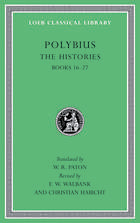 The Histories, Volume V: Books 16–27
Translated by W. R. PatonRevised by F. W. Walbank and Christian Habicht
Harvard University Press, 2010 Hellenistic history.
The historian Polybius (ca. 200–118 BC) was born into a leading family of Megalopolis in the Peloponnese (Morea) and served the Achaean League in arms and diplomacy for many years, favoring alliance with Rome. From 168 to 151 he was held hostage in Rome, where he became a friend of Lucius Aemilius Paulus and his two sons, especially Scipio Aemilianus, whose campaigns, including the destruction of Carthage, he later attended. Late in his life he became a trusted mediator between Greece and the Romans; helped in the discussions that preceded the final war with Carthage; and after 146 was entrusted by the Romans with the details of administration in Greece.
Polybius’ overall theme is how and why the Romans spread their power as they did. The main part of his history covers the years 264–146 BC, describing the rise of Rome, her destruction of Carthage, and her eventual domination of the Greek world. It is a great work: accurate, thoughtful, largely impartial, based on research, and full of insight into customs, institutions, geography, the causes of events, and the character of peoples. It is a vital achievement of the first importance despite the incomplete state in which all but the first five of its original forty books have reached us.
For this edition, W. R. Paton’s excellent translation, first published in 1922, has been thoroughly revised, the Büttner-Wobst Greek text corrected, and explanatory notes and a new introduction added, all reflecting the latest scholarship.
The Loeb Classical Library edition of Polybius is in six volumes.
 The Histories, Volume V: Books 16-27
Polybius
Harvard University Press Polybius (born ca. 208 BCE) of Megalopolis in the Peloponnese (Morea), served the Achaean League in arms and diplomacy for many years, favouring alliance with Rome. From 168 to 151 he was hostage in Rome where he became a friend of Aemilius Paulus and his two sons, and especially adopted Scipio Aemilianus whose campaigns he attended later. In late life he was trusted mediator between Greece and the Romans whom he admired; helped in the discussions which preceded the final war with Carthage; and, after 146, was entrusted by the Romans with details of administration in Greece. He died at the age of 82 after a fall from his horse.
The main part of Polybius's history covers the years 264146 BCE. It describes the rise of Rome to the destruction of Carthage and the domination of Greece by Rome. It is a great work, accurate, thoughtful, largely impartial, based on research, full of insight into customs, institutions, geography, causes of events and character of people; it is a vital achievement of first rate importance, despite the incomplete state in which all but the first five of the forty books have reached us. Polybius's overall theme is how and why the Romans spread their power as they did.
The Loeb Classical Library edition of Polybius is in six volumes.
 The Histories, Volume VI: Books 28-39
Polybius
Harvard University Press Polybius (born ca. 208 BCE) of Megalopolis in the Peloponnese (Morea), served the Achaean League in arms and diplomacy for many years, favouring alliance with Rome. From 168 to 151 he was hostage in Rome where he became a friend of Aemilius Paulus and his two sons, and especially adopted Scipio Aemilianus whose campaigns he attended later. In late life he was trusted mediator between Greece and the Romans whom he admired; helped in the discussions which preceded the final war with Carthage; and, after 146, was entrusted by the Romans with details of administration in Greece. He died at the age of 82 after a fall from his horse.
The main part of Polybius's history covers the years 264146 BCE. It describes the rise of Rome to the destruction of Carthage and the domination of Greece by Rome. It is a great work, accurate, thoughtful, largely impartial, based on research, full of insight into customs, institutions, geography, causes of events and character of people; it is a vital achievement of first rate importance, despite the incomplete state in which all but the first five of the forty books have reached us. Polybius's overall theme is how and why the Romans spread their power as they did.
The Loeb Classical Library edition of Polybius is in six volumes.
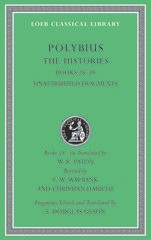 The Histories, Volume VI: Books 28–39. Unattributed Fragments
Translated by W. R. PatonRevised by F. W. Walbank and Christian HabichtFragments edited and translated by S. Douglas Olson
Harvard University Press, 2010 Hellenistic history.
The historian Polybius (ca. 200–118 BC) was born into a leading family of Megalopolis in the Peloponnese (Morea) and served the Achaean League in arms and diplomacy for many years, favoring alliance with Rome. From 168 to 151 he was held hostage in Rome, where he became a friend of Lucius Aemilius Paulus and his two sons, especially Scipio Aemilianus, whose campaigns, including the destruction of Carthage, he later attended. Late in his life he became a trusted mediator between Greece and the Romans; helped in the discussions that preceded the final war with Carthage; and after 146 was entrusted by the Romans with the details of administration in Greece.
Polybius’ overall theme is how and why the Romans spread their power as they did. The main part of his history covers the years 264–146 BC, describing the rise of Rome, her destruction of Carthage, and her eventual domination of the Greek world. It is a great work: accurate, thoughtful, largely impartial, based on research, and full of insight into customs, institutions, geography, the causes of events, and the character of peoples. It is a vital achievement of the first importance despite the incomplete state in which all but the first five of its original forty books have reached us.
For this edition, W. R. Paton’s excellent translation, first published in 1922, has been thoroughly revised, the Büttner-Wobst Greek text corrected, and explanatory notes and a new introduction added, all reflecting the latest scholarship.
The Loeb Classical Library edition of Polybius is in six volumes.
Historiography: Ancient, Medieval, and Modern
Ernst Breisach
University of Chicago Press, 1995 In this pioneering work, Ernst Breisach presents an effective, well-organized, and concise account of the development of historiography in Western culture. Neither a handbook nor an encyclopedia, this updated second edition narrates and interprets the development of historiography from its origins in Greek poetry to the present, with sections on such current topics as postmodernism, deconstructionism, black history, women's history, microhistory, Historikerstreit, the linguistic turn, and more.
Historiography: Ancient, Medieval, and Modern, Third Edition
Ernst Breisach
University of Chicago Press, 2007 A masterwork of erudition and deep knowledge, Historiography offers no less than an account of the entire development of historiography in Western culture
In this pioneering work, Ernst Breisach presents an effective, well-organized, and concise account of the development of historiography in Western culture. Neither a handbook nor an encyclopedia, this up-to-date third edition narrates and interprets the development of historiography from its origins in Greek poetry to the present, with compelling sections on postmodernism, deconstructionism, African-American history, women’s history, microhistory, the Historikerstreit, cultural history, and more. The definitive look at the writing of history by a historian, Historiography provides key insights into some of the most important issues, debates and innovations in modern historiography.
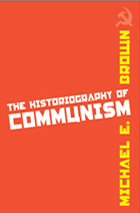 The Historiography of Communism
Michael E. Brown
Temple University Press, 2008 In this fresh appraisal of communism and anti-communism, with an emphasis on the American case, respected scholar Michael E. Brown examines the methods, controversies and difficulties involved in writing the history of communism. Arguing that one important way of understanding communism—other than as a concrete political or ideological force—is as an expression of an essentially reflexive aspect of society that typically manifests itself in social movements. In this regard, Brown understands the history of communism as part of the history of society. Examining works by E. P. Thompson, Karl Marx, and Pierre Clastres, Brown develops the idea of history as an immanent feature of human activities. Taken together, the essays in this book—written over a period of 20 years–offer a distinctive approach to the connections between social theory, criticism, and historiography and to what is “social” about “social movements.”
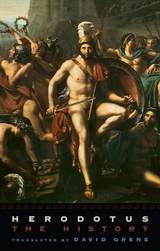 The History
Herodotus
University of Chicago Press, 1988 David Grene, one of the best known translators of the Greek classics, splendidly captures the peculiar quality of Herodotus, the father of history.
Here is the historian, investigating and judging what he has seen, heard, and read, and seeking out the true causes and consequences of the great deeds of the past. In his History, the war between the Greeks and Persians, the origins of their enmity, and all the more general features of the civilizations of the world of his day are seen as a unity and expressed as the vision of one man who as a child lived through the last of the great acts in this universal drama.
In Grene's remarkable translation and commentary, we see the historian as a storyteller, combining through his own narration the skeletal "historical" facts and the imaginative reality toward which his story reaches. Herodotus emerges in all his charm and complexity as a writer and the first historian in the Western tradition, perhaps unique in the way he has seen the interrelation of fact and fantasy.
"Reading Herodotus in English has never been so much fun. . . . Herodotus crowds his fresco-like pages with all shades of humanity. Whether Herodotus's view is 'tragic,' mythical, or merely common sense, it provided him with a moral salt with which the diversity of mankind could be savored. And savor it we do in David Grene's translation."—Thomas D'Evelyn, Christian Science Monitor
"Grene's work is a monument to what translation intends, and to what it is hungry to accomplish. . . . Herodotus gives more sheer pleasure than almost any other writer."—Peter Levi, New York Times Book Review
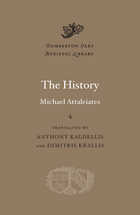 The History
Michael Attaleiates
Harvard University Press, 2012 In 1039 Byzantium was the most powerful empire in Europe and the Near East, controlling the Balkans south of the Danube and all of Asia Minor into Armenia and Syria. By 1079 it had become a politically unstable state half the size, menaced by powerful enemies on all sides. The History of Michael Attaleiates is our main source for this astonishing reversal, and offers a gripping narrative of the foreign and civil wars of those years. Attaleiates was a highly placed legal and military official of the empire with first-hand knowledge of the events he describes. He knew many of the emperors and includes an eyewitness account of the battle of Mantzikert (1071), where the Seljuk Turks crushed the Byzantine armies and opened the door for the permanent Turkish conquest of Asia Minor. He also provides vivid narratives of civil unrest and decries the corruption and economic exploitation of his society, looking to the heroes of the Roman Republic for models of nobility.
Michael Attaleiates’ History has never before been translated into English. The present translation, based on the most recent critical edition, makes the text accessible through its notes, maps, and glossary of Byzantine terms.
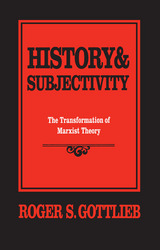 History & Subjectivity
Roger Gottlieb
Temple University Press, 1987 "...rescues the probing spirit of Marx from the dead hand of Marx-ism. In this bold and argumentative book, Gottlieb joins other contemporary theorists in challenging the primacy of class and relations of production as keys to understanding our collective predicament. The result is an important contribution to left theory- both for its summation of the insights drawn from recent movements and for its provocative confrontation with the wisdom of the past."
--Barbara Ehrenreich
Can Marxism still serve the American left? History and Subjectivity answers this question by synthesizing the conflicting perspectives of traditional Marxism, Western and neo-Marxism, socialist-feminism, and various minority political movements into a comprehensive and original social theory.
In the last seventy years, social change and the failure of leftist movements have made it necessary to transform Marxist theory. Undermined by its own theoretical success, traditional Marxism mistakenly assumed that Marx's understanding of competitive capitalism could be the model for theories of any society. Roger Gottlieb argues convincingly that the transformation of Marxist theory requires a fundamentally new understanding of social primacy.
Gottlieb draws on resources from virtually all areas of contemporary radical social theory. This interdisciplinary approach results in a sweeping synthesis of existing Marxist thought and an original and compelling social theory.
"Roger Gottlieb has written a very rich and often brilliant book.... [His] general thesis is developed, argued, and tested in the course of an impressive series of reconsiderations of debates in the Marxist tradition--impressive for the sheer breadth of the material mastered, as well as the critical acumen with which Gottlieb finds his way through the thicket of arguments and counter arguments. The result is an always lively, frequently exciting journey through the Marxist tradition, as well as a major contribution to the transformation which Marxism is currently undergoing."
--Richard Schmitt
"This is a serious and ambitious book. Its attempt to incorporate socialist feminism, and its interesting discussion of the American left are major strengths. It is a distinctive argument, framed within a personal sensibility, which should encourage wide response."
--Marx W. Wartofsky
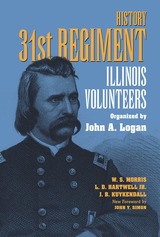 History 31st Regiment: Illinois Volunteers Organized by John A. Logan
W. S. Morris, J. B. Kuykendall, and L. D. Hartwell. Foreword by John Y. Simon
Southern Illinois University Press, 1998 The story of John A. Logan’s famed 31st Regiment Illinois Volunteers, told by three veterans, follows the regiment from the battles of Belmont, Fort Donelson, Vicksburg, Kenesaw Mountain, and Atlanta through the March to the Sea and into North Carolina. "Few regiments," notes historian John Y. Simon in the foreword, "fought longer or more fiercely, suffered more casualties, or won more victories." Logan proved a valiant and valuable Union commander, yet when the Civil War first began, it was far from clear whether he would lead Union or Confederate troops. In dramatic fashion, however, he broke what Simon calls an "ominous silence ... interpreted by many as sympathy for the South." Speaking from a wagon platform in Marion, Illinois, Logan proclaimed: "[The] time has come when a man must be for or against his country." Logan accepted a commission from Illinois governor Richard Yates, recruited heavily in southern Illinois, and formed the 31st Regiment Illinois Volunteers. The 31st became a prime component in Grant’s western campaigns, fighting for the first time at Belmont, Missouri. In February of 1862, the 31st foiled Confederate general Gideon J. Pillow’s dramatic escape from the Union siege at Fort Donelson. Although this is often listed as one of the proudest moments for the 31st, casualties ran high (fifty-eight killed), with Logan so severely wounded that at first he was reported dead. Logan’s valor at Fort Donelson won him promotion to brigadier general.
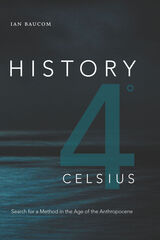 History 4° Celsius: Search for a Method in the Age of the Anthropocene
Ian Baucom
Duke University Press, 2020 In History 4° Celsius Ian Baucom continues his inquiries into the place of the Black Atlantic in the making of the modern and postmodern world. Putting black studies into conversation with climate change, Baucom outlines how the ongoing concerns of critical race, diaspora, and postcolonial studies are crucial to understanding the Anthropocene. He draws on materialist and postmaterialist thought, Sartre, and the science of climate change to trace the ways in which evolving political, cultural, and natural history converge to shape a globally destructive force. Identifying the quest for limitless financial gain as the primary driving force behind both the slave trade and the continuing increase in global greenhouse gas emissions, Baucom demonstrates that climate change and the conditions of the Black Atlantic, colonialism, and the postcolony are fundamentally entwined. In so doing, he argues for the necessity of establishing a method of critical exchange between climate science, black studies, and the surrounding theoretical inquiries of humanism and posthumanism.
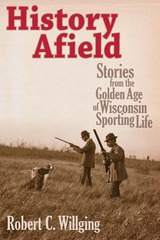 History Afield: Stories from the Golden Age of Wisconsin Sporting Life
Robert C Willging
Wisconsin Historical Society Press, 2011 Stories of sportsmen past come to life in History Afield, an account of the many and varied sporting pursuits that are part of the Wisconsin tradition. Author and outdoorsman Robert Willging shares more than two dozen tales of Wisconsin sporting history, highlighting the hunt for waterfowl, upland birds, and deer; trout fishing in wild north Wisconsin rivers; and recreating at early Wisconsin lakeside resorts. Anecdotes of fishing exploits on our plentiful waterways and presidential visits to northern Wisconsin reveal a unique slice of sporting culture, and chapters on live decoys and the American Water Spaniel demonstrate the human-animal bond that has played such a large part in that history. Tales of nature’s fury include a detailed account of the famous Armistice Day storm, as well as the dangers of ice fishing on Lake Superior. These historical musings and perspectives on sporting ethos provide a strong sense of the lifestyle that Willging has preserved for our new century. Featuring first-hand interviews and a variety of historic photos depicting the Wisconsin sporting life, History Afield shows how the intimate relationship between humans and nature shaped this important part of the state’s heritage.
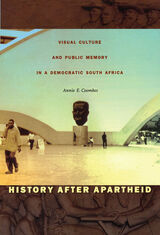 History after Apartheid: Visual Culture and Public Memory in a Democratic South Africa
Annie E. Coombes
Duke University Press, 2003 The democratic election of Nelson Mandela as president of South Africa in 1994 marked the demise of apartheid and the beginning of a new struggle to define the nation’s past. History after Apartheid analyzes how, in the midst of the momentous shift to an inclusive democracy, South Africa’s visual and material culture represented the past while at the same time contributing to the process of social transformation. Considering attempts to invent and recover historical icons and narratives, art historian Annie E. Coombes examines how strategies for embodying different models of historical knowledge and experience are negotiated in public culture—in monuments, museums, and contemporary fine art. History after Apartheid explores the dilemmas posed by a wide range of visual and material culture including key South African heritage sites. How prominent should Nelson Mandela and the African National Congress be in the museum at the infamous political prison on Robben Island? How should the postapartheid government deal with the Voortrekker Monument mythologizing the Boer Trek of 1838? Coombes highlights the contradictory investment in these sites among competing constituencies and the tensions involved in the rush to produce new histories for the “new” South Africa. She reveals how artists and museum officials struggled to adequately represent painful and difficult histories ignored or disavowed under apartheid, including slavery, homelessness, and the attempted destruction of KhoiSan hunter-gatherers. Describing how contemporary South African artists address historical memory and the ambiguities uncovered by the Truth and Reconciliation Commission, Coombes illuminates a body of work dedicated to the struggle to simultaneously remember the past and move forward into the future.
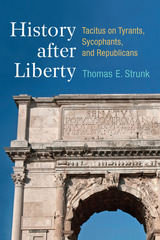 History after Liberty: Tacitus on Tyrants, Sycophants, and Republicans
Thomas E. Strunk
University of Michigan Press, 2017 Roman historian Tacitus wrote a damning critique of the first century CE Roman empire. The emperors in Tacitus’ works are almost universally tyrants surrounded by flatterers and informants, and the image Tacitus creates is of a society that has lost the liberty enjoyed under the Roman Republic. Yet Tacitus also poignantly depicts those who resist this tyranny and seek to restore a sense of liberty to Rome. In his portrayal of autocrats, sycophants, and republicans Tacitus provides an enduring testament to the value of liberty and the evils of despotism.
History after Liberty explores Tacitus’ political thought through his understanding of liberty. Influenced by modern republican writers such as Quentin Skinner and Philip Pettit, this study defines Tacitean libertas as the freedom from the rule of a dominus and as freedom to participate in the traditional politics of Rome through military service, public service in the senate and magistracies, and public speech. All of these elements are balanced in Tacitus’ writings with examples of those resisting the corruption of politics in an effort to restore a sense of free civic engagement. The work concludes with an exploration of Tacitus’ own writings as an act of restoring liberty. In contrast to most studies on Tacitus, History after Liberty argues that Tacitus is a republican who writes both to demonstrate that Rome had become a tyranny and to show a way out of that tyranny.
History after Liberty addresses the political thought of Tacitus’ writings. As such it will be of most interest to those who study the history and historiography of the early Roman empire, namely classicists and ancient historians. The work will also be of use to those interested in the antecedents to modern political thought, particularly the history of republicanism and freedom; readers from this category will include political scientists, philosophers, and modern historians.
History And 9/11
Joanne Meyerowitz
Temple University Press, 2003 The contributors to this landmark collection set the attacks on the United States in historical perspective. They reject the simplistic notion of an age-old "clash of civilizations" and instead examine the particular histories of American nationalism, anti-Americanism, U.S. foreign policy, and Islamic fundamentalism among other topics. With renewed attention to Americans' sense of national identity, they focus on the United States in relation to the rest of the world. A collection of recent and historical documents—speeches, articles, and book excerpts—supplement the essays. Taken together, the essays and sources in this volume comment on the dangers of seeing the events of September 11 as splitting the nation's history into "before" and "after." They argue eloquently that no useful understanding of the present is possible without an unobstructed view of the past.
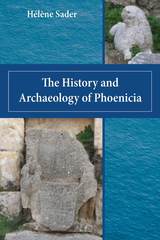 The History and Archaeology of Phoenicia
Hélène Sader
SBL Press, 2019 An insightful historical account of Phoenicia that illustrates its cities, culture, and daily life
Hélène Sader presents the history and archaeology of Phoenicia based on the available contemporary written sources and the results of archaeological excavations in Phoenicia proper. Sader explores the origin of the term Phoenicia; the political and geographical history of the city-states Arwad, Byblos, Sidon, and Tyre; and topography, climate, and natural resources of the Phoenician homeland. Her limited focus on Phoenicia proper, in contrast to previous studies that included information from Phoenician colonies, presents the bare realities of the opportunities and difficulties shaping Phoenician life. Sader’s evaluation and synthesis of the evidence offers a corrective to the common assumption of a unified Phoenician kingdom.
Features
- Historical as well as modern maps with the locations of all relevant archaeological sites
- Faunal and floral analyses that shed light on the Phoenician diet
- Petrographic analysis of pottery that sheds light on trading patterns and developments
History and Context in Comparative Public Policy
Douglas E. Ashford
University of Pittsburgh Press, 1992
Douglas E. Ashford joins a growing number of scholars who have questioned the behavioralist assumptions of much policy science. The essays in this volume show why policy analysis cannot be confined to prevailing methods of social science. Policy-making behavior involves historical, contextual, and philosophical factors that also raise critical questions about the concepts and theory of the discipline. Ashford asks difficult questions about the contextual, conjunctural, and unintentional circumstances that affect actual decision-making. His bridging essays summarize opposing viewpoints and conflicting interpretations to help form a new agenda for comparative policy analysis.
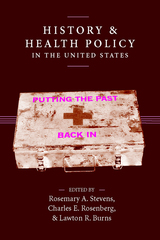 History and Health Policy in the United States: Putting the Past Back In
Stevens, Rosemary A
Rutgers University Press, 2006 In our rapidly advancing scientific and technological world, many take great pride and comfort in believing that we are on the threshold of new ways of thinking, living, and understanding ourselves. But despite dramatic discoveries that appear in every way to herald the future, legacies still carry great weight. Even in swiftly developing fields such as health and medicine, most systems and policies embody a sequence of earlier ideas and preexisting patterns.
In History and Health Policy in the United States, seventeen leading scholars of history, the history of medicine, bioethics, law, health policy, sociology, and organizational theory make the case for the usefulness of history in evaluating and formulating health policy today. In looking at issues as varied as the consumer economy, risk, and the plight of the uninsured, the contributors uncover the often unstated assumptions that shape the way we think about technology, the role of government, and contemporary medicine. They show how historical perspectives can help policymakers avoid the pitfalls of partisan, outdated, or merely fashionable approaches, as well as how knowledge of previous systems can offer alternatives when policy directions seem unclear.
Together, the essays argue that it is only by knowing where we have been that we can begin to understand health services today or speculate on policies for tomorrow.
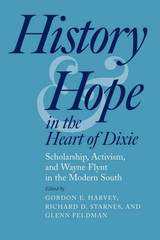 History and Hope in the Heart of Dixie: Scholarship, Activism, and Wayne Flynt in the Modern South
Edited by Gordon E. Harvey, Richard D. Starnes and Glenn Feldman
University of Alabama Press, 2006 Social and political history of the modern South. This collection of essays on the social and political history of the modern South consider the region’s poor, racial mores and race relations, economic opportunity, Protestant activism, political coalitions and interest groups, social justice, and progressive reform. History and Hope in the Heart of Dixie illuminates the dual role of historian and public advocate in modern America. In a time when the nation’s eyes have been focused by Hurricanes Katrina and Rita onto the vulnerability and dire condition of poor people in the South, the applicability of research, teaching, and activism for this voiceless element seems all the more relevant. Responding to the example of Wayne Flynt, whose fierce devotion to his state of Alabama and its region has not blinded his recognition of the inequities and despair that define southern life for so many, the scholars assembled in this work present contributions to the themes Flynt so passionately explored in his own work.Two seasoned observers of southern history and culture—John Shelton Reed and Dan T. Carter—offer assessments of Flynt’s influence on the history profession as a whole and on the region of the South in particular.
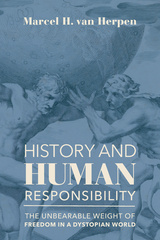 History and Human Responsibility: The Unbearable Weight of Freedom in a Dystopian World
Marcel van Herpen
St. Augustine's Press, 2023 "The present crisis is felt more acutely than previous crisis situations," observes Dutch security expert Marcel van Herpen, largely because human beings are now projecting responsibility into history on all fronts––past and future, in addition to the present. Learning from the past has become an imperative to safeguard the well-being of future generations by never repeating negative experiences, so much so that it demands an explanation of culpability into the past that burdens the present under a weight that does not properly belong to actors who did not commit the deeds of the past and have yet to decide their futures.
In a time of crisis we face the accusations of history, however distant, and are subjected to the sound of its echoing ahead of us. But, Van Herpen asks, to what exactly (or to what extent) should we listen as we strive to respond to the challenges of present day? "Is it true that history is a teacher for our lives? And has it ever been? In crisis periods this question becomes more urgent: old certainties disappear and––independently from our wishes––a new, unknown world is emerging, which seems to be at odds with our established ways of thinking and our existing value patterns."
Van Herpen scrutinizes modern European history and the post-modern man and offers the reader a compelling account of human freedom in politics, morality, and the ways in which history will or will not ever guide us into the future. He proves himself to be a very capable political scientist and sociologist, but more importantly he has now pronounced himself to be an optimistic (yet sober) observer of both human beings and history, willing to confront the present generation with possible future outcomes of contemporary crises.
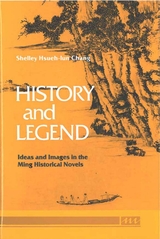 History and Legend: Ideas and Images in the Ming Historical Novels
Shelley Hsueh-lun Chang
University of Michigan Press, 1990 History, according to the Confucian tradition, was a “comprehensive mirror” for aid in government: it was part of the great Way (ta-tao), the tradition of the governing elite. Fiction, which was originally referred to as “the talk of the streets,” belonged to the small Way (hsia-tao), the tradition of the governed masses. In History and Legend: Ideas and Images in the Ming Historical Novels, Shelly Hsueh-Iun Chang maintains that the historical novels blended legends with historical fact, making them a medium of interplay between the elite and popular traditions.
This combination of influences in the historical novels was especially significant during the Ming dynasty because of the rise of both urban culture of great refinement and diversity and a popularizing vernacular designed to promote learning among all people. These two exuberant movements came together in the historical novel to propagate the difficult and complex Official Histories of the governing elite, as well as to adapt unofficial histories and fictitious narratives, thus opening the way to the influence of the common people in literature.
This book is the first study of the novels from a historical standpoint. Combining traditional historical research with new source material of the historical novels and with analytical strategies, Chang creates a three-dimensional picture of the “historical world” of the Ming people. Chang compares issues of the dynastic cycle and political legitimacy of a regime, human ambitions and immortality, ethics in the relations between historical personages and legendary heroes, ideals of government and grandiose imperial institutions, and supernatural power and the justice of history that emerged from the historical novels with those in the Official Histories and Confucian canon.
 History and Memory in the Two Souths: Recent Southern and Spanish American Fiction
Deborah Cohn
Vanderbilt University Press, 1999 It is commonplace among literary critics to refer to William Faulkner's influence on Spanish American literature. Yet few studies have delved seriously into why the attraction of the writings of this southerner has been so powerful. In this bold new study, Deborah N. Cohn addresses this question squarely, from two perspectives.
First, Cohn proposes that Faulkner's appeal derives from Spanish American authors' perception of similarities between the South's history and the experiences of their own respective nations. She delineates historical experiences common to the South and Spanish America, including civil wars, defeat and dispossession, regional marginalization, and socio-economic hardship. She also suggests that Spanish American authors found in Faulkner a set of concerns with which they could identify and that, as a result, they were inspired to take up the stylistic innovations characteristic of his writing. The resulting assimilation and adaptation of Euro-American modernism through Faulkner has been an indispensable part of what is known as la nueva narrativa, "the new narrative," as well as of successive movements in Spanish American literature.
From another perspective, Cohn's book shows points of contact between works by other southern and Spanish American novelists without positing relations of influence. Specifically, after identifying common, recurrent themes in modern southern and Spanish American literature in general, Cohn reveals levels of a shared understanding of regional history in Faulkner and Mario Vargas Llosa, in Ralph Ellison and Isabel Allende, as well as in Katherine Anne Porter and Juan Rulfo. Her analyses compare and contrast these authors' shared attempts to provide correctives to official, mainstream historical discourse through alternate, parallel strategies for reconstructing, recording, and reclaiming the past.
In yoking together the South and Spanish America as neighboring spaces with similar personalities, Cohn advances a daring and controversial thesis that both narrows and enhances the frame of comparison between the literatures of the South and Spanish America.
 History and Modern Media: A Personal Journey
John Mraz
Vanderbilt University Press, 2021 In History and Modern Media, John Mraz largely focuses on Mexican photography and his innovative methodology that examines historical photographs by employing the concepts of genre and function. He developed this method in extensive work on photojournalism; it is tested here through examining two genres: Indianist imagery as an expression of imperial, neo-colonizing, and decolonizing photography, and progressive photography as embodied in worker and laborist imagery, as well as feminist and decolonizing visuality.
The book interweaves an autobiographical narrative with concrete research. Mraz describes the resistance he encountered in US academia to this new way of showing and describing the past in films and photographs, as well as some illuminating experiences as a visiting professor at several US universities. More importantly, he reflects on what it has meant to move to Mexico and become a Mexican. Mexico is home to a thriving school of photohistorians perhaps unequaled in the world. Some were trained in art history, and a few continue to pursue that discipline. However, the great majority work from the discipline known as "photohistory" which focuses on vernacular photographs made outside of artistic intentions.
A central premise of the book is that knowing the cultures of the past and of the other is crucial in societies dominated by short-term and parochial thinking, and that today's hyper-audiovisuality requires historians to use modern media to offer their knowledge as alternatives to the "perpetual present" in which we live.
 History and Myth in Romanian Consciousness
Lucian Boia
Central European University Press, 2001 There is a considerable difference between real history and discourse history - this book stems from this idea. The author points out that history is constantly reconstructed, adapted and sometimes mythified from the perspective of the present day, of present states of mind and ideologies. Boia closely examines the process of historical culture and conscience in nineteenth and twentieth century Romania, particularly concentrating on the impact of the national ideology on history. Based upon his findings, the author identifies several key mythical configurations and analyses the manner in which Romanians have reconstituted their own highly ideologized history over the last two centuries. The strength of History and Myth in Romanian Consciousness lies in the author's ability to fully deconstruct the entire Romanian historiographic system and demonstrate the increasing acuteness of national problems in general, and in particular the exploitation of history to support national ideology.
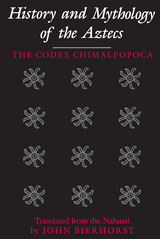 History and Mythology of the Aztecs: The Codex Chimalpopoca
John Bierhorst
University of Arizona Press, 1992 One of the great documents of colonial Mexico, the Codex Chimalpopoca chronicles the rise of Aztec civilization and preserves the mythology on which it was based. Its two complementary texts, Annals of Cuauhtitlan and Legend of the Suns, record the pre-Cortésian history of the Valley of Mexico together with firsthand versions of that region's myths.
Of particular interest are the stories of the hero-god Quetzalcoatl, for which the Chimalpopoca is the premier source. John Bierhorst's work is the first major scholarship on the Codex Chimalpopoca in more than forty years. His is the first edition in English and the first in any language to include the complete text of the Legend of the Suns. The precise, readable translation not only contributes to the study of Aztec history and literature but also makes the codex an indispensable reference for Aztec cultural topics, including land tenure, statecraft, the role of women, the tribute system, warfare, and human sacrifice.
 History and Philosophy of Modern Mathematics: Volume XI
William Aspray and Philip Kitcher, Editors
University of Minnesota Press, 1988 History and Philosophy of Modern Mathematics was first published in 1988. Minnesota Archive Editions uses digital technology to make long-unavailable books once again accessible, and are published unaltered from the original University of Minnesota Press editions. The fourteen essays in this volume build on the pioneering effort of Garrett Birkhoff, professor of mathematics at Harvard University, who in 1974 organized a conference of mathematicians and historians of modern mathematics to examine how the two disciplines approach the history of mathematics. In History and Philosophy of Modern Mathematics, William Aspray and Philip Kitcher bring together distinguished scholars from mathematics, history, and philosophy to assess the current state of the field. Their essays, which grow out of a 1985 conference at the University of Minnesota, develop the basic premise that mathematical thought needs to be studied from an interdisciplinary perspective. The opening essays study issues arising within logic and the foundations of mathematics, a traditional area of interest to historians and philosophers. The second section examines issues in the history of mathematics within the framework of established historical periods and questions. Next come case studies that illustrate the power of an interdisciplinary approach to the study of mathematics. The collection closes with a look at mathematics from a sociohistorical perspective, including the way institutions affect what constitutes mathematical knowledge.
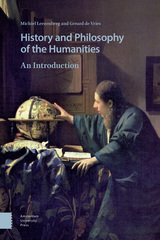 History and Philosophy of the Humanities: An Introduction
Michiel Leezenberg
Amsterdam University Press, 2018 The humanities include disciplines as diverse as literary theory, linguistics, history, film studies, theology, and philosophy. Do these various fields of study have anything in common, which distinguishes them from e.g. physics or sociology? The tripartite division between the natural sciences, the social sciences and the humanities may seem self-evident, but it has arisen only in the course of the 19th century, and has been contested ever since.History and Philosophy of the Humanities: An Introduction presents a reasoned overview of the conceptual and historical backgrounds of the humanities. In four sections, it discusses:- The most influential views on scientific knowledge from Aristotle to Thomas Kuhn;- The birth of the modern humanities;- The various methodological schools and conceptual issues in the humanities;- Some themes that set the agenda for current debates in the humanities: critiques of modernity; gender, sexuality and identity; and post-colonialism.Thus, it provides students in the various disciplines of the humanities with a comprehensive understanding of the backgrounds of their field, its relation with other disciplines, and the state of the art in the humanities at large. Intended readership: advanced undergraduate and graduate students.
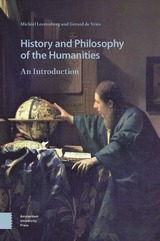 History and Philosophy of the Humanities: An Introduction
Michiel Leezenberg
Amsterdam University Press, 2019 The humanities include disciplines as diverse as literary theory, linguistics, history, film studies, theology, and philosophy. Do these various fields of study have anything in common that distinguishes them from, say, physics or sociology? The tripartite division between the natural sciences, the social sciences and the humanities may seem self-evident, but it only arose during the course of the 19th century and is still contested today.
'History and Philosophy of the Humanities: An Introduction' presents a reasoned overview of the conceptual and historical backgrounds of the humanities. In four sections, it discusses:
- the most influential views on scientific knowledge from Aristotle to Thomas Kuhn;
- the birth of the modern humanities and its relation to the natural and social sciences;
- the various methodological schools and conceptual issues in the humanities;
- several themes that set the agenda for current debates in the humanities: critiques of modernity; gender, sexuality and identity; and postcolonialism.
Thus, it provides students in the humanities with a comprehensive understanding of the backgrounds of their own discipline, its relation to other disciplines, and the state of the art of the humanities at large.
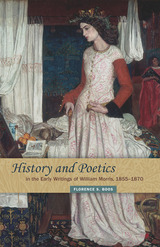 History and Poetics in the Early Writings of William Morris, 1855–1870
Florence S. Boos
Ohio State University Press, 2015 Florence S. Boos’s History and Poetics in the Early Writings of William Morris, 1855–1870 examines Morris’s literary development in the context of his Victorian contemporaries, probing the cross-influences of temperament, cultural ambiance, early reader reactions, and his restless search for an authentic poetic voice. Boos argues that to understand this development, we must understand how Morris reinterpreted and transformed medieval history and legend into modern guise. In doing so, Morris preserved a duality of privacy and detachment—the intimacy of personal lyrics and the detachment (and silences) of historical judgment.
Boos’s study is the first to utilize surviving original manuscripts, periodical publications, and poems unpublished during Morris’s lifetime. History and Poetics in the Early Writings of William Morris, 1855–1870traces Morris’s literary evolution through his juvenile poems; the essays, poems, and prose romances of the Oxford and CambridgeMagazine; the startlingly original verses of The Defence of Guenevere; and the ten years of experimentation that preceded his two best-known epics, The Life and Deathof Jason and The Earthly Paradise. This book explores the young poet’s successive efforts to find a balancing ethical framework through poetry—a framework that was at once a motivation for action and a template for authentic, shared popular art, one that reemerges forcefully in his later work.
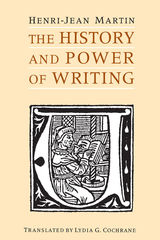 The History and Power of Writing
Henri-Jean Martin
University of Chicago Press, 1994 Cultural history on a grand scale, this immensely readable book—the summation of decades of study by one of the world's great scholars of the book—is the story of writing from its very beginnings to its recent transformations through technology.
Traversing four millennia, Martin offers a chronicle of writing as a cultural system, a means of communication, and a history of technologies. He shows how the written word originated, how it spread, and how it figured in the evolution of civilization. Using as his center the role of printing in making the written way of thinking dominant, Martin examines the interactions of individuals and cultures to produce new forms of "writing" in the many senses of authorship, language rendition, and script.
Martin looks at how much the development of writing owed to practical necessity, and how much to religious and social systems of symbols. He describes the precursors to writing and reveals their place in early civilization as mnemonic devices in service of the spoken word. The tenacity of the oral tradition plays a surprisingly important part in this story, Martin notes, and even as late as the eighteenth century educated individuals were trained in classical rhetoric and preferred to rely on the arts of memory. Finally, Martin discusses the changes to writing wrought by the electronic revolution, offering invaluable insights into the influence these new technologies have had on children born into the computer age.
 History and Presence
Robert A. Orsi
Harvard University Press, 2016 A Choice Outstanding Academic Title of the Year
Beginning with metaphysical debates in the sixteenth century over the nature of Christ’s presence in the host, the distinguished historian and scholar of religion Robert Orsi imagines an alternative to the future of religion that early moderns proclaimed was inevitable.
“Orsi’s evoking of the full reality of the holy in the world is extremely moving, shot through with wonder and horror.”
—Caroline Walker Bynum, Common Knowledge
“This is a meticulously researched, humane, and deeply challenging book. The men and women studied in this book do not belong to ‘a world we have lost.’ They belong to a world we have lost sight of.”
—Peter Brown, Princeton University
“[A] brilliant, theologically sophisticated exploration of the Catholic experience of God’s presence through the material world… On every level—from its sympathetic, honest, and sometimes moving ethnography to its astute analytical observations—this book is a scholarly masterpiece.”
—A. W. Klink, Choice
“Orsi recaptures God’s breaking into the world … The book does an excellent job of explaining both the difficulties and values inherent in recognizing God in the world.”
—Publishers Weekly
“This book is classic Orsi: careful, layered, humane, and subtle…a thought-provoking, expertly arranged tour of precisely those abundant, excessive phenomena which scholars have historically found so difficult to think.”
—Sonja Anderson, Reading Religion
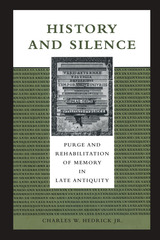 History and Silence: Purge and Rehabilitation of Memory in Late Antiquity
By Charles W. Hedrick Jr.
University of Texas Press, 2000 The ruling elite in ancient Rome sought to eradicate even the memory of their deceased opponents through a process now known as damnatio memoriae. These formal and traditional practices included removing the person's name and image from public monuments and inscriptions, making it illegal to speak of him, and forbidding funeral observances and mourning. Paradoxically, however, while these practices dishonored the person's memory, they did not destroy it. Indeed, a later turn of events could restore the offender not only to public favor but also to re-inclusion in the public record. This book examines the process of purge and rehabilitation of memory in the person of Virius Nicomachus Flavianus(?-394). Charles Hedrick describes how Flavian was condemned for participating in the rebellion against the Christian emperor Theodosius the Great—and then restored to the public record a generation later as members of the newly Christianized senatorial class sought to reconcile their pagan past and Christian present. By selectively remembering and forgetting the actions of Flavian, Hedrick asserts, the Roman elite honored their ancestors while participating in profound social, cultural, and religious change.
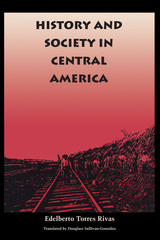 History and Society in Central America
By Edelberto Torres Rivas
University of Texas Press, 1993 First published in Chile in 1969 as Interpretación del desarrollo social centroamericano, this classic is now available in English. The first attempt at an integrated analysis of modern Central America's socioeconomic structure, Torres Rivas's work traces the social development of Central America from independence (1871) up to the 1960s. Using a dependency framework, but not limited by it, Torres Rivas describes the various divisions of Central American society and their evolution within the liberal development model that has been so much a part of the past century of Central American economic history. The book is compelling in its explanation of the relationship between foreign and native elements in the social development of the region. Torres Rivas describes and analyzes the resulting long-term problems this development has posed for Central America. With a new chapter added for the English edition, History and Society in Central America remains vital for readers interested in the region.
 History and the Climate Crisis: Environmental History in the Classroom
Kate Hawkey
University College London, 2023 A case for including an environmental focus in the secondary school history curriculum by locating its arguments within established historiographical and revisionist debates.
History education has a key contribution to make in developing a deeper understanding of the current environmental crisis, but its role is too often overlooked. When embedded in the school curriculum, environmental history adds crucial layers of knowledge to the learning from other subjects and can enable students to make their own informed contributions to one of the most pressing concerns of the twenty-first century.
History and the Climate Crisis provides much-needed environmental knowledge, an area that is new for most history teachers. The author considers the disciplinary and pedagogical challenges and demonstrates how including an environmental focus can strengthen students’ disciplinary knowledge. She also builds her argument through many examples and offers practical strategies for use in classrooms, including developed inquiries suitable for the secondary history curriculum. The book focuses on environmental history within a strong subject-bound curriculum and will be relevant to teachers, academics, and policymakers in the United Kingdom and internationally.
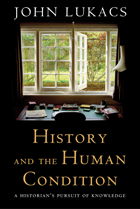 History and the Human Condition: A Historian's Pursuit of Knowledge
John Lukacs
Intercollegiate Studies Institute, 2013 “This the best introduction to the historical craft of John Lukacs . . . one of the true creative geniuses of his profession.”
—The American Conservative
In a career spanning more than sixty-five years, John Lukacs (1924–2019) established himself as one of our most accomplished historians. In History and the Human Condition, Lukacs offers his profound reflections on the very nature of history, the role of the historian, the limits of knowledge, and more.
Guiding us on a quest for knowledge, Lukacs ranges far and wide over the past two centuries. The pursuit takes us from Alexis de Tocqueville to the atomic bomb, from American “exceptionalism” to Nazi expansionism, from the closing of the American frontier to the passing of the modern age.
Lukacs’s insights about the past have important implications for the present and future. In chronicling the twentieth-century decline of liberalism and rise of conservatism, for example, he forces us to rethink the terms of the liberal-versus-conservative debate—and what true conservatism is.
Lukacs concludes by shifting his gaze from the broad currents of history to the world immediately around him. His reflections on his home, his town, his career, and his experiences as an immigrant to the United States illuminate deeper truths about America, the challenges of modernity, the sense of displacement that increasingly characterizes twenty-first-century life, and much more. Moving and insightful, this closing section masterfully displays how right Lukacs was that history, at its best, is personal and participatory.
History and the Human Condition is John Lukacs’s final word on the great themes that defined him as a historian and a writer.
“Lukacs has created a body of work unmatched by any American historian of the 20th (let alone 21st) century.” —Chronicles
“One of the more incisive historians of the twentieth century.” —Washington Times
“One of the outstanding historians of the generation and, indeed, of our time.” —Jacques Barzun, author of From Dawn to Decadence
 History and the Social Web: A Collection of Essays
August C. Krey
University of Minnesota Press, 1955
History and the Social Web was first published in 1955. Minnesota Archive Editions uses digital technology to make long-unavailable books once again accessible, and are published unaltered from the original University of Minnesota Press editions.
In this volume of twelve essays a distinguished historian demonstrates that the roots and branches of history form a continuous social web, that the events and societies of pasts eras and modern times form a complex and interlocking pattern when seen as a whole, and that a knowledge of history has a profound application to the problems and pleasures of the present. The volume includes the well-known essay, "A City That Art Built," which has long been out of print. The first group of essays is devoted to aspects of medieval and renaissance history, and those in the second section point up the continuity of the thread of world history. The essays on law, education, and medicine which form a part of the first section will be of particular interest to members of these professions.
 History and Theory after the Fall: An Essay on Interpretation
Fred Weinstein
University of Chicago Press, 1990 In this ambitious work, Fred Weinstein confronts the obstacles that have increasingly frustrated our attempts to explain social and historical reality. Traditionally, we have relied on history and social theory to describe the ways people understand the world they live in. But the ordering explanations we have always used—derived from the classical social theories originally forged by Marx, Tocqueville, Weber, Durkheim, Freud—have collapsed.
In the wake of this collapse or "fall," the rival claims of fiction, psychoanalysis, sociology, anthropology, and history have created the dilemma of radical relativism, the prospect of multiple interpretations of any complex historical event. The basic strategy of social theory and the social sciences—the search for underlying unities—proves so inherently contradictory and has provided so little in the way of reliable knowledge of social and historical relationships that to many critics it seems no longer worth pursuing.
Weinstein enters the debate by rejecting any search for underlying structural unities, dynamic or social, through which historians have attempted to find continuity with the past. He looks instead to ideological processes, to the construction of successive and changing versions of reality that mediate between the power of fantasy on the one side and the power of the social world on the other. He argues further that the need to use ideological constructs in this way accounts for the heterogeneous and changing content of social movements and for the persistent need people have always had for authoritative leaders, even in democratized societies. He suggests that people have historically been able to take a step away from leaders only by substituting the possession of objects such as property or money. This book is a breakthrough in poststructuralist theory that is sure to stimulate considerable discussion, especially about the shape of the social sciences and the future of historical interpretation.
 History and Theory: Feminist Research, Debates, Contestations
Edited by Barbara Laslett, Ruth-Ellen Boetcher Joeres, Mary Jo Maynes, Evelyn Brooks Higginbotham
University of Chicago Press, 1997 This volume of recent Signs articles offers a number of significant contributions to feminist debates on history and theory. It illustrates the uses of theories in recent feminist historical research and the often contentious arguments that surround them. The readings are organized into three sections. The first draws on the tradition of political economy, and discusses the importance of class relations for understanding historical events and social relationships and the expansion of concepts of political economy to include race. The second section, on "The Body," demonstrates how feminist scholars have increasingly worked to re-place the body, to move it from its traditionally less valued position in the hierarchal Enlightenment mind/body split to an approach that emphasizes the body as both material and discursive, both "real" and "representational." The final section, "Discourse," focuses on an examination of the productive power of language in both reflecting and shaping experience and in the contestation of social relations of power.
History and Truth
Paul Ricoeur
Northwestern University Press, 1965 In this volume, Paul Ricoeur investigates the antinomy between history and truth, or between historicity and meaning. He argues that history has meaning insofar as it approaches universality and system, but has no meaning insofar as this universality violates the singularity of individuals' lives. Imposing unity upon truth, or unifying the diversity of knowledge and opinion, creates a singular and universal history but destroys historicity and subjectivity. Allowing for singularities in history promotes a multiplicity of truths over a single, unique truth, and thereby annhilates system.
History and Truth
Paul Ricoeur, Foreward by David M. Rasmussen, Introduction by Charles Kelbley
Northwestern University Press, 2007 In this volume, Paul Ricoeur investigates the antinomy between history and truth, or between historicity and meaning. He argues that history has meaning insofar as it approaches universality and system, but has no meaning insofar as this universality violates the singularity of individuals' lives. Imposing unity upon truth, or unifying the diversity of knowledge and opinion, creates a singular and universal history but destroys historicity and subjectivity. Allowing for singularities in history promotes a multiplicity of truths over a single, unique truth, and thereby annihilates system
History and Utopia
E. M. Cioran
University of Chicago Press, 1998 In this book, Cioran writes of politics, of history, and of the utopian dream.
"A small masterwork . . . a stringent examination of some persistent and murky notions in human history. . . . It is best to read Cioran while sitting. The impact upon the intellect can be temporarily stunning, and motor systems may give way under the assault."—Joseph Patrick Kennedy, Houston Chronicle
"Cioran has a claim to be regarded as among the handful of original minds . . . writing today."—New York Times
"A sort of final philosopher of the Western world. [Cioran's] statements have the compression of poetry and the audacity of cosmic clowning."—Washington Post
E. M. Cioran (1911-1995) was born and educated in Romania and lived in Paris from 1937 until his death. He is the author of numerous works, including On the Heights of Despair, also available from the University of Chicago Press.
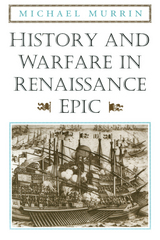 History and Warfare in Renaissance Epic
Michael Murrin
University of Chicago Press, 1994 Although the Renaissance epic was the principal literary means of representing war in its time, modern readers of the epic often lack a basic understanding of the history of warfare. Michael Murrin here offers the first analysis to bring an understanding of both the history of literature and the history of warfare to the study of the epic.
Analyzing English, Italian, and Iberian epics published between 1483 and 1610, Murrin focuses on particular aspects of warfare (cavalry clashes, old and new style sieges, the tactical use of the gun, naval warfare) and the responses to them by authors from Malory to Milton. Throughout, Murrin traces a parallel development in the art of war and in the epic as it emerged from the romance.
Murrin demonstrates that with new technology and increasing levels of carnage, the practice of war gradually drifted from traditional epic modes. But before changes in warfare completely doomed the tradition in which the epic was rooted, this crisis provoked an unprecedented range of experiment which marks heroic narrative in the late Renaissance and ultimately led to the epic without war.
A much-needed introduction to the neglected subject of warfare in epic literature, this work is an uncommonly wide-ranging exercise in comparative criticism that will appeal to historians and students of literature alike.
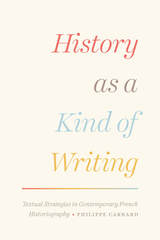 History as a Kind of Writing: Textual Strategies in Contemporary French Historiography
Philippe Carrard
University of Chicago Press, 2017 In academia, the traditional role of the humanities is being questioned by the “posts”—postmodernism, poststructuralism, and postfeminism—which means that the project of writing history only grows more complex. In History as a Kind of Writing, scholar of French literature and culture Philippe Carrard speaks to this complexity by focusing the lens on the current state of French historiography.
Carrard’s work here is expansive—examining the conventions historians draw on to produce their texts and casting light on views put forward by literary theorists, theorists of history, and historians themselves. Ranging from discussions of lengthy dissertations on 1960s social and economic history to a more contemporary focus on events, actors, memory, and culture, the book digs deep into the how of history. How do historians arrange their data into narratives? What strategies do they employ to justify the validity of their descriptions? Are actors given their own voice? Along the way, Carrard also readdresses questions fundamental to the field, including its necessary membership in the narrative genre, the presumed objectivity of historiographic writing, and the place of history as a science, distinct from the natural and theoretical sciences.
History as an Art of Memory
Patrick H. Hutton
Brandeis University Press, 1993 With a broad, interdisciplinary command of the subject, Patrick H. Hutton considers the ideas of philosophers, poets, and historians, focusing especially on the work of Giambattista Vico, Maurice Halbwachs, Philippe Ariès, and Michel Foucault. He surveys such questions as the roots of contemporary historical interest in the memory topic, the eternal paradox of repetition and recollection as moments of memory,the ways in which the art of memory has been refashioned to serce the needs of the modern age and becomes integrated into historical thinking, and historians’ changing attitudes toward the historiographical tradition of scholarship on the French Revolution.
History as Art and as Science: Twin Vistas on the Past
H. Stuart Hughes
University of Chicago Press, 1975 "Professor Hughes offers an earnest warning: 'Unless there is some emotional tie, some elective affinity linking the student to his subject of study, the results will be pedantic and perfunctory.' In other words, it is only a step from the sublime to the meticulous. Those eager to guard against that sad descent will find History as Art and as Science a guide, a tonic, and an inspiration. Its short, electrifying essays are so magnificently sane and persuasive they should be required reading for every student who contemplates a major in history."—Geoffrey Bruun, Saturday Review
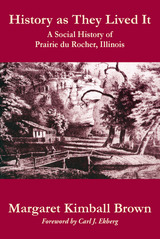 History as They Lived It: A Social History of Prairie du Rocher, Illinois
Margaret Kimball Brown, Foreword by Carl J. Ekberg
Southern Illinois University Press, 2005 “History as They Lived It deserves to be placed within the rich context of Illinois Country historiography going back more than a century. . . . It brings together the fully ripened thoughts of a mature scholar at the very moment that students of the Illinois Country need such a book.”—from the foreword by Carl J. Ekberg Settled in 1722, Prairie du Rocher was at the geographic center of a French colony in the Mississippi Valley, which also included other villages in what is now Illinois and Missouri: Cahokia, Kaskaskia, Fort de Chartres, St. Philippe, Ste. Genevieve, and St. Louis. Located in an alluvial valley near towering limestone bluffs, which inspired the village’s name—French for “prairie of the rock”— Prairie du Rocher is the only one of the seven French colonial villages that still exists today as a small compact community. The village of Prairie du Rocher endured governance by France, Great Britain, Virginia, and the Illinois territory before Illinois became a state in 1818. Despite these changes, the villagers persisted in maintaining the community and its values. Margaret Kimball Brown looks at one of the oldest towns in the region through the lenses of history and anthropology, utilizing extensive research in archives and public records to give historians, anthropologists, and general readers a lively depiction of this small community and its people.
History by Hollywood, Second Edition
Robert Brent Toplin
University of Illinois Press, 2010 This newly updated edition of History by Hollywood explores the question of what happens to history when Hollywood filmmakers get their hands on it. With a fresh look at recent films and television productions such as Titanic, Pearl Harbor, The Patriot, and John Adams, Robert Brent Toplin examines how filmmakers have interpreted American history through their movies. Toplin discusses how writers, producers, and directors become involved in making historical films, what influences their interpretations of the past, and the responses they make to the controversies their works excite. With a realistic appreciation of the challenges filmmakers face, he effectively measures the strengths and weaknesses of Hollywood's presentation of history in the films Mississippi Burning, JFK, Sergeant York, Missing, Bonnie and Clyde, Patton, All the President's Men, and Norma Rae.
 History Continues
Georges Duby
University of Chicago Press, 1994 In this engaging intellectual autobiography, Georges Duby looks back on a career that has led him to be called one of the most distinguished historians in the Western world.
Since its beginning in the 1940s, Duby's career has been rich and varied, encompassing economic history, social history, the history of mentalites, art history, microhistory, urban history, the history of women and sexuality, and, most recently, the Church's influence on feudal society. In retracing this singular career path, Duby candidly remembers his life's most formative influences, including the legendary historians Marc Bloch and Lucien Febvre, the Annales School so closely associated with them, and the College de France.
Duby also offers insights about the proper methods of gathering and using archival data and on constructing penetrating interpretations of the documents. Indeed, his discussion of how he chose his subjects, collected his materials, developed the arguments, erected the scaffolding and constructed his theses offers the best introduction to the craft available to aspiring historians.
Candid and charming, this book is both a memoir of one of this century's great scholars and a history of the French historical school since the mid-twentieth century. It will be required reading for anyone interested in the French academic milieu, medieval history, French history, or the recording of history in general.
Georges Duby, a member of the Academie francaise, for many years held the distinguished chair in medieval history at the College de France. His numerous books include The Age of Cathedrals; The Knight, the Lady, and the Priest; Love and Marriage in the Middle Ages; and The Three Orders—all published by the University of Chicago Press.
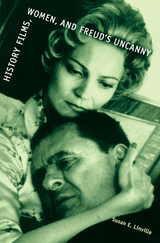 History Films, Women, and Freud's Uncanny
By Susan E. Linville
University of Texas Press, 2004 History films were a highly popular genre in the 1990s, as Hollywood looked back at significant and troubling episodes from World War II, the Cold War era, and the techno-war in the Persian Gulf. As filmmakers attempted to confront and manage intractable elements of the American past, such as the trauma of war and the legacy of racism, Susan Linville argues that a surprising casualty occurred—the erasure of relevant facets of contemporary women's history. In this book, Linville offers a sustained critique of the history film and its reduction of women to figures of ambivalence or absence. Historicizing and adapting Freud's concept of the uncanny and its relationship to the maternal body as the first home, she offers theoretically sophisticated readings of the films Midnight Clear, Saving Private Ryan, The Thin Red Line, Nixon, Courage Under Fire, Lone Star, and Limbo. She also demonstrates that the uncanny is not only a source of anxiety but also potentially a progressive force for eroding nostalgic ideals of nation and gender. Linville concludes with a close reading of a recent 9/11 documentary, showing how the patterns and motifs of 1990s history films informed it and what that means for our future.
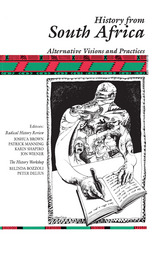 History From South Africa: Alternative Visions and Practices
Joshua Brown
Temple University Press, 1991 More starkly than any other contemporary social conflict, the crisis in South Africa highlights the complexities and conflicts in race, gender, class, and nation. These original articles, most of which were written by South African authors, are from a special issue of the Radical History Review, published in Spring 1990, that mapped the development of interpretations of the South African past that depart radically from the official history. The articles range from the politics of black movements in the nineteenth and twentieth centuries to studies of film, television, and theater as reflections of modern social conflict. History from South Africa is presented in two main sections: discussions of the historiography of South Africa from the viewpoint of those rewriting it with a radical outlook; and investigations into popular history and popular culture—the production and reception of history in the public realm. In addition, two photo essays dramatize this history visually; maps and a chronology complete the presentation. The book provides a fresh look at major issues in South African social and labor history and popular culture, and focuses on the role of historians in creating and interacting with a popular movement of resistance and social change.
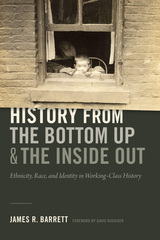 History from the Bottom Up and the Inside Out: Ethnicity, Race, and Identity in Working-Class History
James R. Barrett
Duke University Press, 2017 In History from the Bottom Up and the Inside Out James R. Barrett rethinks the boundaries of American social and labor history by investigating the ways in which working-class, radical, and immigrant people's personal lives intersected with their activism and religious, racial, ethnic, and class identities. Concerned with carving out space for individuals in the story of the working class, Barrett examines all aspects of individuals' subjective experiences, from their personalities, relationships, and emotions to their health and intellectual pursuits. Barrett's subjects include American communists, "blue-collar cosmopolitans"—such as well-read and well-traveled porters, sailors, and hoboes—and figures in early twentieth-century anarchist subculture. He also details the process of the Americanization of immigrant workers via popular culture and their development of class and racial identities, asking how immigrants learned to think of themselves as white. Throughout, Barrett enriches our understanding of working people’s lives, making it harder to objectify them as nameless cogs operating within social and political movements. In so doing, he works to redefine conceptions of work, migration, and radical politics.
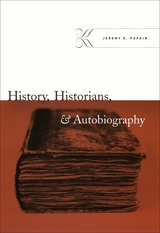 History, Historians, and Autobiography
Jeremy D. Popkin
University of Chicago Press, 2005 Though history and autobiography both claim to tell true stories about the past, historians have traditionally rejected first-person accounts as subjective and therefore unreliable. What then, asks Jeremy D. Popkin in History, Historians, and Autobiography, are we to make of the ever-increasing number of professional historians who are publishing stories of their own lives? And how is this recent development changing the nature of history-writing, the historical profession, and the genre of autobiography?
Drawing on the theoretical work of contemporary critics of autobiography and the philosophy of Paul Ricoeur, Popkin reads the autobiographical classics of Edward Gibbon and Henry Adams and the memoirs of contemporary historians such as Emmanuel Le Roy Ladurie, Peter Gay, Jill Ker Conway, and many others, he reveals the contributions historians' life stories make to our understanding of the human experience. Historians' autobiographies, he shows, reveal how scholars arrive at their vocations, the difficulties of writing about modern professional life, and the ways in which personal stories can add to our understanding of historical events such as war, political movements, and the traumas of the Holocaust.
An engrossing overview of the way historians view themselves and their profession, this work will be of interest to readers concerned with the ways in which we understand the past, as well as anyone interested in the art of life-writing.
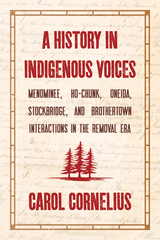 A History in Indigenous Voices: Menominee, Ho-Chunk, Oneida, Stockbridge, and Brothertown Interactions in the Removal Era
Carol Cornelius
Wisconsin Historical Society Press, 2023 A history of Wisconsin’s Indigenous past, present, and future—in Native peoples’ own words.
Treaties made in the 1800s between the United States and the Indigenous nations of what is now Wisconsin have had profound influence on the region’s cultural and political landscape. Yet few people realize that in the early part of that century, the Menominee and Ho-Chunk Nations of Wisconsin signed land treaties with several Indigenous nations from New York State. At the onset of the removal era, these eastern nations, including the Oneida Nation and the Six Nations Confederacy, were under constant pressure from the federal government and land speculators to move to lands around Green Bay and Lake Winnebago.
In this groundbreaking book, Carol A. Cornelius has compiled a careful account of these nation-to-nation treaties, in large part in the words of those Indigenous leaders who served as the voices and representatives of their nations. Drawing on a rich collection of primary sources, Cornelius walks readers through how, why, and for whom these treaties were made and how the federal government’s failure and unwillingness to acknowledge their legitimacy led to the further loss of Indigenous lands. The living documents transcribed here testify to the complexity and sovereignty of Indigenous governance then and now, making this volume a vital resource for historians and an accessible introduction to Indigenous treatymaking in Wisconsin.
Winner of the 2024 Wisconsin Historical Society’s Book of Merit Award
Finalist for the 2023 Foreword INDIES Book of the Year Award for Adult Nonfiction History
 History in My Life: A Memoir of Three Eras
Ivan T. Berend is Distinguished Research Professor at the History Department of the University of California Los Angeles.
Central European University Press, 2009 Ivan T. Berend is Distinguished Professor at the University of California Los Angeles, Director of the European Studies Program. He was one of the masterminds of regime change in Hungary. He made a career in Hungary as a university professor, Rector of the University of Economics (1973–79), and President of the Hungarian Academy of Sciences (1985–90). He was President of the International Committee of Historical Sciences (1995–2000), and Vice-President of the International Economic History Association (1986–1994). His research interests are the complex economic, social, ideological, and cultural history of Central and Eastern Europe in the 19th–20th century; economic modernization; problems of European backwardness; transition from state socialism to capitalism. He published and 26 books and more than 120 studies. Before he became a professor at UCLA, Ivan Berend had survived five regime changes and two revolutions in Hungary, had been in prison and German concentration camp in 1944–45. His memoir offers an interesting case study, a subjective addition to the “objective” historical works on Central and Eastern European state socialism. It describes the hard choices of intellectuals in a dictatorial state: 1. remain in isolation, concentrate on scholarly works, and exclude politics in your personal life; 2. be in opposition, criticize and unveil the regime, accept discrimination and exclusion; 3. remain within the establishment and work for reforming the country using legal possibilities to criticize the regime and to achieve changes from within. Berend’s book raises basic historical questions and debates, compares East European and American higher education systems, and presents an eyewitness’ insights on life in the United States.
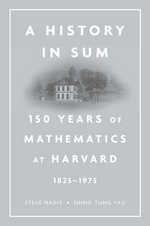 A History in Sum: 150 Years of Mathematics at Harvard (1825–1975)
Steve Nadis and Shing-Tung Yau
Harvard University Press, 2013 In the twentieth century, American mathematicians began to make critical advances in a field previously dominated by Europeans. Harvard’s mathematics department was at the center of these developments. A History in Sum is an inviting account of the pioneers who trailblazed a distinctly American tradition of mathematics—in algebraic geometry and topology, complex analysis, number theory, and a host of esoteric subdisciplines that have rarely been written about outside of journal articles or advanced textbooks. The heady mathematical concepts that emerged, and the men and women who shaped them, are described here in lively, accessible prose.
The story begins in 1825, when a precocious sixteen-year-old freshman, Benjamin Peirce, arrived at the College. He would become the first American to produce original mathematics—an ambition frowned upon in an era when professors largely limited themselves to teaching. Peirce’s successors—William Fogg Osgood and Maxime Bôcher—undertook the task of transforming the math department into a world-class research center, attracting to the faculty such luminaries as George David Birkhoff. Birkhoff produced a dazzling body of work, while training a generation of innovators—students like Marston Morse and Hassler Whitney, who forged novel pathways in topology and other areas. Influential figures from around the world soon flocked to Harvard, some overcoming great challenges to pursue their elected calling.
A History in Sum elucidates the contributions of these extraordinary minds and makes clear why the history of the Harvard mathematics department is an essential part of the history of mathematics in America and beyond.
|
|

